
Navigation Lights for Sailboats (And How To Read Them)

Last Updated by
Capt Chris German
June 15, 2022
Navigation lights on a sailboat can be confusing. If you understand the reason behind why they are the way they are however, they can make a lot more sense.
At their heart, sailboats are really just a power boat and as such must adhere to all power boat rules such as navigation lights. Other times however, a sailboat is classified in a special category. They have a set of additional lights they CAN show as an option, but are not always required to do so.
That’s about as clear as mud if you ask me and I contend that that is where the confusion about lighting a sailboat begins.
Just because you can show a light to identify yourself in times of low visibility, does not mean you have to and then we add in a little sibling rivalry between power and sail and things get downright adversarial when it comes to navigation and the night.
Table of contents

The USCG says You’re a Power Boat Whether You Like It or Not
Much to the consternation of many a sailor who has earned a commercial license to drive their sailboat, when you received your credential from the USCG it says you are a master of steam and power across the top with no mention of wind as a source of propulsion.
It is not until you read the back pages of your little red book that feels like a passport and looks like a US Sailing credential, that you will see the term “sail auxiliary”. That is because most of the time the U.S. Coast Guard knows that you are primarily reliant on your mechanical power to propel your vessel.
It's a sad thing, but the days of commercially viable sail boats are done and all but the most select few even have sails let alone use them as their primary power source. All sail boats by law are powerboats, but not all powerboats are sailboats.
Navigation Lights for a Power Boat
As a power boat, you are required to show certain lights and have been required to do so before power was even invented.
In the days of man powered vessels like the viking ships who relied on oars while in close quarters to power their vessels, they needed to show other boats, friend or foe, where they were by showing lanterns in the dark to identify themselves. As you know, it is a time honored rule among all the nations of the world both past and present, that you must avoid a collision at all costs while at sea and even the viking knew that you should not run into things.
By lighting the front and back of your boat, you could warn other boats of your presence as well as identify which way you were heading. As such there is a very specific rule in the Code of Federal Regulations Number 46 (CFR46 by common name) that spells out with detail how many, the color, the luminosity or brightness, the angle of visibility and the location of all of the lights required for navigation on every single boat, seaplane, submarine and other nondescript vessel conceived by man to date that they must show while underway in reduced visibility.
And there is no flexibility in the rules.
As such a power boat, and by extension all sailboats, MUST, without question show one green light on the starboard bow and one red light on the port bow and one all around white light or lights while operating in reduced visibility. These lights should shine at all 360 degrees of visibility with the bow lights shining at an angle of dead ahead to 22.5 degrees abaft the beam and the stern lights shining 225 degrees dead aft. A forward facing masthead light that is white in color shall shine forward to comply with the directive that all vessels must carry an all around white light. For more read here .
As you can see, there isn’t much wiggle room when it comes to lights that must be shown.
Sailboats get a little flexibility with lights
Sailboats however, are a little different when they are in fact sailboats, which is only when you are entirely reliant on the wind for power and in no way reliant on any mechanical or manual means of propulsion. And for good reason.
Back in the day when men were men and sailboats were wooden, fire was a major concern. Sails were coated with wax and other flammable substances and the wood on boats was saturated with oils and grease. Even the ropes were plant materials saturated with oils to keep them pliable and strong.
Add those highly flammable substances to a parching environment like the sea and you had what was essentially a giant floating tinderbox.
Then tell that giant floating tinderbox that they need to identify themselves to the world at large at night using oil lamps with flames because batteries and lights were not invented yet. It didn't take very long or very many ships burning to the water line for the Governments to say to the sailboats, you get to do things a little different.
As such, sailboats are given special dispensation when it comes to lights aloft. They don't have to show an all around white light in their rigging because no one wanted to set their rig on fire with oil lamps 60 feet up in their rig.
However, when a sailboat takes their sails down such as when they are powered or at anchor, they must resume the display of an all around white light or lights aloft. That became a real challenge with aluminum masts and the disappearance of rat lines on the shrouds because there was no easy way to climb the rig and check the bulbs up the mast on a regular basis.
Red over Green Sailing Machine
I have no idea where the history of this particular light comes from, but if you ever take a deck exam with the USCG, you better remember this mnemonic. An all around red light over an all around green may be displayed on a vessel during times of reduced visibility to indicate that a vessel is operating under sail power alone.
I won’t even speculate on how or why they came up with this particular light configuration, but if you want to use these lights as a sailing vessel, you can do so, but that means that you will need three all round lights at the top of your mast, an all around white, an all around red and an all around green, just in that order.
The red over green is to be displayed in addition to the running lights or the red and green bow lights with the 225 degree stern light. As always, when the motor comes on, so does the steaming light or the forward facing white light that is also usually about ¾ of the way up on your mast to complete the requirement of an all around white light that indicates a power vessel.
What is a “steaming light” and why are you mentioning it now?
Most sailboat electrical panels will have a switch that is labelled “steaming light” and it will only come on when your anchor light is off. This is probably the most confusing part of sailboat navigation lights so if you are confused about this, you're in good company as most people are.
A “steaming” light is named thusly, going back to the days of steam powered sailboats where when they fired up their boilers and doused the sails, they became a power boat once again. There aren’t too many steam powered boats, let alone steam powered sailboats, but the name stuck and it is a vestige of a bygone era.
Either way, when you fire up your motor, you turn on your “steaming light” and that locks out the all around white light which is used for anchoring to minimize the number of switches on your panel and reduce the number of wires in your mast. The fewer wires, the less chance of something not working or becoming disconnected.
The steaming light and the anchor light both go up the mast, but you can’t use an all around white light while using the 225 degree stern light at the deck level because to other boaters you would look like you have two white lights from the stern and that would be confusing.
The anchor light is used exclusively for anchoring while the steaming light is used to indicate you are a power vessel while underway.
As to why I am mentioning it now in the article, is because this would have blown your mind if I started with this subject cause it can be really confusing stuff.
Aspect Recognition with Lights
Remember when I said earlier that lights can help you tell others which way you are heading as well as tell you which way other boats are heading? That is called the aspect of the vessel and the USCG tests you on this for your deck exam as well.
Knowing that the bow lights go 22.5 degrees abaft the beam on both sides or 112.5 degrees on each side, and the stern light faces 225 degrees aft for a total of 360 degrees of visibility, you can tell a lot about where a boat is heading and who has the right of way.
One thing that's easy to remember is red means stop and if you see a vessel's red light, it means stop as you are the give way vessel and approaching the other vessel from his port side. Conversely it works with green as well as that means you are approaching from the other vessel's starboard side and you are the standon vessel.
If you see a red and green light equally low on the horizon, that means your heading dead on into another vessel's path and conversely if all you see is a white light low on the horizon, it means you are overtaking another vessel power or sail, we don’t care because it is an overtaking situation. However, any time you do see a white light aloft in addition to the red and green bow lights, you know you are encountering a power boat.
Then there are angular approaches as well, where you see white and red or white and green light low on the horizon. You know in that case you are seeing a portion of the bow lights and stern lights from the side approaches of a vessel. Based on which direction those lights are heading, you can deduce which way that boat is going in relation to your boat.
So put it all together and you see a green light and a white light low on the horizon with a red over green light aloft, you know that you are approaching a sailboat that is traveling to your port and that might make you the standon vessel. That is of course, if we didn’t concern ourselves with windward and leeward and port tacks and starboard tacks, but that is a discussion for another article. So stay tuned when we talk about sailing rules and the right of way. But for now, do good, have fun and sail far.
Related Articles
Capt Chris German is a life long sailor and licensed captain who has taught thousands to sail over the last 20 years. In 2007, he founded a US Sailing-based community sailing school in Bridgeport, CT for inner city youth and families. When Hurricane Sandy forced him to abandon those efforts, he moved to North Carolina where he set out to share this love for broadcasting and sailing with a growing web-based television audience through The Charted Life Television Network.
by this author

Most Recent

What Does "Sailing By The Lee" Mean?
Daniel Wade
October 3, 2023

The Best Sailing Schools And Programs: Reviews & Ratings
September 26, 2023
Important Legal Info
Lifeofsailing.com is a participant in the Amazon Services LLC Associates Program, an affiliate advertising program designed to provide a means for sites to earn advertising fees by advertising and linking to Amazon. This site also participates in other affiliate programs and is compensated for referring traffic and business to these companies.
Similar Posts

How To Choose The Right Sailing Instructor
August 16, 2023

Cost To Sail Around The World
May 16, 2023

How To Drive A Pontoon Boat
Jacob Collier
December 19, 2022
Popular Posts

Best Liveaboard Catamaran Sailboats
December 28, 2023

Can a Novice Sail Around the World?
Elizabeth O'Malley

4 Best Electric Outboard Motors

How Long Did It Take The Vikings To Sail To England?

10 Best Sailboat Brands (And Why)
December 20, 2023

7 Best Places To Liveaboard A Sailboat
Get the best sailing content.
Top Rated Posts
Lifeofsailing.com is a participant in the Amazon Services LLC Associates Program, an affiliate advertising program designed to provide a means for sites to earn advertising fees by advertising and linking to Amazon. This site also participates in other affiliate programs and is compensated for referring traffic and business to these companies. (866) 342-SAIL
© 2024 Life of Sailing Email: [email protected] Address: 11816 Inwood Rd #3024 Dallas, TX 75244 Disclaimer Privacy Policy
Boat Navigation Lights Rules: Illustrated Beginners Guide
When navigating at night, the lights on other boats are your first clue about the moving dangers around you. And your navigation lights are your first line of safety in avoiding collisions in the dark, and they tell others vessels what you are and what you are doing. The rules sound complex, but with a little understanding you can get the basics for any situation.
So what are the basic navigation light rules? For most small vessels, motoring requires red and green (port and starboard) lights, and a white light visible in all directions around the boat. This is almost always a stern light and a masthead light on sailboats. Boats under sail require port and starboard lights, and a white stern light. Sailboats below sixty-five feet may show a tricolor light at the masthead instead of side and stern lights when sailing.
That's it, in a nutshell. There's a little more to it, as the rules change with different sizes and there are some specifics about angles of display for the colors. Identifying other ships at sea requires more study, but the basics are the same. And it's not much trouble to make sure you've always got the proper lights on your vessel.
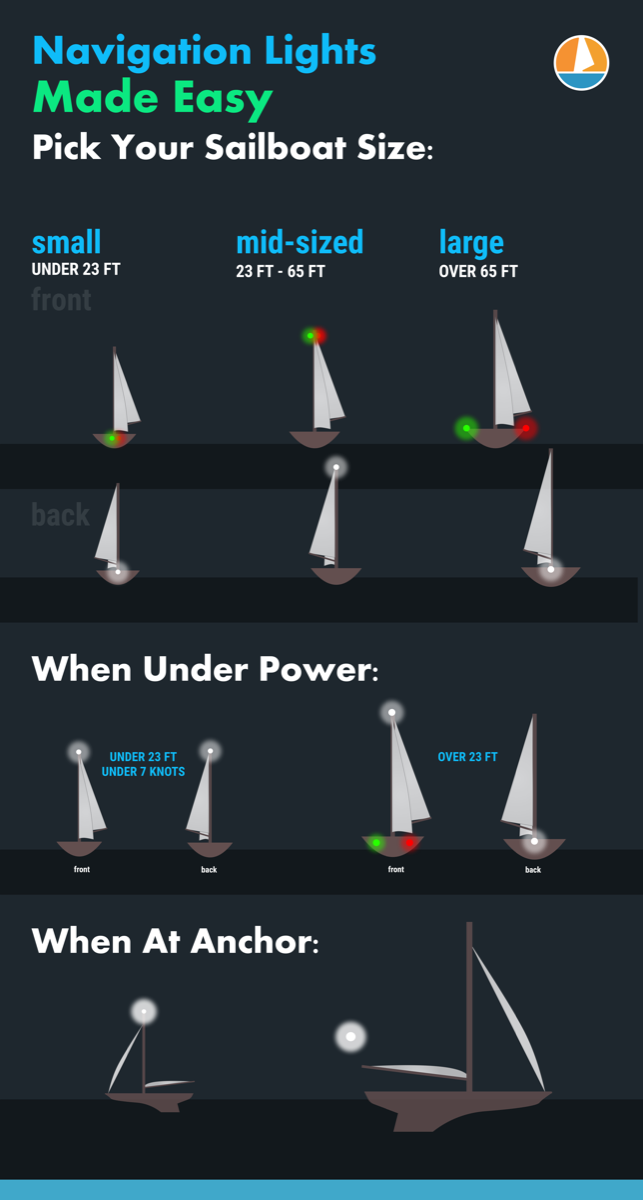
On this page:
What are the official colregs rules for your sailboat, what about the uscg (united states coast guard) rules, lighting at anchor, identifying the boats around you.
The International Regulations for the Prevention of Collision at Sea , abbreviated "COLREGS" is very specific about the lights required, their shapes and sizes, and the distance they must be visible. For the smaller boat, the following definitions apply.
- Masthead Light - a white light placed centerline on the boat showing an arc of 225 degrees with 112.5 degrees either side of the front of the vessel.
- Sidelights - A red light on the port side and a green light on the starboard. They must show an arc of 112.5 degrees from centerline of the bow.
- Stern light - A white light on the stern of the boat showing an unbroken arc of 135 degrees from centerline of the vessel.
- All-round light - A light showing in an unbroken arc of 360 degrees.
The good news is you need not measure these angles. Any properly installed USCG or COLREGS approved light which will cover the correct arcs. If you have to replace the original light from your boat, make sure it's with an approved replacement.
Lights When Sailing
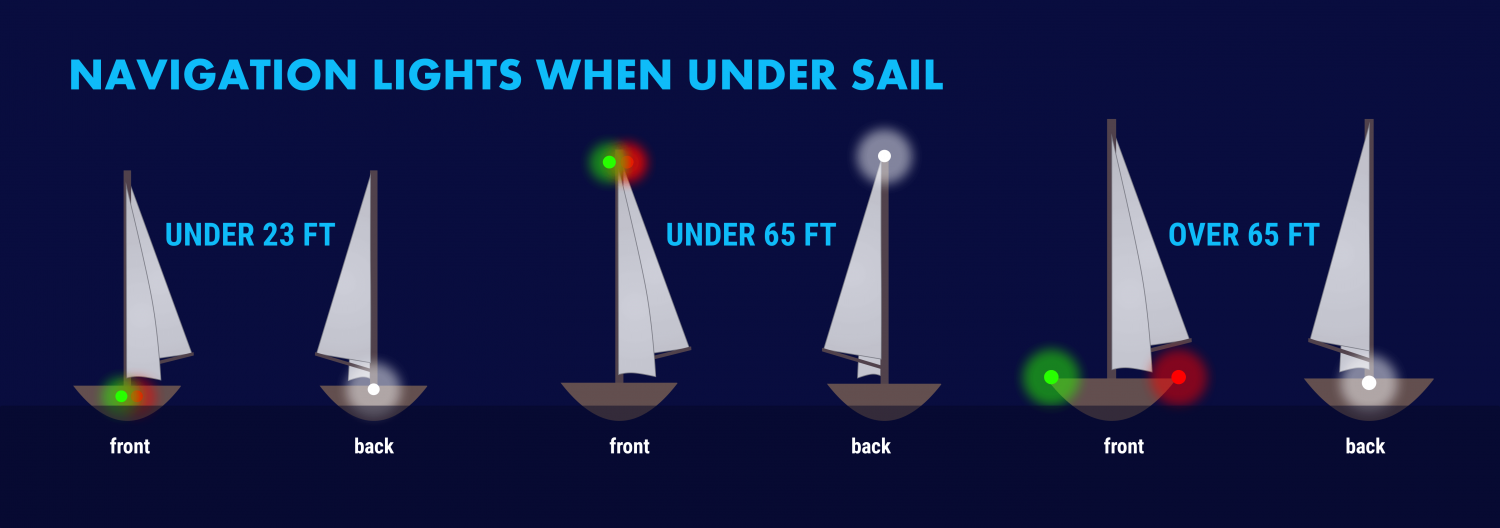
The specific rules for a sailboat under sail are in COLREGS Rule 25 and vary slightly with the size of the boat. A sailboat powering is considered a power boat and falls under in Rule 23.
- Under 23 feet (7 meters) - side lights and a stern light, possible. If these lights can not be displayed a light must be kept at hand to help avoid a collision. This can be a bright flashlight.
- Over 23 feet - Side lights visible to one nautical mile and stern light visible for two.
- Vessels under 65 feet may combine both sidelights into a single lantern on the bow.
- May show a tricolor light on the masthead instead of sidelights and a stern light. It's one or the other though, do not show these lights at the same time .
- Masthead light must be visible for three nautical miles, all other lights must have a two nautical mile visibility.
- Side lights must be separated.
- May not show a masthead tricolor light.
- Masthead light must have five nautical mile visibility, all other lights must be visible for two nautical miles.
- Optional masthead lights - any vessel under sail may display a red light over a green light at the masthead with sidelights and stern light. The red over green may NOT be displayed with a masthead tricolor light. It's one set or the other.
Lights When Motoring
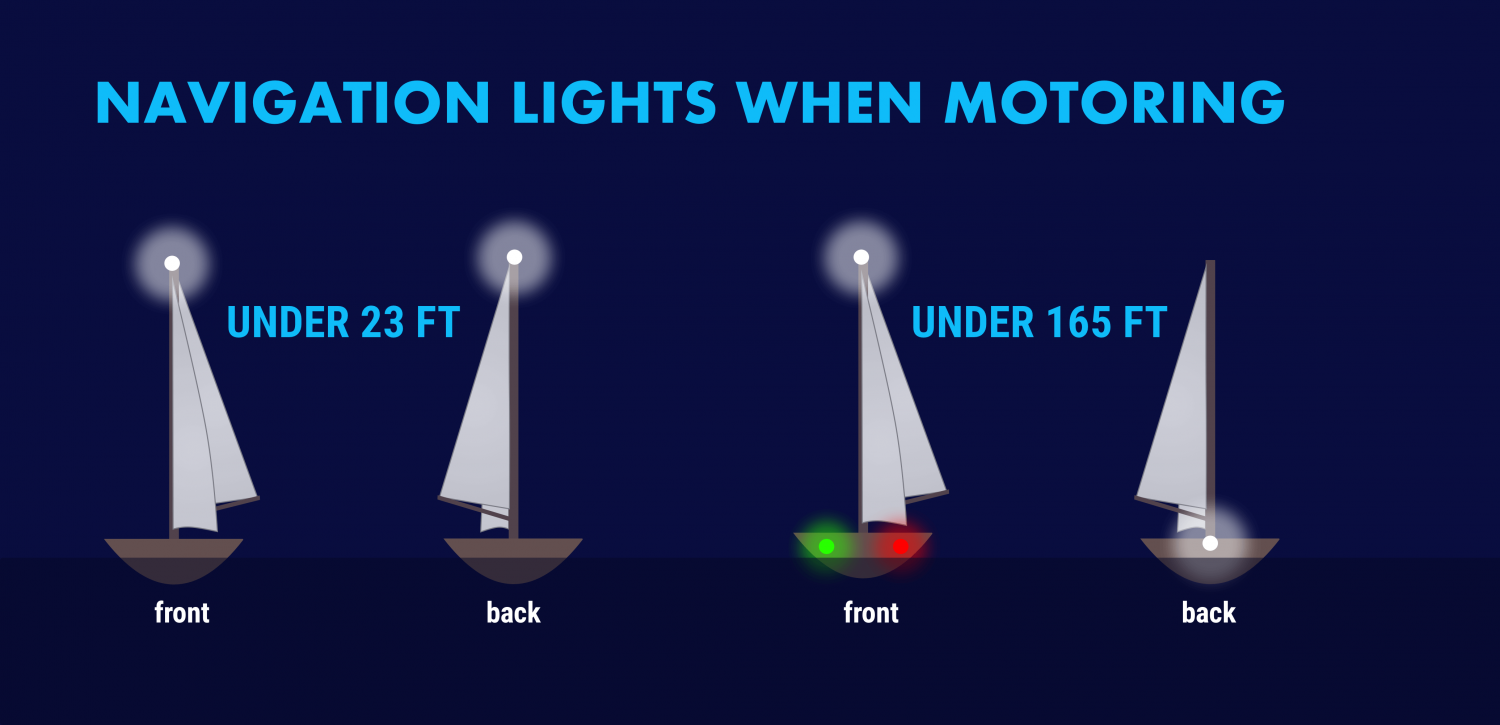
For all navigational purposes a sailboat under power is considered a power boat. This includes motor sailing - if the engine is on and providing propulsion you are on a power boat, even if the sails are up . This applies to navigation lighting, sound signals in fog and limited visibility, and rights of way.
Sailboats under 50 meters under power need to show:
- A masthead light
- Stern light
A power-driven vessel under 23 feet (7 meters) that does not exceed seven knots of speed may display an all around white light, though sidelights should be used if available.

The USCG has published its own "Rules of the Road" that are based on the COLREGS. In addition, it has rules for the "Inland Waterways" for rivers, inland lakes and the Great Lakes.
The good news is this has no impact on what you have to do with your own boat.
They mostly relate to lighting changes on towed vessels like barges and tugs. For example, a vessel towing or pushing another vessel in the ocean under COLREGS shows two masthead lights, sidelights and a stern light, whereas in Inland Waterways the towing or pushing vessel displays two yellow towing lights instead of a white stern light.
If you sail on lakes, rivers or the Great Lakes where towed commercial traffic is common you should learn the inland lights, but coastal or ocean sailors will never see these.
When you anchor outside a designated mooring field, you should display an all around white light at the masthead or as high in the boat as practical.
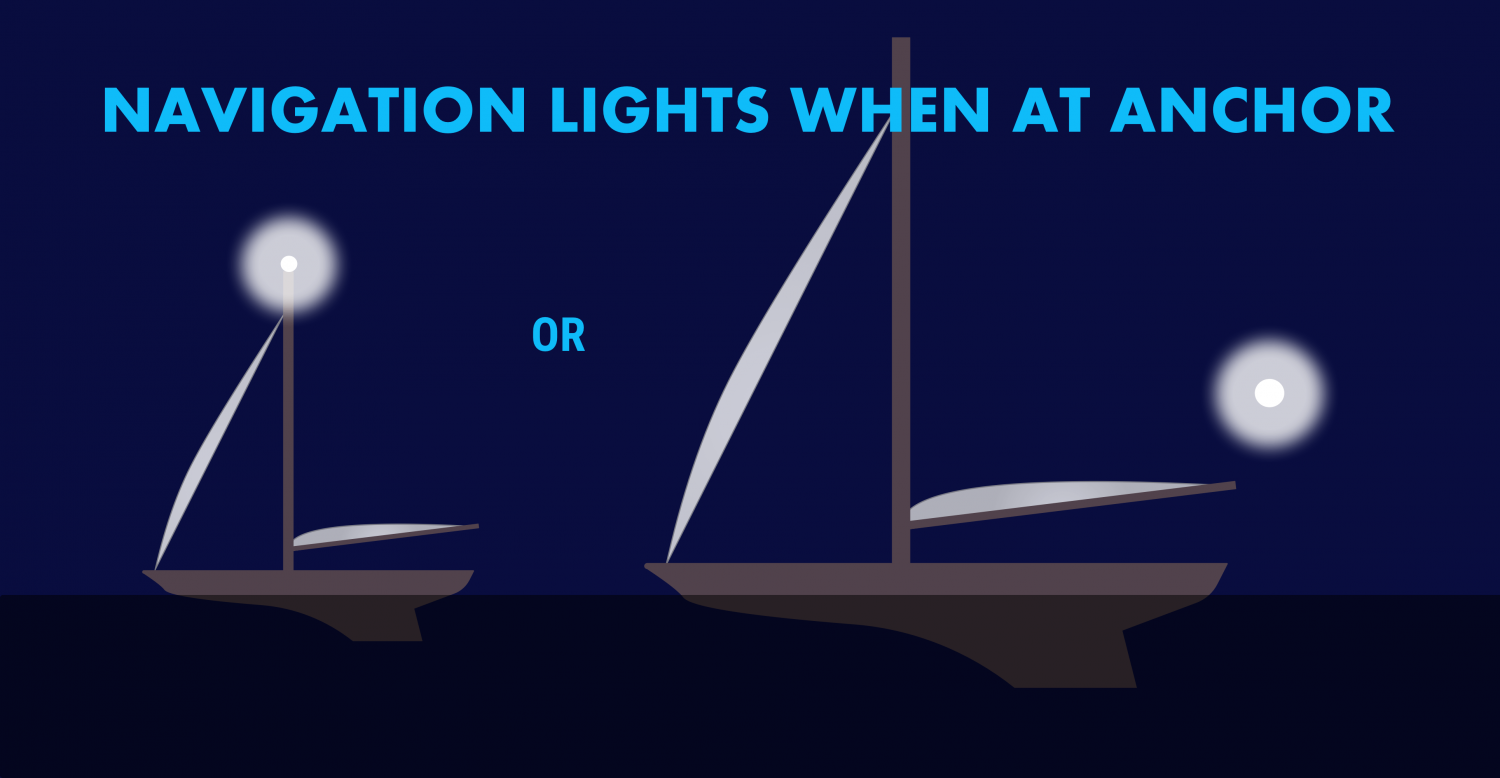
If your boat is large and has a very tall mast, you may wish to display another light closer to the waterline. Boats approaching in the dark may not see a light on a mast sixty or seventy feet in the air when they are close to your boat.
We use a simple garden path light on our stern when we anchor, left in a rod holder or flag socket. It comes on automatically at dusk and is a cheap and easy way to be more visible. There is no specific rule stating you can not display more lights than required, or the nature of any lights beyond the required all around light.
The COLREGS also specify that a round black "daymark" should be displayed in the rigging of any vessel at anchor. Very few small vessels observe this, however it is the correct display for a vessel in an anchorage.
If you tie to a mooring in a marked mooring area you are not required to display anchor lights, but there is no harm in doing so.
The other important reason to know your lights is to figure out what's going on around you at night. The water may be ablaze with white, red, green and other lights at night and they are your first key to avoiding collisions and problems.
All combinations of lights for fishing boats, commercial vessels, and so on are outside this post‘s scope. The odds are small you will encounter a submarine, seaplane or hovercraft at night, but there are regulations regarding specific lighting for each of those vessels!
There are a few fundamentals to help you figure out what that is you see on the horizon, which way it is going, and whether it is a danger to you.
Port Wine is Red
The fundamental rule is that red sidelights will ALWAYS be on the port side of a vessel, and green lights will always be on starboard. However, some vessels can use all around red and green lights for other purposes, though those will be higher than sidelights.

The light‘s on a ship is not important, some large tankers and freighters will have their sidelights far aft and put them on the superstructure for better visibility. It is not safe to assume that sidelights you can see are on the bow of large vessels .
When you can see the color, you know which way the bow is pointing. If it's red, it's pointing more or less to the left and will travel in that direction. A green light shows it is heading more or less to your right.
If you can see the red and green lights at the same time, you are looking directly at the bow of the vessel. When you are far away, this isn‘t as alarming as if you are close crossing. Seeing red and green lights together on a vessel is something you never want to see for long.
Be aware of red and green lights used in combination with other red, green and white lights. These may not be running lights and could have other significance.
Tankers, Freighters and Large Ships
Tankers, freighters and large ships will have side lights, a stern light and a masthead light. In addition, on vessels over 50 meters there will be a second masthead light further aft and higher than the forward light. The masthead light positions are a better tipoff to the bow direction and how far from the bow the sidelights might be. Remember - on a large vessel the sidelights may not be at the bow or even close to it.
USCG Inland Rules allow for a second all-around white light on large vessels on the Great Lakes instead of a second masthead light.
Fishing Boats
Fishing boats engaged in fishing will have more complex light displays. When they aren't fishing, they will show lights like any power vessel, but Rule 26 spells out light combinations that vary by the fishing activity being done. In general:
- Boats which are Trawling but not making headway will display a green all-around light over a white all-around light , and a masthead light aft of these lights. Boats making headway while trawling will show these lights, plus sidelights and a stern light.
- A vessel fishing other than trawling will show a red all-around light over a white all-around light . When making way they will also show sidelights and a stern light.
- If a vessel has gear more than 150 meters away from the boat, it will show a second all around light in the direction of the gear. The best rule is to give fishing boats as wide a berth as you can at night. They're easy to pick out if you check the top light configurations but their course may be difficult to predict.
Towing and Pushing
Towed vessels can be the most dangerous to cross, but they have the most lights to tell you what is happening. Refer to COLREGS or the USCG Rules of the Road Rule 24 for all combinations You can pick a tow/push vessel out with the following lights:
- Two or three masthead lights in a vertical line. Three masthead lights shows a tow over 200 meters. Additional masthead lights may show for larger tow vessels.
- A towing light (yellow light with the same characteristics as a stern light) directly above the stern light.
- The will also have side lights and a stern light.
- The towed vessel will show sidelights and a stern light. Lighting may vary under USCG inland rules, where towing lights may replace stern lights. Learn these differences if this is your regular cruising ground. If you think there is a tow ahead of you, always go well behind the aft most set of lights. Never go between a tow and avoid crossing ahead if possible as it may restrict their maneuverability.
Special Situations
There are several rare situations you may encounter. As a general rule, if there are a lot of lights and you don't understand them look for the sidelights on a moving vessel. If you can find them and figure out the direction it is moving, it makes the vessel easier to avoid. Stay well clear of lights you do not understand if you can avoid them without risk.
Most of these signals are used by larger, commercial vessels and you will not need them.
They use these light combinations with other light combinations. For example a towing vessel may also be restricted in maneuverability, and a vessel constrained by draft will show running lights if moving.
- Not Under Command - two all around red lights in a single line
- Restricted in Ability to Maneuver - red, white then red in a single line
- Constrained by draft - three all around red lights
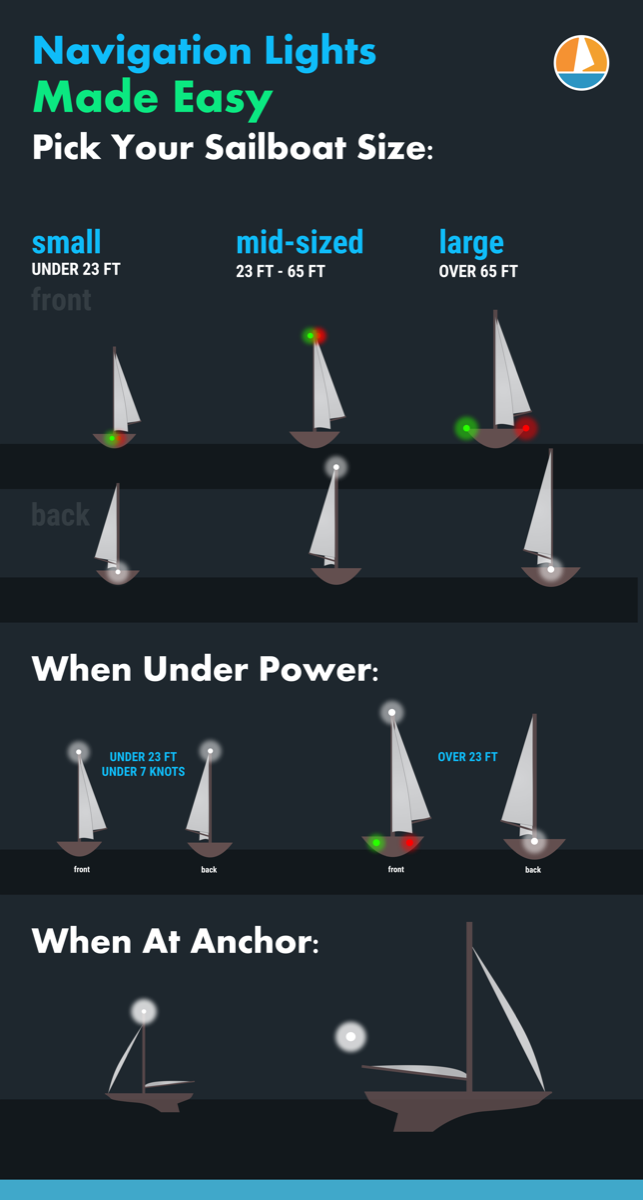
Leave a comment
You may also like, 17 sailboat types explained: how to recognize them.
Ever wondered what type of sailboat you're looking at? Identifying sailboats isn't hard, you just have to know what to look for. In this article, I'll help you.

The Ultimate Guide to Sail Types and Rigs (with Pictures)
Own your first boat within a year on any budget.
A sailboat doesn't have to be expensive if you know what you're doing. If you want to learn how to make your sailing dream reality within a year, leave your email and I'll send you free updates . I don't like spam - I will only send helpful content.
Ready to Own Your First Boat?
Just tell us the best email address to send your tips to:
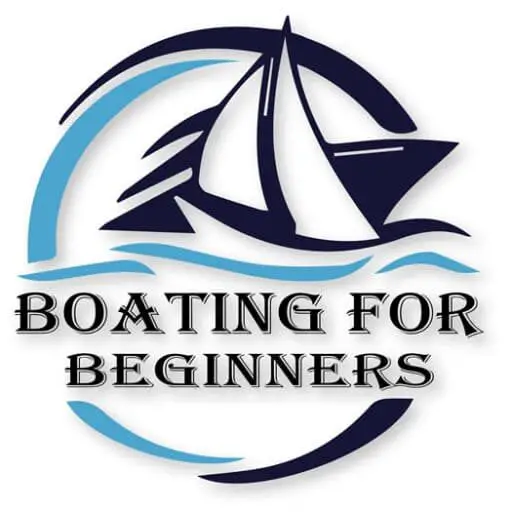
Boat Lighting – Complete Guide to Navigation Lights
I was sitting in the garage the other day admiring my boat when I noticed the green navigation light on the side of the hull, and it dawned on me that I haven’t had the boat out after sunset yet. It also got me wondering about the different places I’d like to travel this summer and what it would be like to navigate in the dark if I had to.
In addition to the legally required lights, I highly recommend having a marine waterproof spotlight in your boat at all times ( this is the one I prefer, which you can buy on Amazon with tons of good reviews ). The little headlight on a boat is nowhere near bright enough to safely navigate if you get caught on the water at night. Trust me, it can save you thousands in boat repairs and a dangerous situation.
I wanted to make sure that I fully understood everything there was to know about navigation lights, so I did some online research. I’ve put together a complete guide of the information I found online talking about the different navigation lights and what I needed to know about them.
What Are Navigation Lights On a Boat?
Boats require specific lighting configuration when operating between sunset and sunrise, or at times when visibility is restricted such as when it’s raining or foggy. Navigation lights are used to help other boaters see you when visibility is reduced, and it allows you also to see the other boaters to avoid collisions.
Navigation lights are also used to communicate with the other boats sharing the water. For example, the navigation lights can tell another boater, what size your vessel is, and in which direction you are heading. This information can be used by the boat caption to determine what the appropriate course of action would be as you approach each other.
By law, the navigation lights come in specific colors; white, red, and green. Even the arc of the illuminated light, the range of visibility, and the location is all specific to what type of vessel you are operating.
Do not assume that your boat came with the appropriate lighting or equipment from the factory or showroom. It is your responsibility to make sure that your boat has the proper navigation lighting configuration before you head out on the water.
What Type Of Boats Requires Navigation Lights?
Basically, in a nutshell, all boats require navigation lights if you’ll be operating them between sunset and sunrise, or whenever visibility is reduced.
This goes for the following types of vessels:
- Motorized vessels
- Non-motorized vessels
- Sailing vessels (Operating under sails)
- Sailing vessels (Operating under motor power)
- Vessels engaged in fishing
- Vessels engaged in trawling
- Towing vessels
- Anchored vessels
- Human-powered vessels such as Rowboats (Kayaks and canoes)
What Lights Are Required On a Boat?
Boats are required to have navigation lights. Navigation lights are required whenever you are operating your vessel between sunset and sunrise, or during any other times when your visibility is restricted from elements such as fog or rain.
The type of lights required depends on the length of your vessel as well as if it’s a powered or non-powered vessel. But in general, all navigation lighting systems will consist of red and green sidelights, as well as one or more white lights. A red sidelight indicates the port side of the vessel, while a green light shows the starboard side of the vessel. The white light in most cases is called an all-around light, which means it can be seen from any angle by other boaters.
Another type of navigation light is a yellow light. A yellow light is not very common to see, but if you do happen to see one, it would mean that a lead boat is towing another boat.
It is your responsibility to make sure you have the proper navigation lighting. It is also recommended that you take spare bulbs with you. The USCG doesn’t care if the lights were working when you left, they only care that the lights are not working when they are required.
Lights Required For Power Vessels Underway:
A powered vessel includes all motorized boats, including sailboats that use a motor.
Vessel length: Under 12 meters (39.4 FT.) Lighting requirement:
- One all-around white light that is visible at 360 degrees, and can be seen from two miles away. The all-around white light must be mounted at least 39 inches above the side lights.
- A pair of red and green sidelights that are visible 112.5 degrees and can be seen at least one mile away.
Vessel length: 12 meters to 20 meters (39.4 FT. to 65.6 FT.) Lighting requirement:
- A white masthead light located at the front of the boat, pointing in the direction you are traveling. This must be visible at 225 degrees and from two miles away. The masthead light must be positioned at least 8 feet above the gunnel.
- A white stern light located at the rear of the boat that is visible at 135 degrees and can be seen from 2 miles away.
Lights Required For Non-powered Vessels Underway:
A non-powered vessel includes sailing vessels and all other types of vessels that don’t have motors such as paddled, poled, or rowed.
Vessel length: Under 7 meters (23 FT.) Lighting requirement:
- You are required to display a white light that can be seen by other boats. White light could consist of a flashlight, torchlight, or lantern.
- If you can, it is recommended that you have an onboard 360-degree white light all-around set on the horizon, with a distance of at least two miles.
Vessel length: Over 7 meters (23 FT.) – NEED 3 IMAGES Lighting requirement:
- A pair of red and green sidelights, that are visible 112.5 degrees and can be seen at least one mile away.
- Alternatively, for sailboats of that are over 7 meters in length, they can display what is called a tricolor light A tricolor light can only be used while the vessel is underway using sails alone and never while underway by power. This light should also never be used at the same time that the regular sidelights are on. Either the tricolor light or sidelights can be displayed, but never both.
Lights Required For Vessels At Anchor (Less Than 50 Meters):
This rule applies if you are anchored away from a designated area such as a marina.
Vessel length: 12 meters to 20 meters (39.4 FT. to 65.6 FT.) Lighting requirement:
- White all-around light is required to be used so you are visible to other ships that could be in the area.
Due to variances in state boating laws/regulations, NASBLA does not provide state-specific information. You may contact your state boating office for the most accurate information. Contact information can be found here: https://www.nasbla.org/about-nasbla/boating-contacts .
Understanding The Difference Between Port And Starboard Lights
While standing on the deck and facing the front of the ship, the left side is called the Port and the right side is called the Starboard. The port is always red , while the starboard is always green .
This information is crucial to understand if you ever find yourself trying to navigate the waters at night or while your visibility is limited. For example, if you are sailing towards another vessel, you will be able to tell if that vessel is heading towards you, or if it is heading away from you based on which side the green and red lights appear to you.
If you see a red light coming towards you, that would mean the other boat is on your right, which means that boat would have the right of way. If you see a green light from an oncoming vessel than you would know that it’s on your left, which means you have the right of way.
When Should Navigation Lights Be Displayed On a Boat?
Navigation lights are required to be displayed in between sunset and sunrise, and anytime that visibility is restricted. For example, due to fog or rain.
Where Can You Buy Navigation Lights?
As discussed earlier, not all boats automatically come with the proper display of navigation lights. It is your responsibility to ensure that your boat has all of the proper equipment for your safety and the safety of others.
The prices for navigation lights will vary anywhere between $9.00 to $100.00 depending on what style and manufacturer you buy. You could even spend as much as $500.00 on some of the higher-end navigation lightings. Be sure to shop around and take a look at what is available, to ensure that you are finding the best lights, at the best prices.
Definitions
All-Round Light: White (32pt/ 360°) Masthead Light: White (20pt/ 225°) Sidelights: Red (10pt/ 112.5°) & Green (10pt/ 112.5°) Stern Light: White (12pt/ 135°)
Similar Posts
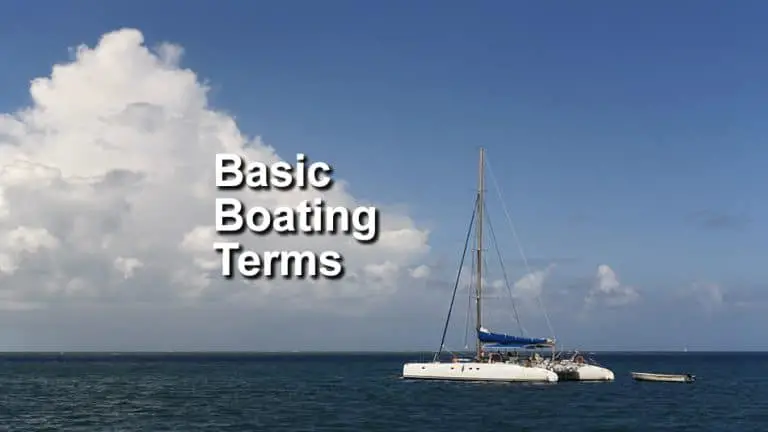
Basic Boating Terms That Beginners Should Learn
It’s always fun and exciting to go on a boating trip, but this does come with its fair share of challenges. The idea is to know precisely how to control your boat and get it to the desired fishing location. That’s why it makes a lot of sense to learn as many boating terms as…

Helpful Tips For Towing a Boat
Every boat owner knows that being able to take your boat everywhere you want is a privilege and a great way to spend your time. However, there are specific rules you have to abide when you want to tow a boat. Some states require special trailer brakes especially if the boat has more than the…
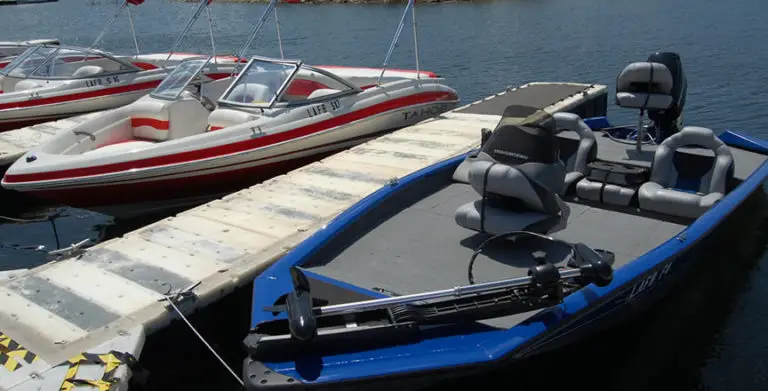
Best Boats For Beginners
This post is a beginners guide to buying your first boat. When I first started to dig deep into the research and figure out what the best types of boats for beginners were, I had no idea that there were so many different types of boats to choose from. There are so many different choices…

Starting Boat Motor Out Of Water
I’ve heard a lot of boaters talking about how they start their inboard or outboard engine while the boat is on land so they can test the motor before they have it on the boat launch. That got me wondering how safe it could be for the engine, so I did some research. As it…
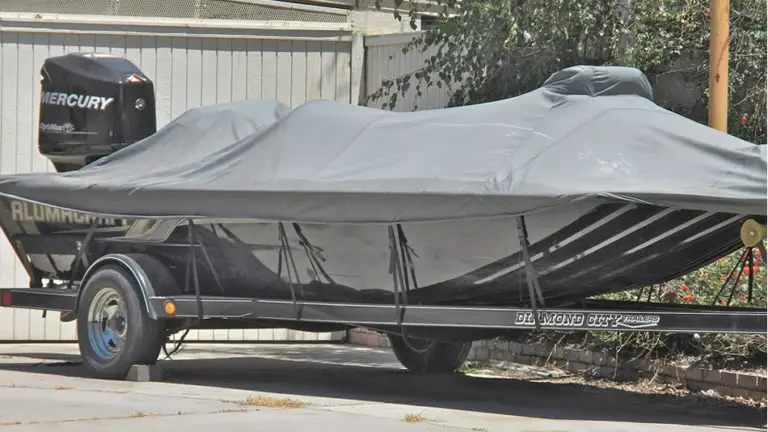
Boat Security – How to Prevent Your Boat From Being Stolen
I’m sitting here on a dock enjoying the sun and watching the boats cruise around. Not far from me is a marina filled with a lot of really lovely expensive ships, and it got me asking myself “what kind of boat security would these people have to prevent their boat from being stolen?”. Then it…
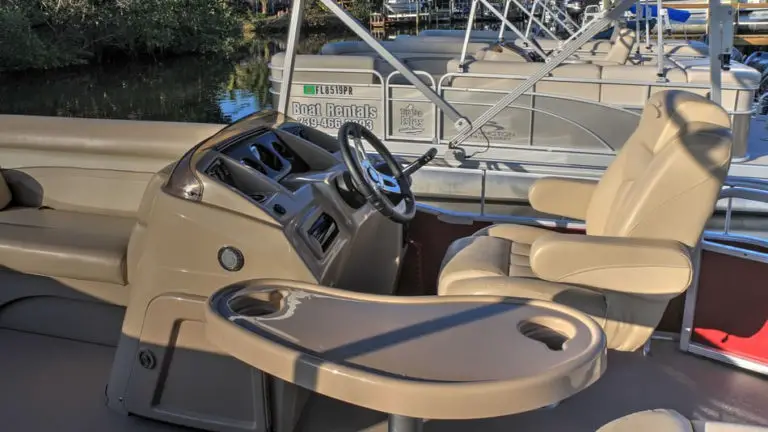
Which Boat Seat is Right For You
When it comes to boat seats there’s more to them then you think. There are many different styles and levels of comfort to choose from, similar to how there are many different styles of couches or recliners you can buy for your living room at home. Picking the right seat for you depends on you…

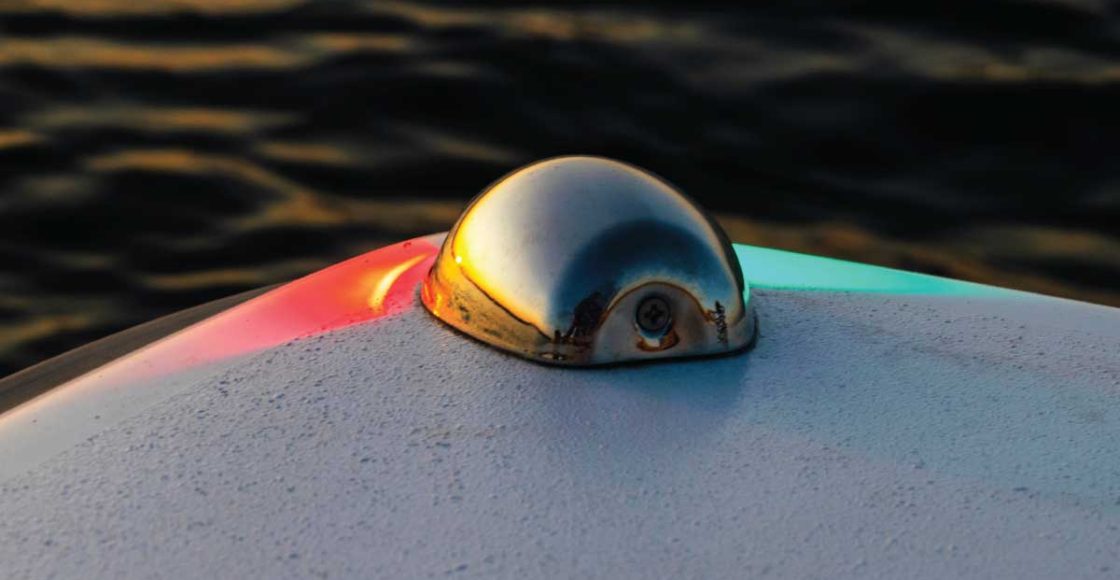
Boat Navigation Lights: Understanding the Basics

Table of Contents
Last Updated on July 19, 2022 by Boatsetter Team
For many boaters, the best way to end a beautiful day on the water is to watch the sun slowly drop below the horizon while it lights up the clouds and sky above. Others feel better heading to the dock before the sun goes down, while there is still plenty of light to illuminate the channel markers and other potential dangers.
Besides understanding boat navigation light rules, it is also important to understand:
- The overall purpose of boat navigation lights
- How to properly use boat navigation lights
- What the different colors (red and green) mean
Own a boat? Earn an avg. of $20K per season renting it out on Boatsetter
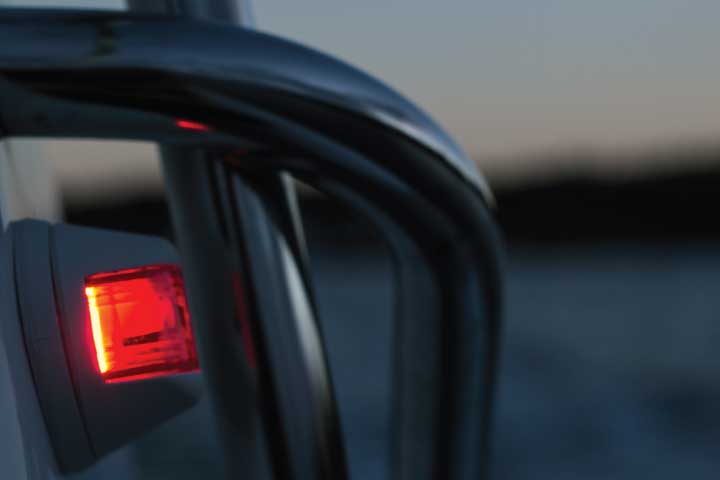
How do boat navigation lights work?
Boat navigation lights, or “nav lights,” are the colored marker lights visible on either side of the vessel and at the stern . These lights play essential roles in identifying the ship’s length, direction, and purpose!
The colored marker lights and where to find them go as follows:
- The boat’s port side is marked with a red light.
- The starboard side light is green.
- When looking at the boat’s transom or stern, a white light may be visible.
Keep in mind large boats and ships may use other colors, like yellow.
Next time you’re boating at night , say thanks to your navigation lights. They allow you to see other boaters in the dark and help prevent collisions. But there is much more to boat navigation lights than that.
How to use boat navigation lights
Each of the boat’s navigation lights is only visible for so many degrees of a circle to prevent confusion and accurately identify which side is in view.
By noting which colors are visible on another vessel, boaters can identify which direction the other boat is facing or headed. Knowing a boat’s direction can be especially important when crossing paths with another vessel in the dark.
If you walked around a boat at night while the navigation lights were on, the color visible would change depending on where you stood. When looking at the port side of the boat, the red light would be visible from dead ahead of the vessel to just past the center of the port side or through 112.5 degrees of a circle. Walk to the starboard side, and the green light would be visible from the bow to just past the boat’s center, or another 112.5 degrees.
Stand at the back of the boat, and you will see the white light visible for a total of 135 degrees from one side of the vessel to the other. Add up all three, and you’ll get 360 degrees.
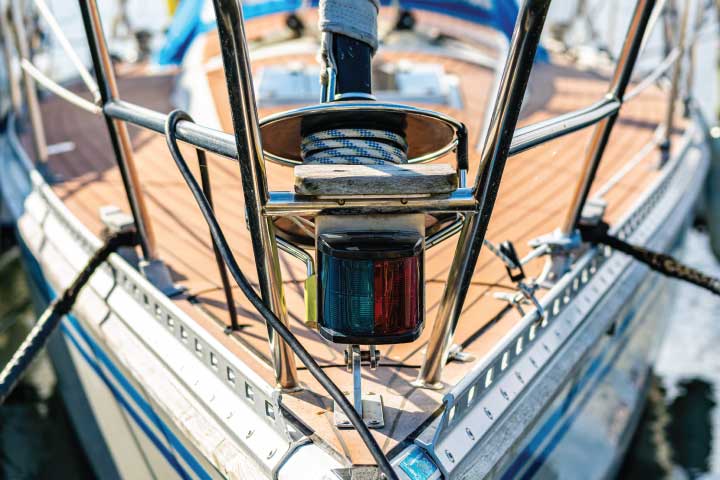
Boat navigation light color meanings
If you were on a boat at night and could see nothing but the different colored lights of another vessel ahead of you, you would still know exactly which way that boat was going.
- If you could only see the red light ahead of you, you would know that you are seeing the other vessel’s port side, or it is crossing in front of you from your right to left.
- The opposite is true if you saw the other vessel’s green light . You would be looking at the other vessel’s starboard side or watching the boat pass in front of you from left to right.
- If you see both red and green lights , then the other vessel is coming straight at you if you can see both red and green lights.
- If you can only see the white light and nothing else, you would look directly at the other boat’s stern as it drives away.
- Red and white means the boat is driving away from you, crossing from right to left.
- On the other hand, green and white signal that the vessel is moving away from you, crossing from left to right.
When renting a boat on Boatsetter , make it a habit of checking that navigation lights are working. You should turn on the navigation lights even if the sun is out. It’s the best and safest boating practice.
Want additional resources for boating?
Check out the links below for more information on boating.
- Navigation lights study guide
- Pre-departure boating checklist
- Boat Spring Commissioning Dewinterization Checklist
Don’t let your boat sit idly by. List it with us to earn $20K on avg.

Chuck Warren fell in love with boats at 9 years old while helping to restore his grandfather’s 1939 44-foot Elco cruiser. A lifelong boater, Chuck has experience operating large and small vessels on the waters of the Atlantic, Gulf of Mexico, Caribbean, and the Great Lakes.
During his 35-year marine industry career, Chuck has been the driver for several offshore powerboat racing teams, the chief engineer aboard a Caribbean research and salvage vessel, captain of a Florida Keys sunset cruise, and more.
Today, Chuck is a boating industry writer, copywriter, and captain who lives on his 40-foot boat in the summer when he isn’t delivering vessels around the Great Lakes or teaching new boaters to drive. Winters are split between the West Michigan lakeshore and wherever his travels take him.
Browse by experience

Explore articles

10 Best Boating Gifts for Dad
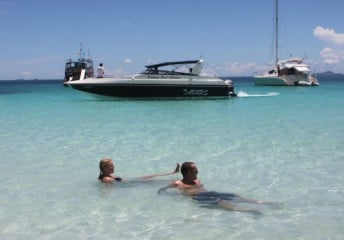
6 Stops For Your Florida Keys Charter

Waterfront Restaurants in Orlando to Visit by Boat
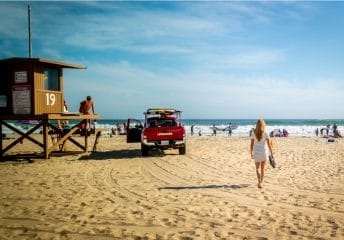
Newport Beach Water Activities

Boat Navigation Lights: Everything You NEED to Know (2024)
In many cases, boating at night requires the use of boat navigation lights, but boaters often have many questions about them.
They often wonder when they’re needed, what the requirements are for various locations and vessels, and more.
We’re going to do a deep dive into navigation lights for boat to see what you need on your boat, and when you need to use them.
Legal Requirements
Types of navigational lights, which navigation lights are required on my boat , operators responsibility , navigation lights .
On any vessel operating on or in US waters, there is a need for the operator to display navigation lights under certain circumstances. Their purpose is to make vessels aware of each other at night or in times of generally reduced visibility. This is incredibly important during times when you may not be able to see the craft itself.
Other than visibility, marine nav lights also help boat operators determine the size, direction of travel, and even the potential activity of another boat on the water. When an operator understands the type of information each light tells them, they will be better able to determine appropriate courses of action for potential situations.
Boat running lights are divided by location and color, and each of them has specific requirements with how they must be displayed and perceived. You are the one legally responsible for displaying proper nav lights on the boat, for displaying them at the proper times, and for understanding how to read them.
The US Coast Guard ’s legal navigation light requirements include guidelines for every aspect of light usage.
Their materials start by first defining the standard daily period during which they must be used, then they detail how many of each type of light is needed as well as where they are located. Each light also has constraints regarding its visible distance and the arc over which it can be seen.
In the US, the Coast Guard says that any powered vessel that is under 39.4ft., may operate with boat nav lights in as little as two positions, an all-round light at the stern, and a set of sidelights at the bow.
Vessels that are under 164ft. must have lights displayed in four positions, a stern light, a masthead light, and boat sidelights on both the port and starboard, near the bow.
The ship navigation lights also have minimum visibility distances, depending on the size of the craft. The minimum visibility for nav lights, even for small crafts, is one mile, with requirements that other lights on larger vessels be visible for up to 3 nautical miles.
Also read: Boating Rules and Etiquette On the Water
Boat lights come in 4 types, sidelights, stern light, masthead light, and all-round light. Lights only come in white, red, and green, and all have very specific jobs.
Masthead Light
The masthead light is the white light located about ⅔ of the way up the mast, rather than at the top as you’d think. This boat bow light is required when using motor power at night. To be acceptable, the light must have an arc of 225° and needs to be seen from 2 miles away.
Large boats can have up to 3 mast lights. If your boat is shorter than 39 ft., all 2-3 white mast lights can be combined, utilizing one larger white light at the top of the mast.
Color : White ARC : 225 degrees Position : Front of boat
Port Sidelight
The boating lights located on the port side of the watercraft are red and mounted so that boats can see as they approach either head-on or from the left. This light helps tell if a boat is coming towards you or if it is pointing away. The phrase “red, right, returning” means that if you see a boat with their red navigation light on the right, they are facing your boat. The only time it is not needed is when your boat is anchored for the night .
Color : Red ARC : 122.5 degrees Position : Forward, left side
Starboard Sidelight
If you are to approach a boat from the front or right, you will see the green starboard sidelight. With an ARC of 122.5 degrees, approaching boats will be able to see yours easily.
This light helps tell you whether or not you have the right of way, which is important when it comes to keeping both you and your passengers safe. These are some of the front boat lights.
This light will often be combined with the port light, in small boat navigation lights. When out in the water, if you see the green light, that means it is safe for you to go, as you have the right of way.
Color : Green ARC : 122.5 degrees Position : Forward, right side.
The rear boat light is called the stern light. It is used to mark the rear of the boat. The operator can infer from only setting a boat stern light, that they are directly behind the vessel.
The stern light is white and is visible for an arc of 112.5 degrees on both the port and starboard sides, making a full arc of 225. Being able to see the red starboard side light as well as the stern light, should indicate the other vessel is traveling to the right from the perspective of the observer.
Color : White ARC : 225 degrees Position : Stern
All-Around Light
One of the boat night lights that is required when on your boat between sunset and sunrise is the all-around light. This light is intended to be seen from any point and helps to tell what direction a boat is moving. This light is also used when a boat is stopped or anchored.
This anchor light is required to have an ARC of 360 degrees and should be visible for two miles. The all-around light is white and it is located at the top of your boat’s mast for maximum visibility.
Color : White ARC : 360 degrees Position : Top of mast
Tricolor Light
A tricolor light is a sailboat mast light that has your three types of bow light in one convenient piece of equipment. They are for sailboats that are smaller than 65.6 feet long. The point of this sailboat light is to increase your nighttime visibility. They are mounted at the top of the mast, allowing larger boats to see yours better. They are not permitted to be used by any boats with a motor. The only type of boat that can utilize a tricolor light is a sailboat.
Color : White, red, green ARC : 360 degrees Position : Top of mast
Towing Light
These yellow lights are important, as they indicate to other watercraft that, not only is there another boat nearby but that they are also towing someone as well. The light must be positioned at the back of the boat, as close to the stern as possible. The goal is to avoid having anyone run into the boat that is being towed, as there may be no lights showing where that boat is located. The boat lighting requirements when towing state that both sidelights, a stern light, and masthead lights should also be displayed.
Color : Yellow ARC : 135 degrees Position : Over fore and aft centerline of the boat
Law Enforcement Light
Lights used by law enforcement on the water are flashing blue lights that can flash 120 times per minute or more. They can be used nearly anywhere that is convenient for the operator, provided they do not interfere with the function of the other lights.
This light may be displayed by any type of local law enforcement that is engaged in the course of their duty. This can apply to local, state, or federal police, as well as officials from wildlife and conservation departments, the Coast Guard, and more.
Color : Flashing Blue ARC : 180-225 degrees Position : Anywhere not interfering with other lights
Find your boat type below for the lineup of nav lights that you will need to safely operate after sunset and in other times of limited visibility.
Be sure you know which lights you will need to have on while underway, as well as at anchor or while towing. If you’re sailing, don’t forget that you are considered power-driven when using your motor.
Powerboat under 23 feet (7m)
Powerboats under 23 feet are required to have the following navigation lights displayed:
- One white masthead light visible for 2 miles
- One red & green sidelight visible for 1 mile
- One stern light visible for 2 miles
- One white, red, green, or yellow all-round light visible for 2 miles
Powerboat Under 39,4 feet (12m)
Powerboats under 39,4 feet are required to follow these boat light rules:
- One all-round light visible for 2 miles
Powerboat Over 39,4 feet (12m)
Powerboats over 39,4 feet are required to have the following navigation lights displayed:
- One white masthead light visible for 5 miles, unless less than 20 meters, then 3 miles
- One red & green sidelight visible for 2 miles
Powerboat 39,4 feet (12m) to 164 feet (50m)
Powerboats between 39,4 feet and 164 feet are required to have the following marine running lights displayed:
- One white masthead light visible for 6 miles
- One red & green sidelight visible for 3 miles
- One stern light visible for 3 miles
- One all-round light visible for 3 miles
Sailboat Under 23 feet (7m)
Sailboats under 23 feet are required to have the following sailing navigation lights displayed:
- One white stern light
- One white mast lantern positioned at or near the top of the mast where it can be easily seen from a distance
Note: if it is not practicable for the vessel to display the prescribed lights, one all-round white light can be used or a hand torch, with enough time to prevent a collision.
Sailboat Under 65,6 feet (20m)
Sailboats under 65,6 feet are required to have the following sailing lights displayed:
Tug Boat With Tow Length Under 656 feet (200m)
Tug boats with tow lengths less than 656 feet are required to have the following navigation lights displayed:
- Two masthead lights in a vertical line
- Stern light
- Towing light in a vertical line above the stern light
Tug Boat With Tow Length Over 656 feet (200m)
Tug boats with tow lengths longer than 656 feet are required to have the following navigation lights displayed:
- Three masthead lights in a vertical line
- A towing light placed vertically above the stern light
- A diamond shape visibly displayed
Anchored Vessel
Vessels at anchor or aground are required to observe the following boat lighting rules:
- One white all-round in the fore
- One white all-round at a lower level than the fore, at the stern
If aground, the vessel should display two red all-round lights in a vertical line
Vessel Under Oars
Vessels under oar power have similar requirements to follow as small sailboat lighting:
- One stern light
Or, alternately, one white all-round light or hand torch to be used to manually signal to avoid collision
Vessel Engaged in Fishing
Vessels actively engaged in fishing are required to have the following marine navigation lights displayed:
- Two all-round lights oriented in a vertical line, red on top and white on the bottom
- One all-round white light for gear more than 150 meters from the vessel
- When making its way through the water, there shall also be sidelights and stern light
Vessel Engaged in Trawling
Vessels engaged in trawling are required to fulfill the following boat light requirements:
- Two all-round lights oriented in a vertical line, green on top and white on the bottom
- One masthead light abaft and higher than the all-round green
Kayakers and Canoers
Kayakers and canoers are required to have the following navigation lights displayed:
Alternatively, a hand torch or lantern which can be used to signal to avoid collisions
Personal Watercraft
There are no established rules for navigation lights on personal watercraft, even though many of them are classified as a boat by coast guard standards. Personal watercraft are often not permitted to operate outside of the sunrise-to-sunset period, and so most manufacturers do not install or make possible the installation of navigation lights.
Vessels Restricted in their Ability to Maneuver
Vessels restricted in their ability to maneuver are required to have the following navigation lights displayed:
- Three all-round lights displayed as high a possible in a vertical line, red at the top, and white in the middle
- One masthead light
The USCG as well as state authorities hold the operator of the vessel responsible for the correct use and understanding of nav lights.
This means they also must make sure all of the lights used meet the requirements set forth by the authorities.
This also extends to ensuring that the lights are all installed for optimal visibility while underway, so if your cruiser rides high, make sure your lights are still visible.
What navigation lights do I need on my boat?
Boat light regulations state boats must have a pair of red and green sidelights, and an all-around white light that can be seen from 360°.
Why are navigation lights red and green?
Navigation lights for boats indicate to others which direction a boat is facing. The red indicates the left side of the boat, green is on the right.
What lights need to be on a boat at night?
Per the navigation lighting rules, it is crucial that you have your red and green navigation lights, as well as the white 360° light.
Which three colors are used for navigational lights?
The boat light colors are going to be green, red, and white. If you see a blue light, this generally indicates a government vessel.
Do I need navigational lights on my boat?
Yes, all boats are legally required to have the minimum red, green, and white boat safety lights
when operating in the dark.
Why do boats have blue lights?
When you see a boat that has blue boat lights at night, that means that it is likely the coast guard or law enforcement.
Why is port red and starboard green?
The light on the starboard side of the boat is green because it is ‘safe’, as the steersman will be able to see other boats.
What does a single white light mean on a boat at night?
If you can only see a single white light on a boat at nighttime, you are likely seeing the stern light or the boat anchor light.

Robert Owens is the Chief of Content of Quicknav. Robert has been boating for over ten years and loves to share his experience on the water. His first boat was a dirt-cheap moderately beat up 2003 Bayliner 175, where he learned a tremendous amount about trailering, launching, docking, operating, and maintaining. He currently owns a Cruiser Yacht and is eyeing a sailboat.
Similar Posts
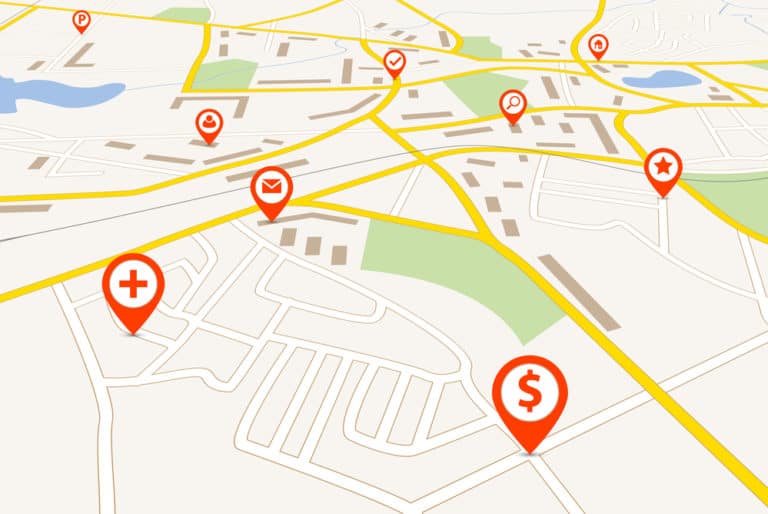
Glossary of GPS Terms in 2024 (The Definitive List)
Learning about global positioning systems or GPS can lead you down a rabbit hole of technical material, many dealing with…
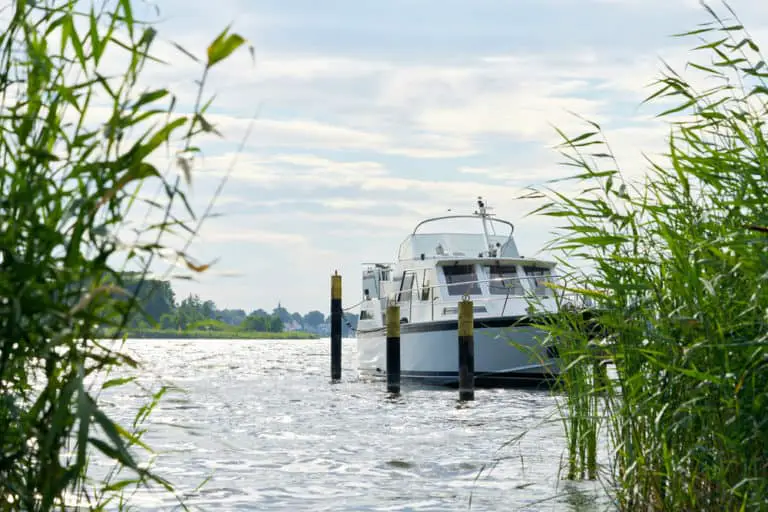
Do You Need a License to Drive a Boat in 2024? (U.S. & Canada)
It’s getting to be prime vacationing time, and if you’re traveling to enjoy some time on the water, you will…
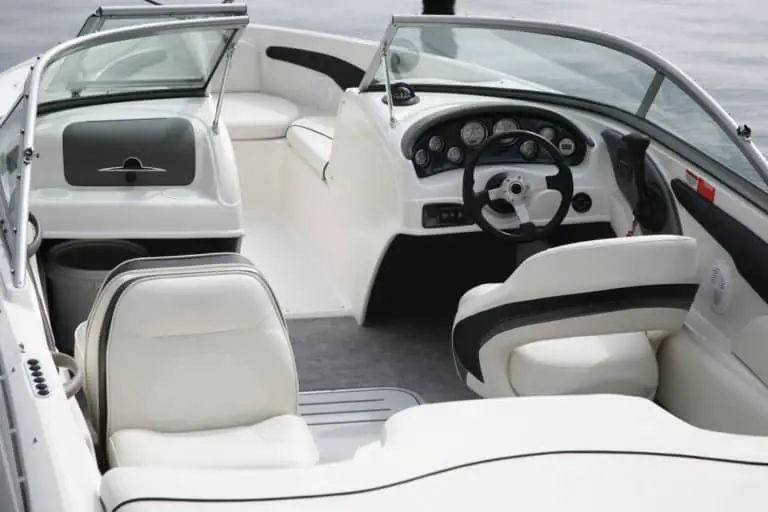
How to Clean Boat Seats? (a Practical Guide)
So you’ve bought your first boat and while you think you can master most of it with ease, you keep…
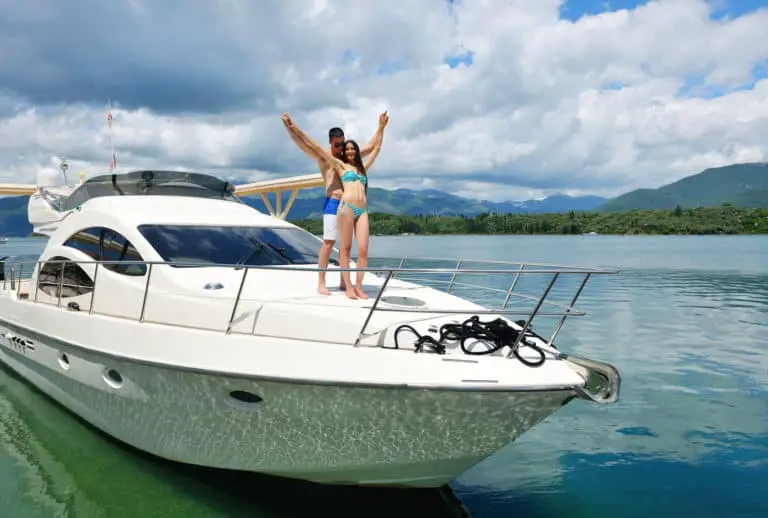
How Much Does a Boat Cost in 2024? (With Ownership Costs)
Residents all across the US are buying more boats than ever before. From kayaks and canoes to the most luxurious…
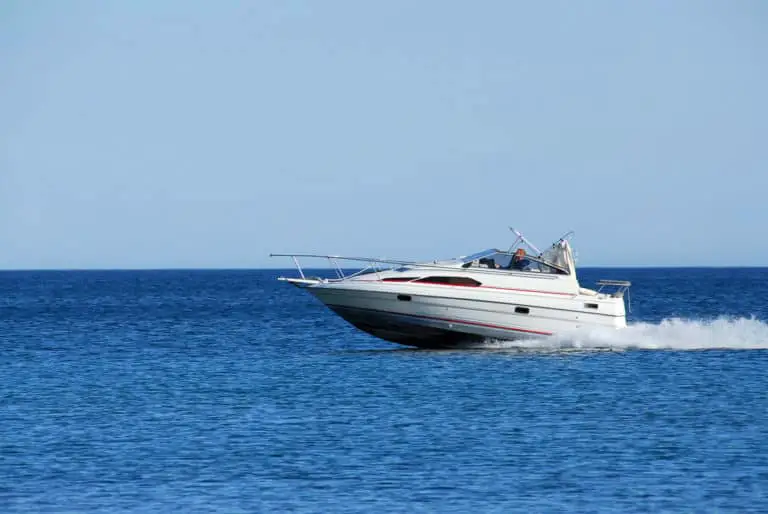
Boating Rules and Etiquette On the Water (2024)
Understanding the basic boating rules that are needed for the safe operation of a vessel, whether inland or out at…
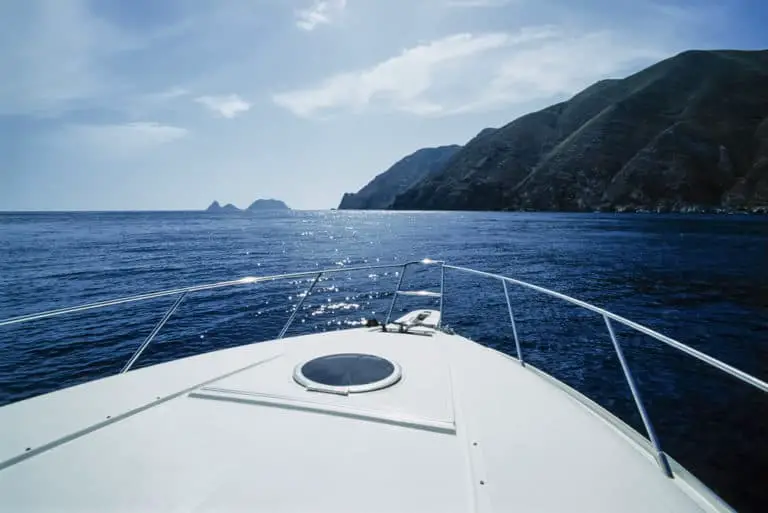
15 Practical Boating Tips for Beginners (2024)
Those new to the boating world as well as those who are simply new to owning their own boat may…
Lights and shapes

Definitions
- Masthead light means a white light placed over the fore and aft centreline of the vessel showing an unbroken light over an arc of the horizon of 225° and so fixed as to show the light from right ahead to 22.5° abaft the beam on either side of the vessel.
- Sidelight means a green light on the starboard side and a red light on the port side each showing an unbroken light over an arc of the horizon of 112.5° and so fixed as to show the light from right ahead to 22.5° abaft the beam on its respective side. In a vessel of less than 20 metres in length the sidelights may be combined in one lantern carried on the fore and aft centreline of the vessel.
- Sternlight means a white light placed as nearly as practicable at the stern showing an unbroken light over an arc of the horizon of 135° and so fixed as to show the light 67.5° from right aft on each side of the vessel.
- Towing light means a yellow light having the same characteristics as the sternlight.
- All-round light means a light showing an unbroken light over an arc of the horizon of 360°.
- Flashing light means a light flashing at regular intervals at a frequency of 120 flashes or more per minute.
Colour legend
Power-driven vessel underway
A power-driven vessel underway shall exhibit:
- a masthead light forward;
- a second masthead light abaft of and higher than the forward one; except that a vessel of less than 50 metres in length shall not be obliged to exhibit such light but may do so;
- sidelights;
- a sternlight.
Sailing vessels underway and vessels under oars
A sailing vessel underway shall exhibit:
In a sailing vessel of less than 20 metres in length the lights may be combined in one lantern carried at or near the top of the mast where it can best be seen.
A sailing vessel underway may, in addition to the lights, exhibit at or near the top of the mast, where they can best be seen, two all-round lights in a vertical line, the upper being red and the lower green, but these lights shall not be exhibited in conjunction with the combined lantern.
4 lights configurations sailing
A sailing vessel of less than 7 metres in length shall, if practicable, exhibit the lights prescribed above, but if she does not, she shall have ready at hand an electric torch or lighted lantern showing a white light which shall be exhibited in sufficient time to prevent collision.
A vessel under oars may exhibit the lights prescribed in this Rule for sailing vessels, but if she does not, she shall have ready at hand an electric torch or lighted lantern showing a white light which shall be exhibited in sufficient time to prevent collision.
Sailing and Motoring
A vessel proceeding under sail which has her engine running shall exhibit, forward where it can best be seen, a conical shape, apex downwards. She shall exibit lights according to a power-driven vessel.
A vessel at anchor shall according to Rule 30 (a) (b) exhibit where it can best be seen:
- in the fore part, an all-round white light or one ball;
- at or near the stern and at a lower level than the light prescribed in Rule 30(a)(i), an all-round white light.
A vessel aground shall according to Rule 30 (d) exhibit the lights prescribed in Rule 30(a) or (b) and in addition, if practicable, where they can best be seen;
- two all-round red lights in a vertical line;
- three balls in a vertical line.
A power-driven vessel when towing shall exhibit:
- two masthead lights in a vertical line. When the length of the tow, measuring from the stern of the towing vessel to the after end of the tow exceeds 200 metres, three such lights in a vertical line; Rule 24 ;
- a sternlight;
- a towing light in a vertical line above the sternlight;
- when the length of the tow exceeds 200 metres, a diamond shape where it can best be seen.
Towing an inconspicuous, partly submerged object
An inconspicuous, partly submerged vessel or object, or combination of such vessels or objects being towed; Rule 24 (g) , shall exhibit:
- if it is less than 25 metres in breadth, one all-round white light at or near the forward end and one at or near the after end except that dracones need not exhibit a light at or near the forward end;
- if it is 25 metres or more in breadth, two additional all-round white lights at or near the extremities of its breadth;
- if it exceeds 100 metres in length, additional all-round white lights between these lights so that the distance between the lights shall not exceed 100 metres;
- a diamond shape at or near the aftermost extremity of the last vessel or object being towed and if the length of the tow exceeds 200 metres an additional diamond shape where it can best be seen and located as far forward as is practicable.
Pushing from ahead or towing alongside
When a pushing vessel and a vessel being pushed ahead are rigidly connected in a composite unit they shall be regarded as a power-driven vessel and exhibit the normal lights.
A power-driven vessel when pushing ahead or towing alongside, except in the case of a composite unit; Rule 24 (c) , shall exhibit:
- two masthead lights in a vertical line;
A vessel or object being towed shall exhibit:
- Provided that any number of vessels being towed alongside or pushed in a group shall be lighted as one vessel,
- a vessel being pushed ahead, not being part of a composite unit, shall exhibit at the forward end, sidelights;
- a vessel being towed alongside shall exhibit a sternlight and at the forward end, sidelights.
Fishing – Trawling
A vessel engaged in fishing, whether underway or at anchor, shall exhibit only the lights and shapes prescribed below; Rule 26
A vessel when engaged in trawling, by which is meant the dragging through the water of a dredge net or other apparatus used as a fishing appliance, shall exhibit:
- two all-round lights in a vertical line, the upper being green and the lower white, or a shape consisting of two cones with their apexes together in a vertical line one above the other;
- a masthead light abaft of and higher than the all-round green light; a vessel of less than 50 metres in length shall not be obliged to exhibit such a light but may do so;
- when making way through the water, in addition to the lights prescribed hereh, sidelights and a sternlight.
- when shooting nets, white light over white light (Flag Z by day);
- when hauling nets, white light over red light (Flag G by day);
- When nets are caught on the bottom, red light over red light (Flag P by day).
Trawling in span
When pair trawling, each vessel shows searchlights on water aiming forward ( Flag T by day); Rule 26 (f) (b)ǂ(2)
Fishing, other than trawling
A vessel engaged in fishing, other than trawling , according to Rule 26 (c) shall exhibit:
- two all-round lights in a vertical line, the upper being red and the lower white, or a shape consisting of two cones with apexes together in a vertical line one above the other;
- when there is outlying gear extending more than 150 metres horizontally from the vessel, an all-round white light or a cone apex upwards in the direction of the gear;
- when making way through the water, in addition to the lights prescribed here, sidelights and a sternlight.
Purse seining
Purse Seiners will exhibit two all-round yellow lights in a vertical line, flashing alternately; Rule 26 (f) 3ǂ(iii)
Constrained by draught
A vessel constrained by her draught / draft may, (and not “shall”!) in addition to the lights prescribed for power-driven vessels, exhibit where they can best be seen three all-round red lights in a vertical line, or as day sign a cylinder, Rule 28
Not under command
A vessel not under command, sometimes knows as a NUC N ot U nder C ommand." aria-label="Illumination" data-bs-original-title="NUC"> vessel, shall according to Rule 27(a) exhibit:
- two all-round red lights in a vertical line where they can best be seen;
- two spherical shapes in a vertical line where they can best be seen; and
- when making way through the water also normal sidelights and a sternlight (not shown in the examples below).
Restricted in her ability to manoeuvre
A vessel restricted in her ability to manoeuvre, sometimes knows as a RAM R estricted in her A bility to M anoeuvre." aria-label="Illumination" data-bs-original-title="RAM"> vessel, except a vessel engaged in mine clearance operations , shall according to Rule 27(b) exhibit:
- three all-round lights in a vertical line where they can best be seen. The highest and lowest of these lights shall be red and the middle light shall be white;
- three shapes in a vertical line where they can best be seen. The highest and lowest of these shapes shall be balls and the middle one a diamond;
- when making way through the water, also a masthead light or lights, sidelights and a sternlight
Dredging or underwater operations
A vessel engaged in dredging or underwater operations, when restricted in her ability to manoeuvre; Rule 27(d) , shall exibit
- two all-round red lights or two balls in a vertical line to indicate the side on which the obstruction exists;
- two all-round green lights or two diamonds in a vertical line to indicate the side on which another vessel may pass; and
- when at anchor (or not making way), the lights or shapes prescribed in this section instead of the lights or shapes prescribed in Rule 30
Small diving vessel
A vessel engaged on pilotage, according to Rule 29 , duty shall exhibit:
- at or near the masthead, two all-round lights in a vertical line, the upper being white and the lower red;
- when underway, in addition, sidelights and a sternlight; as shown in the example below.
Hovercraft, hydrofoil ferry
An air-cushion vessel when operating in non-displacement mode shall, besides a masthead light forward, (plus a masthead light abaft if longer than 50 m) sidelights and a sternlight, exhibit an all‑round flashing yellow light (faster than 2 flashes per second). Rule 23(b)
Also a hydrofoil ferry or high speed catamaran when acting as ferry is often allowed under local regulations to exhibit an all-round flashing yellow light.
Minesweeper
A vessel engaged in mine clearance operations shall in addition to the lights prescribed for a power-driven vessel, or to the lights or shape prescribed for a vessel at anchor, exhibit three all-round green lights or three balls. One of these lights or shapes shall be exhibited near the mast head and one at each end of the fore yard. These lights or shapes indicate that it is dangerous for another vessel to approach within 1000 metres of the mine clearance vessel. Rule 27(f)
See all chapters
Course overview Chapter 1 – Positions Chapter 2 – Nautical chart Chapter 3 – Compass Chapter 4 – Plotting and piloting Chapter 5 – Plotting and piloting – Advanced Chapter 6 – Tides Chapter 7 – Tide prediction Chapter 8 – Currents Chapter 9 – Navigation aids Chapter 10 – Lights and Shapes

Please verify you are a human
Access to this page has been denied because we believe you are using automation tools to browse the website.
This may happen as a result of the following:
- Javascript is disabled or blocked by an extension (ad blockers for example)
- Your browser does not support cookies
Please make sure that Javascript and cookies are enabled on your browser and that you are not blocking them from loading.
Reference ID: 78d85bca-1e0d-11ef-8b08-76edd7fc0b35
Powered by PerimeterX , Inc.
Get your card today

- Pre-paid code

- Buy a Gift Card
Boat Navigation Light Rules and Requirements

Boat navigation lights are one of the most important pieces of safety equipment on your boat, along with personal flotation devices , boat fire extinguishers and boat ventilation systems .
As a boat owner or operator, you are legally responsible for using the correct safety equipment at all times. This is your responsibility whether your boat is moving through the water or you are at anchor, day and night, in all types of weather.
Did you know that boat manufacturers, importers and dealers are not responsible for equipping your boat with legally acceptable navigation lights ? Before you take to the water, check that your navigation lights are:
- the right size and type for your boat and chosen water activity
- the right color and intensity
- attached to the correct parts of your boat
- fully operational.
It’s important to learn all you can about navigation lights for safe, legal boating! Keep reading to find out which lights to use when.
What are navigation lights for?
Navigation lights allow you to see and identify other vessels, and allow other boats to see and identify you. There is not one simple way to use navigation lights; the way they are set up on your boat will indicate the size, activity, and direction of travel of your vessel, so that you and other boat operators can make good decisions and avoid collisions.
By understanding what navigation lights mean, you will be able to safely and legally navigate shared waters under a variety of circumstances.
Boat navigation light requirements
Paddleboats, rowboats and small sailboats generally do not need to display navigation lights, but most other boats are legally required to use some or all of the following:
- A green light to indicate the starboard (starboard sidelight) attached near the bow on the starboard side
- A red light to indicate the port (port sidelight) attached near the bow on the port side
- One or more white lights (stern light and masthead light)
- Other navigation lights , such as blue flashing lights for law enforcement vessels engaged in search-and-rescue (SAR) operations, or yellow lights for vessels that are towing or being towed
Each type of navigation light also has a defined arc of illumination and range of visibility. Angles of visibility must be met when the boat is underway, which means that if your boat rides at a significant bow-up angle, you may need to adjust your navigation lights to compensate.
You must always use navigation lights between sunset and sunrise or in reduced visibility, but there are some exceptions during clear, daytime boating.
Note: It is also important to keep a flashlight on board as a temporary replacement, in case a navigation light burns out.
Boat navigation lights while underway
While your boat is underway, you are legally responsible for displaying the right type of navigation lights. Choosing the right lights depends on several factors, including:
- Whether your boat is powered by an engine (in full or in part)
- The size of your boat , measured in length
- Your boat’s speed
- Where you are boating (inland, international water, etc.)
- Whether you are at anchor.
Remember that your navigation lights must be visible and easily identifiable as such. Other lights on your boat cannot be mistaken for navigation lights, or get in the way of your navigation lights
Sailboat navigation lights
If you are operating a sailboat or nonpowered boat such as a canoe, kayak or rowboat, you still need to use the correct configuration of navigation lights for your boat size and boating circumstances. For comprehensive detailed instructions on navigation lights please refer to the USCG resource. The following are general guidelines:
Sailboats or vessels using paddles or oars, under 23 feet in length:
- One white navigation light (or lantern or flashlight) that is visible from 2 nautical miles away between sunset and sunrise or during periods of low visibility. In the presence of another vessel, the light must be displayed in time to avoid a collision.
Sailboats between 23 and 65.6 feet:
- One white stern light visible at 135 degrees and from 2 nautical miles
- One green starboard and one red port sidelight, visible across 112.5 degrees from one nautical mile away
- A tricolour light, which is a single all-around light which includes the three coloured of lights indicated above, facing the same directions, visible from a distance of 2 nautical miles. This type of light can only be used when under sail, and never when using a motor regardless of whether the sails are hoisted. It may not be used at the same time as regular sidelights.
Powered boat navigation lights
If you are operating a boat with an engine (including sailboats with motors), between sunset and sunrise or under conditions of restricted visibility, you need navigation lights.
Powered boats under 39.4 feet:
- One all-around white light, visible from all directions (360 degrees) from two nautical miles away. This light must be attached at least 39 inches above the sidelights.
Recreational powered boats between 40 feet and 164 feet:
This size of boat requires two white lights which, combined, make up 360 degrees of visibility:
- A white masthead light at the bow, visible across 225 degrees, from 2 nautical miles away. This light must be attached at least 8 feet above the gunnel.
- A white stern light at the stern, visible across 135 degrees and from 2 nautical miles away.
In addition to:
- One green starboard and one red port sidelight, visible across 112.5 degrees from one nautical mile away.
Boat navigation lights at anchor
When your boat is anchored at a dock, it is not necessary to turn on your navigation lights. However, if you are at anchor in an undesignated area, you need to make other boats aware that you are not moving by displaying an all-around white light where it will be easily visible to any other boats in the area.
Diving lights
If you are boating in a resort area or anywhere there are sunken wrecks or coral reefs, keep in mind that there could be diving activity. Keep your distance and stay alert to the possible presence of divers underwater.
Boats that are accompanying divers must display:
- Three vertical masthead lights in a red-white sequence.
Interpreting boat navigation lights
Installing and using the right navigation lights on your boat is very important, but to navigate safely, you also need to be able to interpret the navigation lights on other boats.
Remember, you may not always be boating under ideal circumstances. Make sure you learn to understand navigation lights and the United States Coast Guard rules of navigation , also called the Rules of the Road , thoroughly, so that you can make good decisions quickly, as needed.
Do you see a green light over a white light? This indicates a fishing vessel that is actively trawling. It may be necessary to avoid not only the boat, but also a large net.
Do you see a red light to the left, with two white lights to the right? Understand that you must yield to the other boat.
There are many other configurations you need to be familiar with to operate your boat safely.
Avoiding collisions
Remember, navigation lights are only a tool. You must also maintain a proper look-out at all times, by sight and hearing, to responsibly avoid collisions. Skippers must drive at an appropriate speed so that you can take effective action to avoid colliding with another vessel or body under or on the water.
Factors like visibility, traffic density, the maneuverability of your vessel, the presence of other lights from shore or scattered boat lights, the state of the sea and the draft in relation to the available depth of water must always be taken into consideration. Radar equipment may also pose certain limitations or offer certain benefits to navigating safely.
It is the boat operator’s responsibility to do everything in their power to avoid a collision, including but not limited to the correct display of navigation lights.
Learn about boat navigation and more from Drive A Boat USA!
Driving a boat safely demands a thorough knowledge of navigation, safety procedures and other technical details.
What you need to know depends in part on where you intend to go boating, the size and type of boat you will use, and what type of activity you will be engaged in, but there are many basic rules and regulations that you are legally obliged to follow no matter what the circumstances.
You can get your official state-approved online boating license today! Sign up for our fun and engaging boating safety course to get started.
- USA Boating
Latest Posts
- Downstream vs Upstream in a Boat: What’s the Difference?
- Boat Propeller Strike: Avoiding Injuries and Accidents
- Starboard Side and Port Side Explained
- Water Skiing Hand Signals
- Water Skiing & Towed Water Sports Safety Guidelines
- February 2024
- December 2023
- October 2023
- September 2023
- January 2023
- November 2022
- Get certified now
- Replacement California Boater Card
Sign up now for our WhatsApp newsletter and receive a FREE SVB set of playing cards!
Get the latest SVB news via WhatsApp and/or SMS!
- Spare parts
- SVB@Youtube
- My SVB Account
- Compare list
Are you missing items that you have already placed in your shopping cart? Log in to see your saved items.
- Boat Safety Equipment
Navigation Lights on Sailing Yachts and Motor Boats

Navigation lights ensure the safety of everyone at sea. The Convention on the International Regulations for Preventing Collisions at Sea (IMO COLREG 72) precisely sets out the guidelines for navigation lights, i.e., displaying lights, their range (distance from which the light is visible), as well as how they should be constructed and assembled. Our guide is of interest to sailors and sports boats enthusiasts with boats up to 20 m in length.
Regulations and official certifications:
When must navigation lights be displayed, what are the regulations concerning the use of navigation lights at sea, how do i know that my lights are eu-compliant, what is a ce mark, how are navigation lights defined, minimum range of navigation lights:.
- From what distance must lights be visible?
- What lights are required for my boat?
What lights must be displayed on a sailboat or rowing boat with a motor?
What lights should i exhibit when at anchor, what lights should be displayed to show that a vessel is unable to manoeuvre.
- How do I indicate that my vessel has run aground?
Navigation lights – Conventional and LED:
What distinguishes led from conventional navigation lights.
- Replacement bulbs for conventional & LED lights
What are the advantages of LED navigation lights?
Switching from conventional to led navigation lights.
According to COLREGs part C, rule 20), navigation lights must always be used on board from sunset to sunrise or during the day if visibility is poor.
Please refer to the German Traffic Regulations for Navigable Maritime Waterways , §8 -10 and Preventing Collisions at Sea. Part C - Lights and Shapes. rules 20 - 31, and annexes I 1. - 14 for the exact wording.
NOTE: Vessels that are authorised to fly the German flag are generally only permitted to use approved navigation lights and sound signalling devices.
EU approval can be identified via the wheel mark symbol and the notified body number. BSH approved navigation lights (previously DHI) are marked with a model number (e.g., BSH/00/01/90).
However, even older lights with DHI approval that have already been installed maintain their approval, despite the changes made by the BSH.
In addition to the wheel mark symbol and German BSH approval, some lights are also approved by other countries, such as RINA (Registro Italiano Navale), MCA (Maritime and Coastguard Agency) and the USCG (United States Coast Guard). These are now recognised, provided the approval comes from the national approval body recognised in the country of origin.
National bodies whose accreditation is currently recognised in Germany:
The wheel mark symbol indicates approval of the Marine Equipment Directive (MED). This approval is valid for all EU member states, both for commercial vessels and recreational shipping.
0098 = Notified Body number (here 0098 = Germanischer Lloyd in Hamburg) 18 = year in which the mark is affixed, here 2018

- A CE mark is a symbol that must be affixed to a product by the manufacturer before it is sold on the European market. It indicates that the manufacturer is aware of the specific requirements for the product in question and that it fulfils the requirements of relevant European product directives. A CE mark does not supersede approval according to collision prevention regulations.
- Navigation lights are defined in detail by the International Maritime Organization (IMO), according to the International Regulations for Preventing Collisions at Sea, 1972 (COLREGs) Convention on the International Regulations for Preventing Collisions at Sea, 1972), in sections C and D. The following rules apply:
Which navigation lights are required on board according to IMO COL REG?
Definitions according to the 1972 International Regulations for Prevention of Collisions at Sea (COL REG 72):

1. Side lights for starboard and port
A green light on the starboard side and a red light on the port side, which shine from dead ahead in an arc of 112.5° aft to a point 22.5° abaft the beam (behind the beam) on either side of the vessel. On ships of less than 20 metres in length, the two individual sidelights may be replaced by a dual-colour combined light. This must be centrally located on the bow and stern axis.

2. Stern light
A white light mounted as close to the stern as possible and shines dead ahead in an arc of 135° (67.5° to each side). The mounting height should be aligned to the height of the side lights and should never be higher.

3. Three-colour light for sailing vessels (sailing lights)
On sail boats up to a length of 20 m, the side light and stern light can be combined into one three-colour light mounted on top of the mast. However, as soon as the sail boat's motor is engaged, the use of a three-colour light is no longer permitted. The rules for motor-powered vessels then apply.

4. Mast-head light
A white light placed over the centre line of the vessel and shines dead ahead in an arc of 225° (from straight ahead up to 22.5° more aft than crosswise to each side). The mounting height should be at least 1 m higher than the side lights. In the past, the mast-head light was also referred to as a steam boat light or steamer light, as it is only seen on ships that operate under engine power.

5. Signal light or all-round light
A light that shines in a complete circle of 360°. It may emit white, red or green light, depending on use. Examples of use: All sailboats and motorboats at anchor must exhibit a white anchor light . Ships over 12m in length must, if necessary, display vessel-in-distress lights (two red signal lights) placed at a vertical distance of at least 12 m. The distance between such lights must not exceed 1 m.
From what distance must navigation lights be visible?
The range indicates the distance from which the light can be seen. The minimum ranges of navigation lights are defined according to ship size as follows::
Best-seller Hella marine

Note: When sailing boats are powered by a motor, the rules for motorboats apply and not for sailboats. The tricolour light may then no longer be displayed.

Displaying lights for sailboats up to 20 m
1 x red port side light
1 x green starboard light
1 x stern light
Also allowed:
1 x red all-round light on or near the mast top
1 x green all-round light on or near the mast top

1 x 3-colour light

Sailing vessels under 7 m (dinghies or small sports boats)
If, due to their design, no modern lights can be fitted, sailing vessels under 7 m in length and vessels being rowed must always carry an electric torch or lantern showing a white light, ready to exhibit in sufficient time to prevent a collision.
1 x Electric light or a torch with white light

Motorised vessels over 12 m
Lights used must be either / or:
1 x white masthead light fore

1 x dual colour light

Motorised vessels under 12 m
Alternatively, motorised vessels under 12 m can exhibit the following lights:
1 x white all-round light

Motorised vessels under 7 m and 7 knots maximum speed (small motor boats, dinghies or inflatables):
Motorised vehicles under 7 metres and with a maximum speed of no more than 7 knots can display the following navigation lights: all-round lights, portside and starboard lights.
The following applies in accordance with German Traffic Regulations for Navigable Maritime Waterways (SeeSchStrO): If, due to their design, no lights can be displayed (e.g., dinghies), sailing vessels under 7 m in length and 7 knots maximum speed must carry an electric hand-held spotlight or a torch to prevent collisions in the dark.
Left: 1 x white all-round light, 1 x red port side light, 1 x green starboard light
Right: 1 x hand-held spotlight or torch
Best-seller Aqua Signal Conventional

Best-seller Aqua Signal LED

Provided no engine power is used, the rules for sailboats apply. Motor-sailing vessels must display a large black cone pointing downwards when sailing during the day or at good light.
For vessels travelling under sail or at rudder during darkness or at reduced visibility, the rules for carrying lights for motorised boats automatically apply. This then depends on the length of the boat.
By day with a black cone, tip pointing downwards.
Visual signalling equipment

Torches & Spotlights

How must navigation lights be mounted on board?
Navigation lights must be securely mounted perpendicular to the waterline. Mast-head lights and stern lights should both be placed above the keel line.
At anchor during daylight? This must be displayed with a black anchor ball.
If the vessel is anchored outside of an area of water known by the River and Shipping Police Authority as an anchorage and berth for small vessels, this must be indicated as follows:
A black ball by day, 1 x white all-round light at night

Marker Lights

If your boat is unable to manoeuvre*, this should be indicated as follows:
Stationary: 2 x red all-round light, 2 x black ball, one below the other (during the day)
Moving: 1 x red port side light, 1 x green starboard light, 1 x white stern light
* A vessel is described as if, due to exceptional circumstances (e.g., rudder failure or engine malfunction), it cannot manoeuvre as prescribed and therefore cannot avoid another vessel.

How do I indicate correctly that my sailboat or motorboat has run aground?
If your boat has run aground, this should be indicated as follows:
2 x red all-round light, 1 x white all-round light, 3 x black ball, one below the other (during the day)
Manufacturers that specialise in navigation lights such as Aqua Signal or Hella Marine supply a wide range of internationally approved navigation lights which work with conventional (with BSH bulb) or with permanently installed light-emitting semiconductor components (LEDs). The bulbs required for operation are an integral part of the approval. Replacement bulbs must also be certified so that approval / your insurance protection is guaranteed. Ships under 20 m: Stern and anchor lights require BSH-approved light bulbs with 10 watts, all other navigation lights 25 watts.
All series listed above with BAY15d sockets could alternatively be operated with a high-Power LED . The big advantage in doing so is that the LED is suitable for multiple voltages (10-30 V) and consumes just 3 watts during operation. Since the light colour, range of light or beam angle can vary depending on the housing, this light is NOT yet internationally approved.
Spare Bulbs - Conventional & LED

Energy consumption on sailing ships is, as ever, a topic of significant interest. This is especially true for blue-water sailors who like to sail longer distances at a stretch. The arguments for converting to LED technology are as follows:
- High energy savings due to the low power consumption
- Long lifespan (over 10,000 hours)
- MultivoltTM technology (10-30V) with greater tolerance to voltage peaks
- Compact and light housing constructions
- Waterproofed, hermetically sealed housings
- Maintenance free
When switching completely from conventional navigation lights to LED lights, lights with the BSH seal of approval / EU wheel mark meet all the requirements in terms of light colour (no risk of blue tint), range of light and beam angle, and that you are travelling in accordance with KVR.
Navigation lights with LED technology

Replacing your navigation lights is often easy to do as manufacturers usually use the same mounting points for LED lights or have an adapter plate for further use of existing drill holes:

Adapter plate

Share our guide on social media

Written by our SVB (technical) experts
Our SVB safety experts regularly carry out maintenance checks and tests on our safety products, such as life jackets, life rafts etc. They test products and base their recommendations on many years of experience and their own know-how.

Ultimate Guide To Marine Navigation Lighting
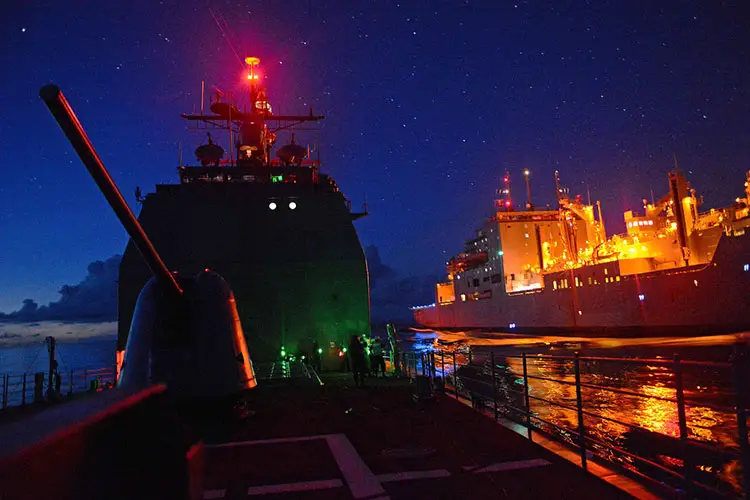
If you drive a car or even ride a bicycle, you might be well aware of the necessity of lighting systems (though in the second case the word ‘system’ doesn’t quite apply) for the safety of you and the people around you. The thing applies just as well for ships. But since they are much larger than a car, the lighting system or navigation lights on ships is a little bit more complicated as well. Marine navigation lighting is also one of the most critical aspects of nautical studies.
It is mandatory for boats of all sizes to have a navigation system . This is to make sure that the chances of any significant accident are minimized. The United States introduced the system in 1838, and the United Kingdom followed suit. Before being internationally adopted in 1897 suitable guidelines were established by the International Maritime Conference which was established in 1889. Three colors were chosen that were to be used for the light colors. They were red, green and white. This was based on a set of rules specified by the US and are followed around the world to this date.
This article discusses the different rules and regulations of using navigation lights, their importance, and also some basic marine navigation lighting systems along with their positions and ranges.
Marine Navigational Lights, Rules and Regulations
A standard pattern of marine navigation lighting is followed for the identification of both the vessel as well as the IALA buoyage system at night. If you are required to move from sea to a channel you need to have a list of all the IALA as well as the other fixed navigational lights that are visible on entering the channel. This includes distant lighthouses as well.
If you also make a note of the inland features like the radio and television transmitter masts it will benefit you because they act as good navigational aids due to their height and warning lights.
The helmsman should not be using any bright light source in the cockpit area and should rather take the aid of red lights and very dim white lights in the galley and navigation area. This is because he needs to preserve his night vision so that he can accurately interpret both the buoyage marine navigation lights as well as the boat navigation lights of other vessels.
The nautical almanacs contain the details of each and every visible maritime light signal coming from navigational markers that are both inside and outside the channel.
All the details about any particular light can be found in a published list or on a marine navigational lights chart: its color, period, and in some cases even the elevation and range of the beacon. Use the chart to keep a tag on the lights you are passing by putting a tick mark on the lights that you are about to pass and as the boat sails past, the tick is checked.
You will get two visual clues to figure out how far you are away from a buoy. The light will elevate from the horizon at 0.5 nm and at about 200m, the light will reflect on the surface.

Position of Boat Navigation Lights
Most of the variations that can be found in the different vessels can be read about in most almanacs. At the very basic level, a vessel needs to show a red light to port and green light to starboard. Depending on the size of the vessel, one or more colored or white lights are used as well.
For vessels that are 12 ft in length or shorter, the navigation lights must be visible from a range of one nautical mile and for the ones that are longer than 12 meters the required visibility range is 2 nautical miles. From 5 degrees above to 5 degrees below the horizontal happens to be the required minimum intensity in a vertical sector.
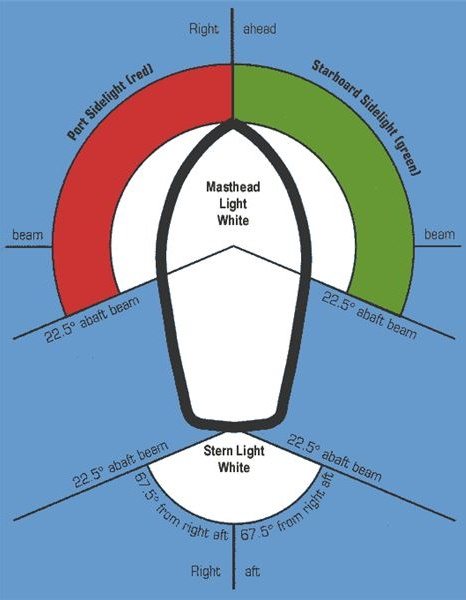
International Navigation Rules state that the boat navigation lights should be placed above the uppermost continuous deck. In case separate fixtures are used for the red and green sidelights, the masthead or all-round white light is placed as close as possible to the vessel’s fore and aft centerline. The masthead or all-around light needs to be positioned at least 1 m or 3.3 ft above the sidelights.
Following are the basic positions of navigational lights. We will discuss the same in greater detail ahead.
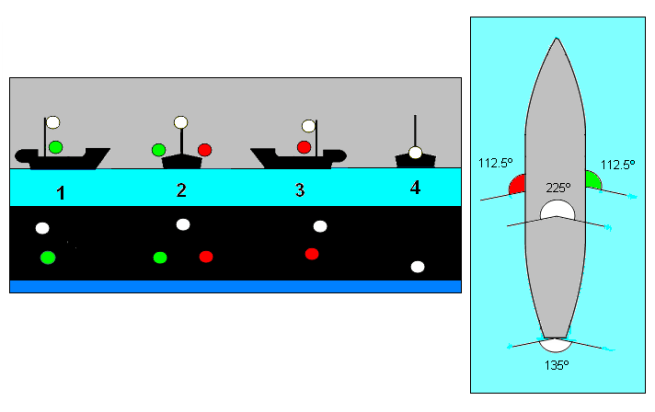
Also read: What Is A Marine Sextant?
Boat Navigation Light Regulations
Several rules and specifications are related to the type, size, layout, arc, and distance of visibility of boat navigation lights used by all vessel types which are collectively known as the International Regulations for Preventing Collisions at Sea or COLREGs . The navigational lights used are known as ‘COLREG lights and shapes. A boat might be anchored or underway, under sail or power, or fishing or trawling. These various situations can be communicated through multiple combinations of boat navigational lights.
In addition to the primary navigation lights, vessels may also display one or more steaming lights. These lights are very useful for it gives details about the various aspects of the ship like whether it is in the sail or under power, the direction in which it is going and, in some cases, even the size of the vessel. If a ship is engaged in a specific task that might involve certain restrictions, that too can be indicated with some extra boat lights.
Always maintain the lighting system and display the correct navigation light combination to make other vessels in the vicinity aware of your course and state as to whether your vessel is under power or not. If you follow this a considerable amount lowers the chances of a collision. Here is a list that you might use to familiarise yourself with the basics of the lighting system.
- Basic Navigation Light White Light : Small dinghies that are 7m or less in size are required to carry a torch having a white light that can be flashed when needed.
- All-Round White Light: An all-round white light is expected to be displayed by a small boat, up to 7ft long that is under power and can go beyond 7 knots of speed. This light must be visible at an angle of 360 degrees and from two miles away. An all-around white light is also used when the boat or vessel is at anchor but not at a designated anchoring area. This is to make sure that the ship is visible to all the nearby ships to avoid any accidents.
- Stern and Combined Side Lights : A stern light is a white light that is installed at the end of a boat. A vessel that is over 7 m or 23 ft in length is expected to show red and green sidelights when sailing. Each of these lights needs to cover an arc of 112.5°. The sidelights may be combined in one lantern at the bow when below 25 m or 65 ft. The white stern light can be seen over an arc of 135°. These lights need to be visible from a distance of a mile and need to be placed 39 inches below all white lights for boats of lengths equal to or less than 12 ft.
- Masthead Light : A combination of sidelight and stern light in a tricolor combination may be used sailing yachts of heights 20 m or lower. A masthead light is required by vessels of lengths between 39.4 ft and 65.6 ft. It is placed in the masthead whose height provides excellent visibility. Still, stern lights and sidelights should be fitted separately in case of or use under power along with steaming light. This kind of light needs to be visible across an angle of 225 degrees and from a minimum distance of 2 miles.
- Separate Lights : The displaying of the tricolor masthead light is not allowed in the case of yachts that are longer than 20 m or 65 ft. Instead, they use them separately. Often on large sailing vessels, these all-around, red over green lights are present. These red and green sidelights need to be visible from a distance of one mile and across an angle of 112.5 degrees.
- Steaming Lights Combined Lights : A combination of the masthead and stern light are used in the case of power crafts that are less than 20 m or 65 ft in length. The arrangement is present at the bow.
- Single Steaming Light : Visible over a 225 degrees arc, a masthead steaming light is used by power-driven vessels that are up to 50 m or 160 ft long. Separate stern lights and sidelights are used in case of a length exceeding 20 m or 65 ft.
- Two Steaming Lights: Power-driven vessels that span over 50 m or 160 ft in length display two masthead steaming lights. The forward light placed lower than the aft light with both of them being visible over an arc of 225° with the sidelights and separate stern light.
The area of the nautical lighting system is a precise business and requires some amount of study and a good deal of responsibility. It is because its application forms a core element in safe marine navigation.
Similar Posts
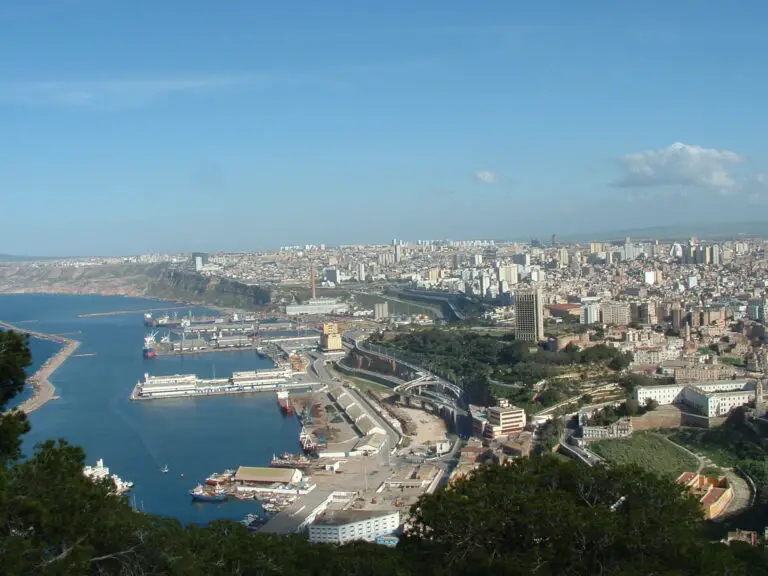
6 Major Ports in Algeria
The People’s Democratic Republic of Algeria is a North African country that enjoys a special geographic position in the Mediterranean Sea. The tenth-largest country in the world, Algeria has a coastline of 1,280 km with 35 fishing ports, 8 general cargo ports, 3 mixed ports, and 2 energy ports. The Ports in Algeria act as…
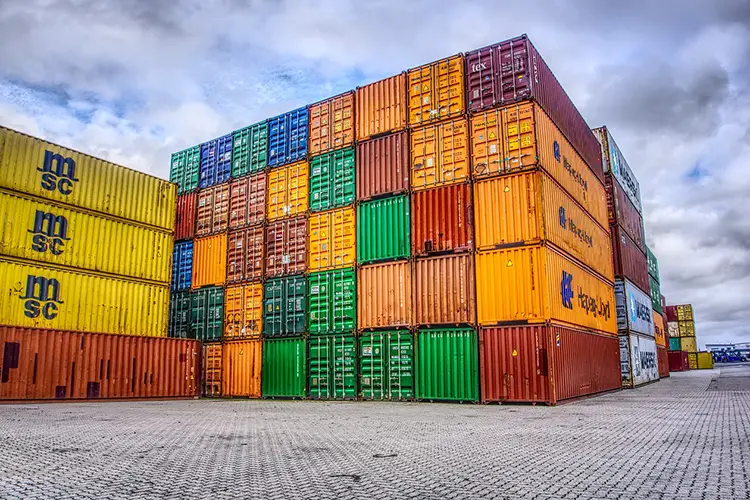
What Are The Different Shipping Container Types, Units, Sizes & Designs Used In Cargo?
It won’t be far-fetched to say that the cargo ships are the lifeline of the world economy. There are many shipping container types, units of varying sizes used in the cargo ships catering to all kinds of freight from cars to clothes. Without them, the seamless transportation of goods across the globe would halt to a…
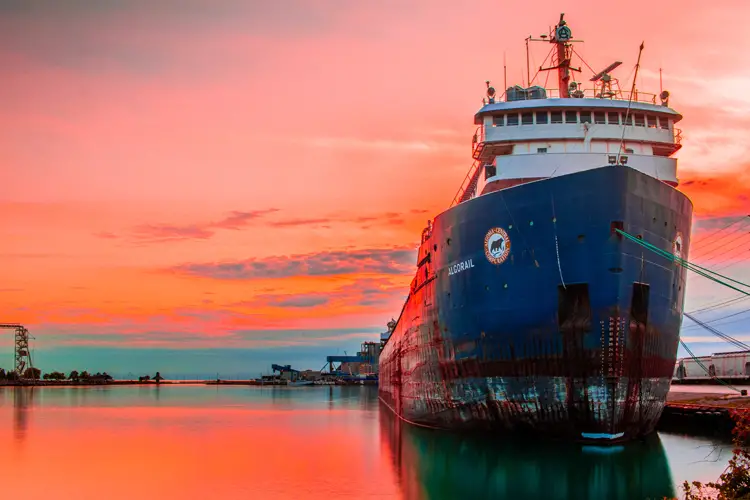
How Does the Corrosion Process Affect Ships?
Boats constantly interact with water, making them susceptible to damage at sea. While ship operators have numerous duties, watching for and preventing corrosion is high on the list. Corrosion causes ship parts to deteriorate over time, compromising the boat’s integrity and leaving occupants vulnerable to accidents. Longevity and efficiency are crucial for ships, considering today’s…
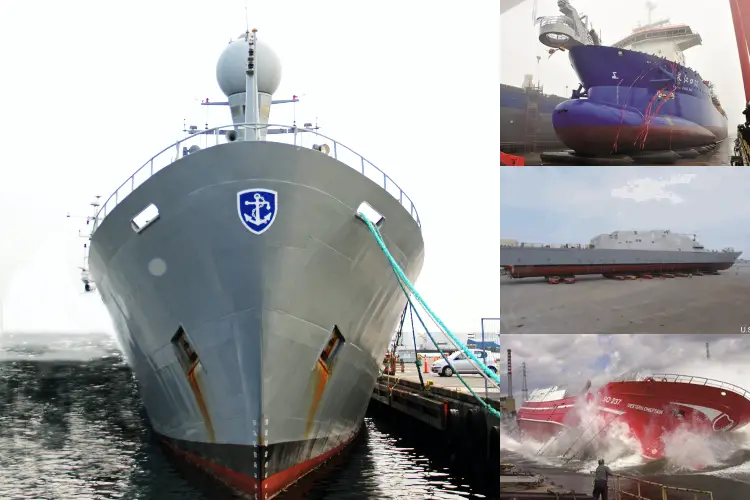
Types of Ship Launching Methods
In this article, we will be discussing various ship launching methods used by shipbuilders. Ship launching is a moment of great anticipation, excitement, nervousness, and elation. It is perhaps the most crucial aspect and nail-biting part of the entire shipbuilding process. The construction of the ship is a very elaborate affair, sailing in a ship…
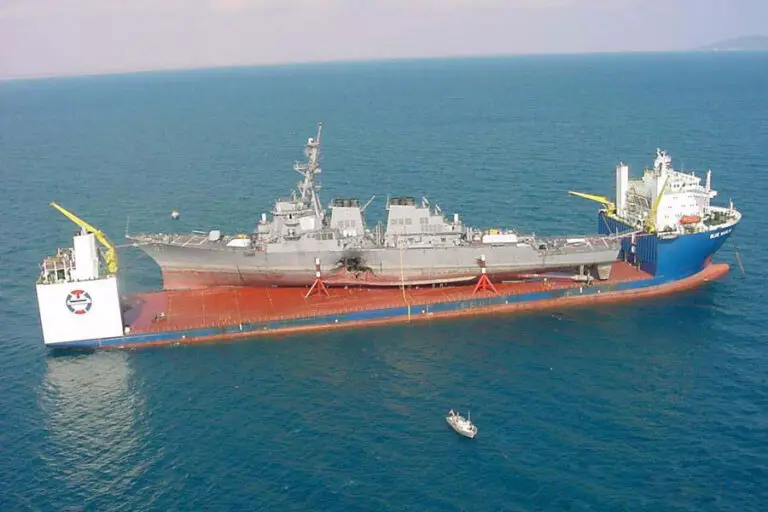
M/V Blue Marlin: Heavy Lift Vessel
Passenger ships and cargo ships sure help us carry huge loads over wide areas. But what happens when they themselves need to be transported from one area to another? This is when float-on/float-off (Flo-Flo) ships or Heavy Lift Vessels like MV Blue Marlin come in handy. A terrorist attack in the year 2000 destroyed one…
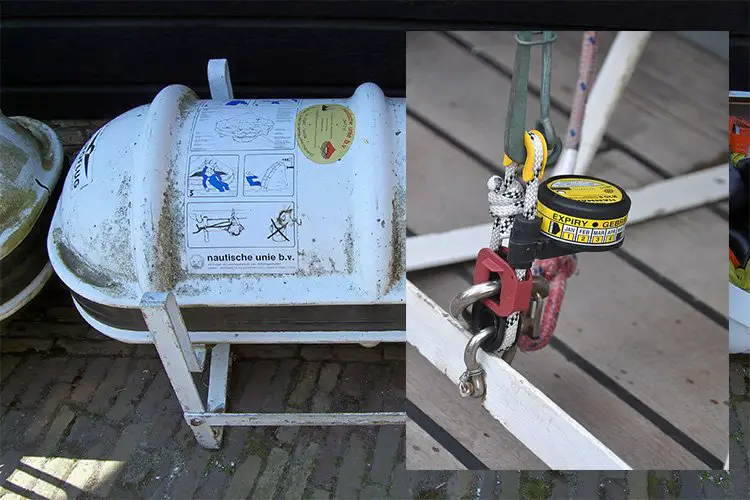
Hydrostatic Release Unit: A Complete Guide
A Hydrostatic Release Unit (HRU) is a pressure-activated mechanism. It is designed to automatically deploy a life raft under certain pressure. In case a vessel sinks, the HRU will activate and release the life raft at a depth between 1,5 and 4 meters. The pressure of the water against a diaphragm within the sealed casing…
Leave a Reply Cancel reply
Your email address will not be published. Required fields are marked *
Save my name, email, and website in this browser for the next time I comment.
This website uses cookies to improve your experience. We'll assume you're ok with this, but you can opt-out if you wish. Read More


Sailing Signals: Nautical Lights, Shapes, & Sounds
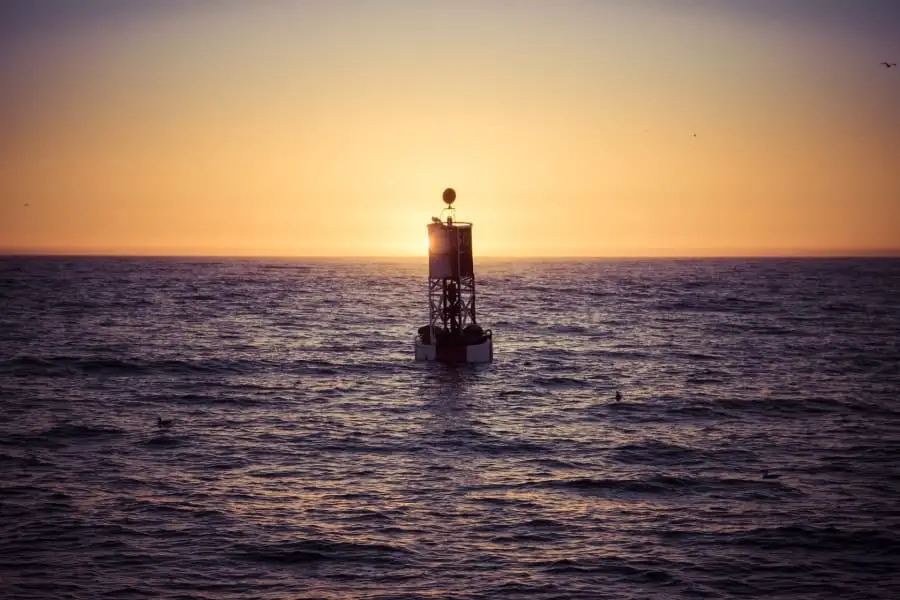
You might be wondering what all those lights, shapes, and sounds that are either attached to a vessel or emanating from them.
While it might not be obvious what these mysterious modes of communication mean, they play a very important role in ensuring the safety and proper communication between vessels and non-vessels alike.
Sailing safety has a lot to do with proper preparedness, which means having the right gear , plan, experience, and mindset. However, sailing safety also requires knowledge in the various forms of communication between vessels and non-vessels. This is where lights, shapes, and sounds play a big role.
By using various lights, shapes, and sounds when out on the water, vessels and non-vessels are able to communicate whether there’s danger afoot, they need help, or simply telling you to get out of the way.
We’ll explore the most common and vitally important light, shape, and sound signals to make sure you’re able to pick up and recognize them when the time is right.
Vessel Lights
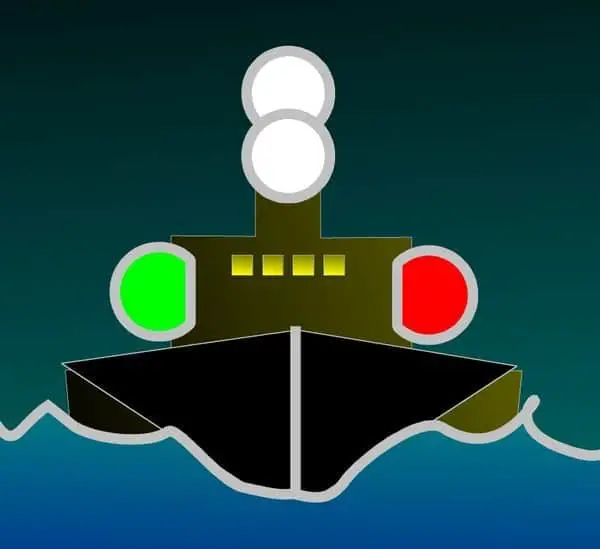
Whenever you see a vessel that has their lights on display, it’s most likely going to be during the evening when it matters most.
The combination of colors and how they’re oriented can mean a world of difference in terms of what they’re trying to communicate, so it’s important to keep an eye out.
The color of lights you’ll see when out on the water include white, red, green, and yellow. Again, you’ll see these on display at night when visual communication between vessels and non-vessels is crucial.
When you see lights on display, you’re essentially being told the vessel’s direction of movement, method of propulsion, and size.
Apart from the basic message of direction, propulsion method, and size, there are other light signals that are there to inform you of other situations. Some of those situations include when a vessel is
- Not under command
- Constrained by draft
- Unable to maneuver
The most important determination, when confronted with a vessel or non-vessel at night, is whether or not there’s a risk of collision.
Obviously, if there’s a risk of collision you need to attempt to communicate with the vessel immediately and to take proper action to avoid a collision. Ideally, you’ll be able to communicate with the other vessel so that you’re both in agreement about who does what to prevent a potential collision.
Basic Lights
As I mentioned previously, there are several basic colors that you’ll see on display from a vessel at night.
However, these lights can be displayed in different ways in terms of position on a vessel as well as how they’re displayed (e.g., blinking or static). Here are some basic definitions of lights that you should know.
Masthead Light
The masthead light is a static white light that sits partway up the main mast of a vessel and only displays to the front 225 degrees of the vessel.
This means that other vessels coming toward yours at an arc of 225 degrees will see an unbroken white light, which will inform them that you are possible head-on.
The sidelights are a pair of static lights that sit fore of the vessel at the bow with one being on the port side and the other on the starboard side.
The light on the port side is a static red light and the light on the starboard side is static green. The combination of both lights covers the same amount of arc as the masthead light, which is 225 degrees.
The sternlight is a static white light that sits as far back as possible aft the vessel at the stern and displays to the back 135 degrees of the vessel.
Other vessels who see this will know that they’re behind your vessel due to the light being lower than if they saw the masthead light and not being able to see the sidelights.
All-Round Light
The all-round light is a static white light that sits at the very top of a vessel’s mast and displays at a full 360-degree angle. You’ll see this light being displayed on a sailboat that’s either docked or at anchor.
Towing Light
The towing light is a static yellow light that sits at the same position as the sternlight and displays at an arc of 135 degrees aft the vessel. As the name suggests, this light indicates to other vessels that it’s currently towing an object.
Underway Vessels
When vessels are on the move and it’s dark out, there’s no doubt that being able to pick out fellow vessels is an important way to avoid any risk of collision .
In all likeliness, you’ll be able to pinpoint another vessel rather quickly at night be observing their lights and determine their position, direction of movement, and size.
Sailing Vessels
When spotting sailing vessels underway at night, you’ll be able to see at a bare minimum their sidelights and sternlight.
By observing which lights you can see and their orientation, you can quickly determine the position at which you’re viewing their vessel. However, depending on the size of the vessel, you’ll definitely see a different combination of lights.
If your vessel is less than 20 meters (65 feet) in length, then all you’ll need to display are the sidelights and sternlights when underway at night.
However, it’s also possible to display a similar set of lights in a different way indicating the same underway conditions, which is when you might see on the very top of the mast a 3-light combination — red, white, and green.
The 3-light combo displays at the same angles as the sidelights and sternlight. The only difference here is they’re situated at the top of the mast.
Sailing vessels underway that are larger than 20 meters will likely have a different set of lights on display, but the difference is huge.
With larger sailing vessels, you’ll still see the sidelights and sternlight with another pair of static lights near the top of the mast where the top light is red and the one below is green.
Power-Driven Vessels
Now, power-driven vessels are bit different when underway at night compared to sailing vessels. For one, a power-driven vessel can be as small or much larger than a sailing vessel, so the number of lights can vary quite a bit.
Also, a power-driven vessel is capable of much greater speeds than a sailing vessel, so ensuring other vessels are aware of their existence at night is very important.
Not unlike a sailing vessel, a power-driven vessel will also have a pair of sidelights and one sternlight. However, there’s an additional light that’s included in this combination and that being the white masthead light.
This 4-light combination will help other vessels like yours be aware that a 15 meter (50 feet) power-driven vessel is underway near them.
But what about the power-driven vessels that are well above the 15-meter size?
Well, the power-driven vessels that are much larger will have the same lights as the smaller power-driven vessel as well as a white static light at the bow that’s slightly lower in height than the masthead light.
This helps other vessels like yours get an idea of just how big this power-driven vessel really is.
Vessels At Anchor
Whenever you’re underway at night, there’s no doubt you want to be aware of other vessels underway to avoid a major collision .
But it’s also the case that you want to be able to spot those other vessels that are at anchor, especially if you’re moving around a marina or bay with other docked or anchored vessels.
Sailing vessels at anchor are very easy to pick out at night since all they need to have on display is their all-round light.
Remember that the all-round light is a static white light that provides a 360-degree view at the very top of a sailing vessels mast, so it’ll be quite difficult to miss. As a matter of fact, a power-driven vessel at anchor also has the same all-round light on display as long as it’s 50 meters (65 feet) or less in size.
For sailing and power-driven vessels that are greater than 50 meters in size, they have to put on display another all-round light.
However, this extra all-round light is placed near the stern of the vessel and is lower in height compared to the all-round light on the mast. This combination of all-round lights should tell you right away that you’re looking at a much larger vessel at anchor.
If you just so happen to see a vessel that’s greater than 100 meters (328 feet) in size and it’s also at anchor, you best believe you’ll see it lit up like a Christmas tree. When it comes to this size of a vessel, they’re required to put as many lights on display as possible.
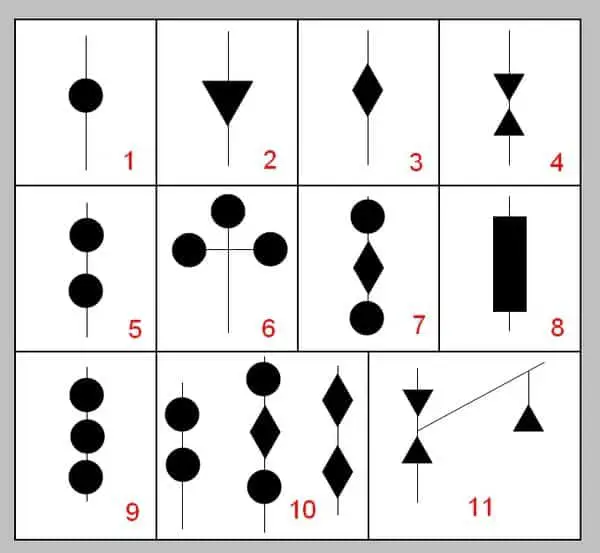
Most of what we’ve covered up to this point has been under the conditions of being underway or at anchor during the evening.
However, arguably more vessels will be out during the day than at night, so it’s important to be aware of other forms of visual communication such as day shapes.
During the day there’s little need for lights to communicate visually to other vessels, which is why we use shapes instead. There are a number of different shapes that take the form of circles, squares, triangles, and more that communicate different messages.
While there are a lot of different day shapes to consider, I want to cover the most common you’ll likely see while out on the water.
Being able to pinpoint a vessel, whether sailing or power-driven, that’s anchored during the day is rather straight forward as you should see a large black sphere hanging between the tip of the vessel’s mast to the fore of the vessel.
This single black sphere should be the size of a basketball and will be attached in the middle of a line.
Motoring and Sailing
If you’re out sailing and have your engine running to help boost your speed, you’ll need to ensure that you have a black, upside-down triangle attached to the middle of your forestay.
Just like the black sphere used to illustrate that your vessel is anchored, your sailboat should have the upside triangle in the same location. It’s important to note that this is only required for vessels that are 12 meters (39 feet) or greater in size.
Diving Operations
If you like to go freediving, scuba diving, or snorkeling, you’ll want to be sure to use the proper diving day shape.
Whether you’re on a small or medium sized vessel, make sure you put up the correct flag at the top of the mast. The most commonly used flag is blue and white while another flag is red with a white slash from one corner to another.
One of the worst situations you can find yourself or anyone else in while out sailing is ending up aground.
If this situation ever occurs, there should be three black spheres, just like the one you would use when anchored out, attached to the top of the mast in a vertical column. It’s important to note that this is only required for vessels that are 12 meters (39 feet) or greater in size.
Not Under Command
There will be times when vessels out on the water won’t be under command, which means you should be aware of this so you can make sure you can avoid them on your course.
Just like a vessel that’s run aground, you should see black spheres lined up vertically at the top of the mast, but instead of three spheres there should only be two. Again, this is only required for vessels that are 12 meters (39 feet) or greater in size.
Restricted Maneuverability
Some vessels can find themselves in situations that simply restrict their ability to maneuver, so being able to put that inability on full display to the rest of the vessels out on the water is rather important.
By putting a black, diamond-shaped object in between two black spheres in a vertical column at the top of the mast, this message is illustrated successfully. Similar to other day shapes, you’ll only find this on vessels that are 12 meters (or 39 feet) or greater in size.
Fishing and Trawling
Fishing is one of the oldest industries in the world and there’s no doubt that you’ll eventually find a vessel fishing and towing along a net.
Whenever a vessel is trawling, you should find two triangle shapes pointing at each other in a vertical column hoisted as high as possible.
There are also a few strange looking flags you’ll find being hoisted in the same location whenever a fishing vessel is either shooting nets, hauling nets, or their nets are caught on the seabed.
Buoys and Marks

Being able to safely navigate around other vessels out on the water is, of course, extremely important, but it’s also important to be observant of non-vessel objects that could get in your sailboat’s way.
Circumventing spots that are potentially dangerous comes first by being able to recognize the various buoys and marks on the water.
There are internationally agreed sets of buoys and marks that ensure safety for traveling vessels all over the world. Thanks to the International Association of Lighthouse Authorities (IALA), we have two major systems to abide by located in two different worldwide regions.
Fortunately, these two regions — Region A and B — have very few impactful differences. Region A (IALA A) covers all of Europe and pretty much the rest of the world while Region B (IALA B) covers the USA, Japan, The Philippines, and Korea.
Major Difference Between IALA A and IALA B
The major difference between the two regions is regarding the buoys which define which side of a channel the vessels should be traveling on.
For example, IALA B has red lights, marks, and/or buoys on the starboard (right) side of a channel when entering a place such as a harbor while under IALA A standards the red lights, marks, and/or buoys are on the port (left) side of a channel when entering.
These are known as lateral or channel marks and define the limits of the water that navigable across a channel.
Port and Starboard Marks
When it comes to buoys and marks that specify the port or starboard side of an object, the port side of an object is red and the starboard side of an object is green.
This is the same for when you’re sailing your boat when it comes to the foremost red and green lights on your vessel.
In regards to specific shapes of port and starboard marks, under the IALA B standards, port marks take the shape of a cone while the starboard marks take the shape of a can.
Safe Water Marks
A Safe Water Mark, also known as a Fairway buoy, is a red and white vertically striped object usually taking the shape of a sphere, pillar, or spar with a red ball on the top for the non-sphere shapes.
This mark usually indicates that you’re entering open and deep waters which should continue as you sail onwards.
Isolated Danger Marks
Having a mark named Isolated Danger Mark isn’t too comforting when you first read it, but it’s one of the most useful marks you’ll find. As the name implies, this mark indicates a location of potential hazard that should be avoided at all costs.
The Isolated Danger Mark should always be red and black horizontal bands with two black balls at the top. It should also have a flashing white light that comes in groups of two flashes.
Special Marks
A Special Mark can carry a number of different meanings, but it’s always displayed in the same way. Special Marks should be completely yellow and have an ‘X’ on the top of it.
A yellow flashing light is also found on the top of the Special Mark and can be seen quite distinctly at night. The reason you could find yourself near a Special Mark is due to it indicating
- Water skiing areas
- Anchorage areas
- Mooring areas
- Waiting areas
- Marine farms
- Historic wrecks
- Protected areas
- Sewerage pipes
- Submarine cables
Cardinal Buoyage System
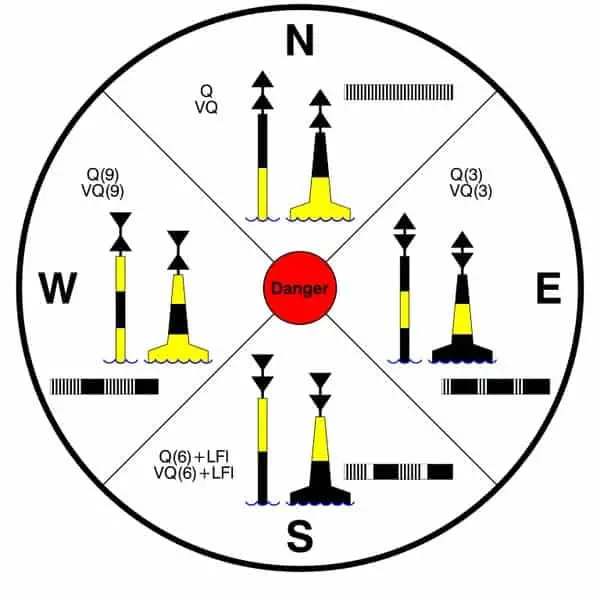
Another useful set of buoys is based on the Cardinal Buoyage System, which was designed to indicate the safe passage around a potentially hazardous area.
These Cardinal Marks are signaling to vessels that there’s an area that’s shallow, contains sunken objects, reefs, rocks, or something else.
By observing the Cardinal Marks, you’ll be able to tell where not to go based on their explicit placement. For example, if you see a North Cardinal Mark, your vessel can safely pass the hazard by traveling North of that marker.
The same goes for South, East, and West Cardinal Marks. Cardinal Marks are always black and yellow horizontally striped pillars.
The North Cardinal Mark is black on the top, yellow on the bottom, has two vertical triangles pointing up, and has a continuously flashing white light on the top.
The South Cardinal Mark is yellow on the top, black on the bottom, has two vertical triangles pointing down, and has a flashing white light on the top that flashes in groups of six followed by one long flash.
The East Cardinal Mark is black with a yellow stripe in the middle, has two vertical triangles pointing outward, and has a flashing white light on the top that flashes in groups of three.
The West Cardinal Mark is yellow with a black stripe in the middle, has two vertical triangles pointing inward, and has a flashing white light on the top that flashes in groups of nine.
Sound Signals
There may be times when you’re out sailing and the visibility is just too poor to be able to point out any buoys, flags, or shapes of any kind. Thankfully, we have light signals that can help us out when it comes to navigation around other vessels and potentially hazardous areas.
However, there may be times when we need to communicate more direct messages much more quickly. If VHF is not an option under these conditions, the use of sound signals is your go-to solution.
“You Are Running into Danger”
There are plenty of useful sound signals to be able to send out as well as recognize when the moment’s right, but there’s one that everyone should be aware of.
When someone yells “heads up!”, it’s likely you’re going to cover your head as soon as possible. When out on the water, the “heads up” can come in the form of two distinct sounds.
When someone is attempting to warn you that “you are running into danger” or you need to inform another vessel of this, you’ll need to know the Morse code word for ‘U’.
The word ‘U’ is presented as a one-second horn blast followed by a 4-6 second horn blast. You can think of this as a short blast followed by a long blast.
In all likeliness, you’ll be the one hearing this sound signal as opposed to you sending it out. Most of the time when this sound signal is used, it’s coming from much larger vessels such as oil rigs, cruise ships, and other vessels of similar size.
Poor Visibility Sound Signals
There are a few sound signals that you should keep in mind when visibility becomes poor while out on the water. Some of the most important include:
- Power underway, making way: one 4-6 second blast and a 2-minute wait.
- Power underway, not making way: two 4-6 second blasts and a 2-minute wait.
- V essel sailing, fishing, not under command, towing, maneuverability restricted: one 4-6 second blast, two 1 second blasts, and a 2-minute wait.
- Last manned vessel of tow: one 4-6 second blast, three 1 second blasts, and a 2-minute wait.
- Warning from vessel at anchor: one 1 second blast, one 4-6 second blast, and one 1 second blast.
- Plot vessel on duty: four 1 second blasts.
- Vessel at anchor: 5 seconds of rapid bell ringing and a 1-minute wait.
- Vessel aground: 3 short bell rings, 5 seconds of rapid bell ringing, and 3 short bell rings.
Maneuvering and Warning Sound Signals
If you ever find yourself communicating with another vessel using sound signals, you’ll definitely need to confirm with one another who’s going to do what so as to avoid the risk of a collision.
Here are some of the most important sound signals you can use to communicate with other vessels.
- I’m altering course to starboard: one 1 second blast.
- I’m altering course to port: two 1 second blasts.
- I’m operating stern propulsion: three 1 second blasts.
- I don’t understand your intentions! I doubt you’re taking sufficient action to avoid collision: five or more 1-second blasts.
- I intend to overtake on your starboard side: two 4-6 second blasts and one 1 second blast.
- I intend to overtake on your port side: two 4-6 second blasts and two 1 second blasts.
- Agreement by overtaken vessel: one 4-6 second blast, one 1 second blast, one 4-6 second blast, and one 1 second blast.
- Approaching blind bend in channel: one 4-6 second blast.
- Reply from vessel on other side of bend: one 4-6 second blast.
Get the very best sailing stuff straight to your inbox
Nomadic sailing.
At Nomadic Sailing, we're all about helping the community learn all there is to know about sailing. From learning how to sail to popular and lesser-known destinations to essential sailing gear and more.
Quick Links
Business address.
1200 Fourth Street #1141 Key West, FL 33040 United States
Copyright © 2024 Nomadic Sailing. All rights reserved. Nomadic Sailing is a participant in the Amazon Services LLC Associates Program, an affiliate advertising program designed to provide a means to earn fees by linking to Amazon.com and affiliated sites.

Your browser is out-of-date! You must upgrade to a different browser to experience this site.
All Chapters
- Boating Terminology
- Boat Hull Types & Designs
- Boat Engine Types Explained
- Boat Size Classifications
- Boat Capacity
- Hull Identification Numbers
- Boat Registration & Titling
- Life Jacket Types & Designs
- Children's Life Jacket Recommendations & Requirements
- PFD Rules & Requirements
- Life Jacket Fitting & Care Guidelines
- Inflatable PFD Types & Tip
- Boat Fire Extinguishers
- Boat Backfire Flame Arrestor
Boat Ventilation Systems
Boat Navigation Light Types & Requirements
Unpowered Boat Navigation Lights
- Visual Distress Signals
- Marine Distress Signals
- Weather Conditions
- Small Craft Advisory
- Boat Maintenance Tips
- Towing & Trailering
- Launching & Retrieving
- Pre-departure Checklist
- Rendering Assistance
- Capsizing/Falls Overboard
- Cold Water Immersion
- Fire Prevention
- Running Aground Prevention
- Accident Reports
This site requires JavaScript. Your browser either doesn’t support JavaScript or you have it turned off.
For this page to function correctly, please enable JavaScript and then refresh the page.
Boat Navigation Lights
One of the most important safety systems on your boat is your set of navigation lights.
Whenever you are operating between sunset and sunrise, or in other times of restricted visibility, such as in fog or rain, you need to display the appropriate navigation lights so that other boats can see you and take the appropriate action to avoid a collision.
In general, all navigation light systems include red and green sidelights, which indicate the port and starboard side of your boat, as well as one or more white lights.
It's also important that you have a flashlight on board, as you never know when a navigation light might burn out. The rules for what navigation lights to display depend on a number of factors including:
- The length of your boat: e.g. under or over 12 meters;
- Whether your boat is being powered by an engine;
- Where you're boating, e.g. inland or international waters; and
- Whether you at anchor.
For now, remember that it's your responsibility to have the proper navigation lighting. Even if you just purchased a new boat, you should check to ensure that you've got the right lights for safe, and legal, boating.
Powered Boat Navigation Lights
When operating between sunset and sunrise, or in periods of restricted visibility, powered recreational boats require the following set of navigation lights. Remember, these power boat light requirements also apply to sailboats when using a motor.
For powered boats less than 39.4 feet, or 12 meters, you need to have the following set of navigation lights.
- One all-around white light that you can see from 360 degrees and from two miles away;
- And one pair of red and green sidelights that are visible at 112.5 degrees and from one mile away.
For boats of this size, the all-around white light needs to be positioned at a height of at least 39 inches above the sidelights.
Figure A shows a boat with this setup.
- All-around white light - 360 degrees visable from two miles.
- Sidelights — 112.5 degrees visible from one mile
If your boat is greater than 39.4 feet but less than 65.6 feet, or 20 meters, you need the following set of navigation lights:
- A masthead light is a white light at the front of the boat. The masthead light needs to be visible across 225 degrees and from two miles away.
- A stern light, which is a white light at the rear of the boat. The stern light needs to be visible across 135 degrees and from two miles away. When the masthead light and the stern light are combined, that makes up 360 degrees.
- Finally, you need one pair red and green sidelights that are visible across 112.5 degrees and from a distance of one mile.
For boats of this size, the masthead light must be positioned at a height of at least 8 feet above the gunnel.
Figure B shows this configuration.
- Masthead light (foward) - 225 degrees visible from two miles.
- Sternlight (aft) - 135 degrees visible from two miles.
- Sidelights - 112.5 degrees visible from one mile.
Boat Navigation Lights at Anchor
We've covered what navigation lights you need to have when you are underway, but what about when you're at anchor?
When your boat is at anchor, but you are not in a designated anchoring area, like at a marina, you need to make sure that you are visible to other boats that may be operating nearby.
When anchoring in these areas, you are required to display an all-around white light where it will be best seen by any other boats in the area.
Navigation Light Requirements for Anchored Vessels

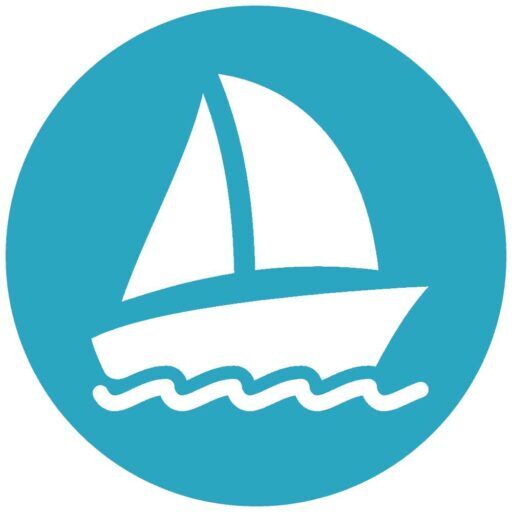
WaterCraft 101
Your guide to fun on the water!
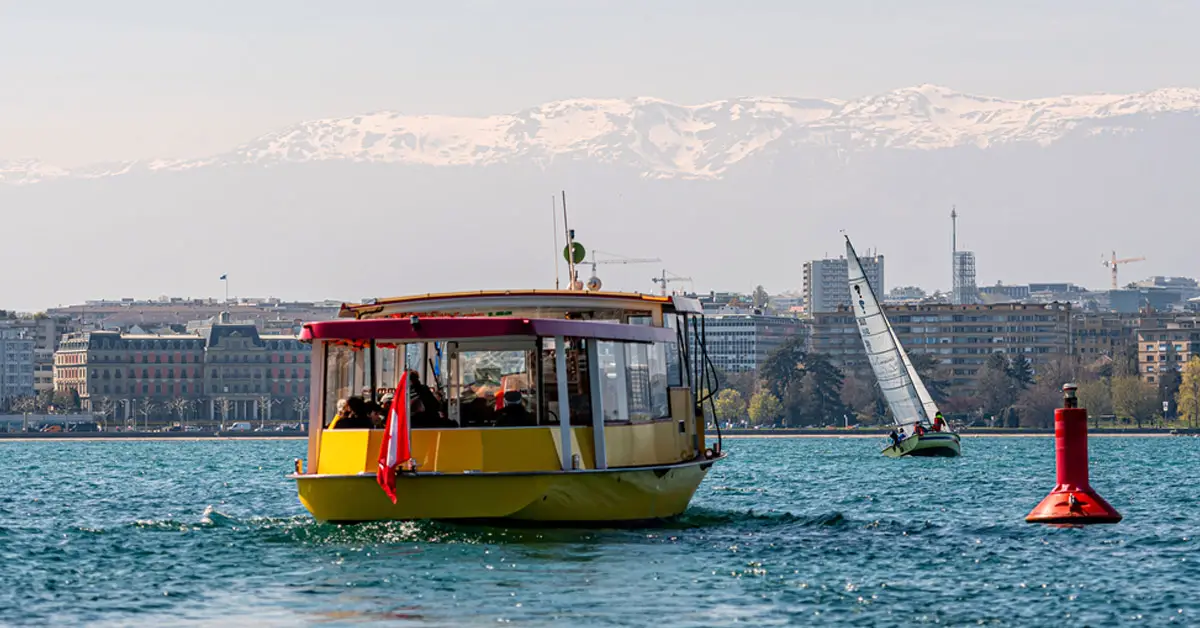
Boating Navigation Lights: Deciphering the Meaning Behind Red, Green, and White Lights
Navigating the waters in the dark or under low visibility conditions can be a challenging experience, especially for novice boaters. Understanding the intricate system of boating navigation lights, including red, green, and white, is an essential skill set that ensures safety at sea. These lights are not merely a decorative aspect of boating; they communicate vital information about the vessel’s position, direction, and size to other watercraft, helping to prevent collisions and misunderstandings.
In boating navigation, red light indicates a vessel’s port (left) side, green for the starboard (right) side, and white lights are used for the stern (rear) or masthead. They help determine the direction and position of boats at night or in low visibility, which is crucial for avoiding collisions on water.
The complex language of boating navigation lights – red, green, and white – often seems mystifying to beginners, causing a sense of intimidation. This article aims to demystify the codes behind these illuminations, providing you with the essential knowledge to correctly interpret the signals.
Whether you’re a boating enthusiast, a professional sailor, or someone intrigued by nautical navigation , this exploration will shed light on the symbolic meanings and the regulatory framework underlying these maritime signals.
Table of Contents
Understanding the Boating Color Code: Red, Green, and White Lights
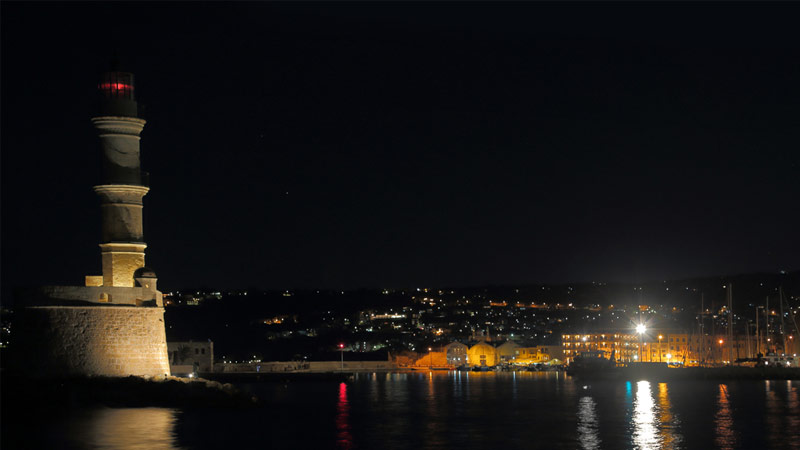
The color code of boating navigation lights – red, green , and white – forms the basis of maritime communication after sunset and during reduced visibility. These colors are not arbitrarily chosen; they each carry a specific meaning and are strategically positioned on the vessel to provide crucial information about its orientation and movement. Let’s delve into each color and its assigned significance:
- Red: The red light is displayed on the port side (left side when facing forward) of the vessel. When another boat sees this light, it indicates they are looking at your boat from its port side.
- Green: The green light is shown on the starboard side (right side when facing forward). If this light is visible to an observer, they view your boat from its starboard side.
- White: White lights have multiple roles. They are used at the stern (back) of the vessel to indicate its rear and as a masthead light to display the boat’s forward direction. The white light at the stern is visible from all directions, while the masthead light is visible from in front and to the sides but not from the back.
Deciphering the Port Side: The Role of Red Lights
The red light on a boat plays a crucial role in nautical navigation, indicating the vessel’s port side. The term “port” in maritime language refers to the left side of the boat when facing forward.
This color is not chosen randomly; red is selected for its high visibility in low-light conditions and its universal recognition as a sign of caution. When another vessel sees the red light on your boat, they’re approaching or seeing your boat from the port side. This allows for clear communication of your boat’s position and direction, helping to maintain order and safety on the water.
Understanding the function of the red light is essential for you and other boaters around you. In situations of reduced visibility or during night-time sailing, the red port light acts as a beacon, indicating your vessel’s orientation and the direction in which it is moving.
Recognizing this light enables other boaters to maneuver their vessels accordingly, significantly reducing the risk of collision. Therefore, ensuring your red port light is functioning correctly and is visible from a sufficient distance is a fundamental aspect of safe and responsible boating.
Decoding the Starboard Side: The Significance of Green Lights
The green light on a boat is equally important as the red light in maritime navigation. Displayed on the starboard side of the vessel – the right side when facing forward – the green light is a clear signal of the vessel’s orientation and direction of movement during nighttime or poor visibility conditions.
When another seafarer sees the green light of your boat, it communicates that they’re viewing your vessel from its starboard side. This allows them to take appropriate action to avoid a potential collision. The green light, therefore, plays a vital role in ensuring maritime safety. It allows for the seamless coordination of multiple vessels sailing nearby or crossing paths. The correct display and functioning of this green starboard light are crucial.
Not only does it help others accurately interpret your vessel’s movement, but it also contributes to the overall predictability and orderliness of maritime traffic. Ensuring your green light is in working order and visible from the appropriate distance is crucial to safe navigation and demonstrating responsible and respectful boating behavior.
Identifying the Stern and Masthead: The Purpose of White Lights
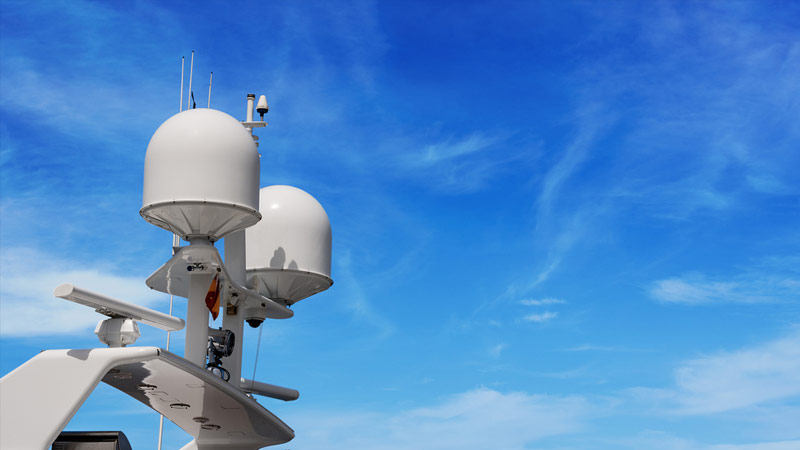
White lights on a vessel serve multiple roles in the maritime navigation system. Primarily, they are used to mark the stern (the rear) of the boat and as a masthead light indicating the forward direction of the vessel. This is critical for other mariners to understand the orientation and movement of your boat during periods of low visibility or night-time conditions.
The stern light is positioned at the back of the boat and is designed to be visible from all directions. When another vessel sees this light, it communicates that they are looking at the rear of your boat. This allows other mariners to understand that your vessel is moving away from them, providing a clear signal to follow at a safe distance if required.
On the other hand, the masthead light is located at the top of the mast and is visible from the front and sides but not from the rear. This light helps other vessels understand that your boat is approaching or moving across their path.
The visibility of the masthead light combined with either the red port light or the green starboard light provides a comprehensive picture of your vessel’s orientation and direction. Proper functioning and placement of these white lights are thus integral to safe and responsible navigation on the waters.
The Regulatory Framework: International Regulations for Preventing Collisions at Sea (COLREGs)
The regulatory framework governing the use of navigation lights in maritime activities is defined by the International Regulations for Preventing Collisions at Sea (COLREGs) . Established by the International Maritime Organization (IMO) , these rules specify the lighting configurations for vessels of different types and sizes under various conditions. The aim is to standardize maritime communication worldwide, minimizing the risk of collisions and enhancing overall safety at sea. Let’s delve into the key aspects of this regulatory framework:
- Application: The COLREGs are applicable to every seafaring vessel on the high seas and all connected waterways that are navigable by seagoing vessels. This encompasses everyone from large commercial ships to small recreational boats.
- Lighting Specifications: The rules provide detailed specifications for the type, color, intensity, and positioning of lights. For example, a power-driven vessel underway must exhibit a masthead light forward, sidelights (red for the port side, green for the starboard side), and a stern light.
- Visibility Range: The COLREGs set out the required visibility range for different lights based on the vessel’s length. Larger vessels have longer visibility requirements.
- Special Circumstances: The rules also cover lighting configurations for special circumstances, such as vessels at anchor, towed vessels, fishing vessels, and vessels not under command or restricted in their maneuverability.
- Responsibility: Every vessel must, at all times, maintain a proper lookout and operate at a safe speed. Even with adherence to the lighting rules, it is the responsibility of each mariner to avoid collisions using all available means.
The Importance of Navigation Lights in Ensuring Maritime Safety
Navigation lights hold paramount importance in ensuring maritime safety. They are the primary method of communication between vessels during times of low visibility or darkness. By providing crucial information about a vessel’s size, type, activity, and direction, navigation lights help to prevent collisions and maintain order on the water.
These lights allow for the identification of vessels from a distance, giving other mariners ample time to understand the situation and take appropriate action. For example, if a vessel is seen displaying only a white light, it’s assumed to be at anchor. Conversely, a vessel showing a red and white light is understood to be a sailing vessel with another vessel on its port side.
Without these lights, the risk of accidents and collisions would increase exponentially. For this reason, the International Regulations for Preventing Collisions at Sea (COLREGs) have established stringent rules governing the use of navigation lights. These rules ensure a standardized system of communication that mariners around the globe universally understand.
Navigation lights serve as the “traffic lights” of the waterways. Just as road users rely on traffic lights for safe and orderly movement, mariners depend on navigation lights to safely navigate the waters.
The Anatomy of a Vessel: Placement and Visibility of Navigation Lights

The placement and visibility of navigation lights are crucial aspects of maritime safety, serving as key elements of a vessel’s anatomy. Each light is strategically positioned on the boat to communicate specific information about the vessel’s orientation, activity, and direction of movement. The visibility of these lights is also regulated to ensure that they can be seen from appropriate distances. Let’s break down the key principles for the placement and visibility of navigation lights:
- Port Light: The red light is located on the port side (left side when facing forward) of the vessel. It should be visible from a vessel approaching from the port side.
- Starboard Light: The green light is placed on the starboard side (right side when facing forward). It should be visible from a vessel approaching from the starboard side.
- Stern Light: The white light at the stern should be positioned to be visible from any direction behind the boat.
- Masthead Light: This white light is located at the top of the mast. It should be visible from the front and sides of the vessel but not from the rear.
- All-Round Light: Some vessels also use all-round lights (visible from all directions) for specific purposes, like indicating that the vessel is at anchor. These lights can be any color but are typically white.
- Visibility Range: The required visibility range of these lights varies depending on the size of the vessel. For instance, for power-driven vessels less than 12 meters in length, the port and starboard lights should be visible from a minimum distance of 1 nautical mile, while the masthead light should be visible from 2 nautical miles.
Ensuring the correct placement and visibility of navigation lights is a fundamental aspect of maritime safety, enabling effective communication between vessels and helping to prevent collisions on the water.
Best Practices for Maintaining and Checking Your Boat’s Navigation Lights
Maintaining and regularly checking your navigation lights is essential for all mariners. These lights ensure your safety and that of others sharing the waterways with you. Here are some best practices for maintaining and checking your navigation lights:
- Regular Checks: Before setting out, check all navigation lights to ensure they work correctly. Remember, it’s not only about your safety but also about communicating your position to other vessels.
- Cleanliness: Keep the lights clean. Dirt and grime can significantly reduce their effectiveness, making them harder to see from a distance. Use a soft cloth and non-abrasive cleaning solutions to maintain their clarity.
- Bulb Replacement: Always keep spare bulbs on board. Navigation lights can fail when you least expect them, and having spares can mean the difference between a safe journey and a dangerous situation.
- Power Supply: Regularly check your power supply. For boats that use battery-powered navigation lights, checking the battery charge and having a backup power source available is essential.
- Visibility and Positioning: Ensure the lights are positioned correctly per the COLREGs and visible from the required distances. Also, ensure that no equipment or structures on the boat obstruct the lights.
- Professional Inspection: Have your navigation lights inspected professionally at regular intervals. This can help identify missed issues and ensure your lights comply with regulatory requirements.
Remember, as a responsible mariner, you should never compromise on your navigation lights’ maintenance and operational effectiveness. They are your primary means of communication in low visibility conditions, essential to maritime safety.
Bryan is a Las Vegas resident who loves spending his free time out on the water. Boating on Lake Mohave or Lake Havasu is his favorite way to unwind and escape the hustle and bustle of the city. More about Bryan.
Similar Posts
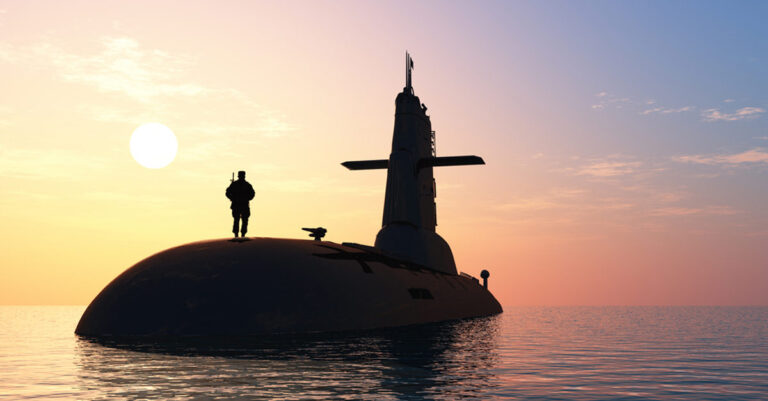
Why is a Submarine Called a Boat? Nautical Terminology of Boats & Submarines
The world of nautical terminology can be complex and confusing, especially for those unfamiliar with it. From jargon to acronyms, countless terms and phrases have been used for centuries, many of which have evolved and changed over time. One such term that has puzzled many is using the word “boat,” to refer to a submarine….
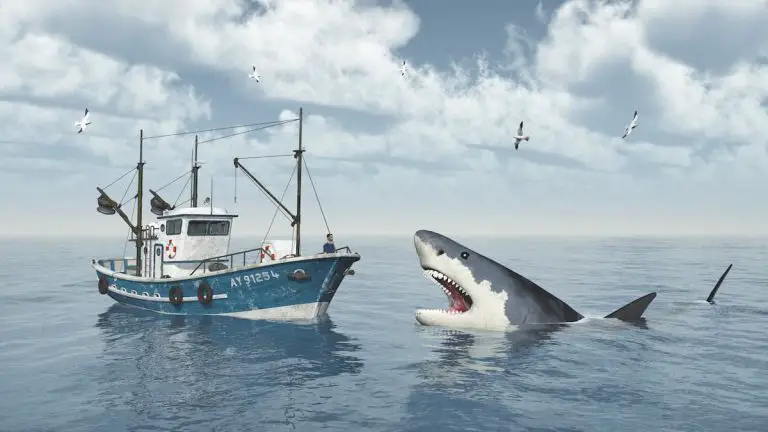
Are Sharks Scared Away by Boat Motors? (The Truth!)
Sharks are intimidating, but they shouldn’t keep you from enjoying your time in or on the water. Instead, it would be best to understand them, so you know what attracts them and what’ll drive them away. For example, take boat motors: Can their rotating wheels and whirring sound scare sharks? Sharks aren’t scared away by…

Pontoon vs. Speed Boat: Which Watercraft Suits Your Lifestyle and Needs?
Navigating boat ownership’s vast, uncharted waters might feel like steering through a storm without a compass. In the great sea of choices, two vessels rise above the waves and beckon with a promise: a sturdy pontoon and a sleek speed boat. Choosing between a pontoon and a speed boat hinges on your lifestyle and needs….
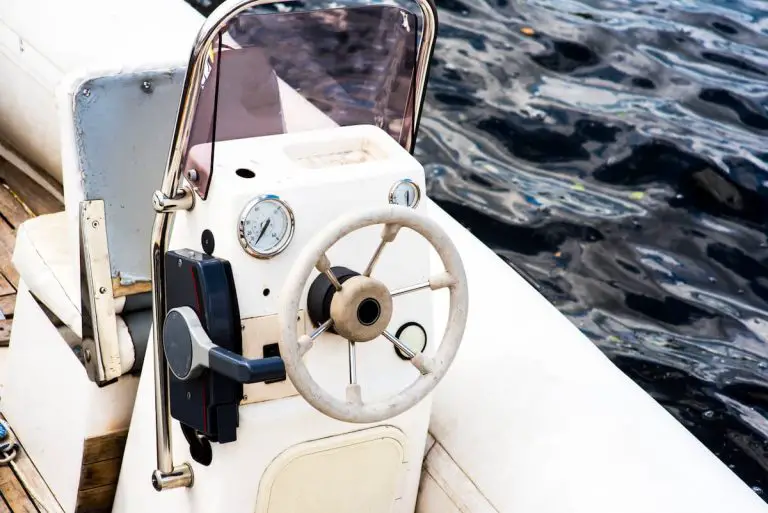
Are Boat Steering Cables Universal? (Explained)
No matter what type of boat you have, it likely has a steering cable. In fact, most boats rely on these cables to help them maneuver. But are boat steering cables universal? Boat steering cables are generally universal. The 3300/33 type control cable is the most popular and typically works with most boats. There may…
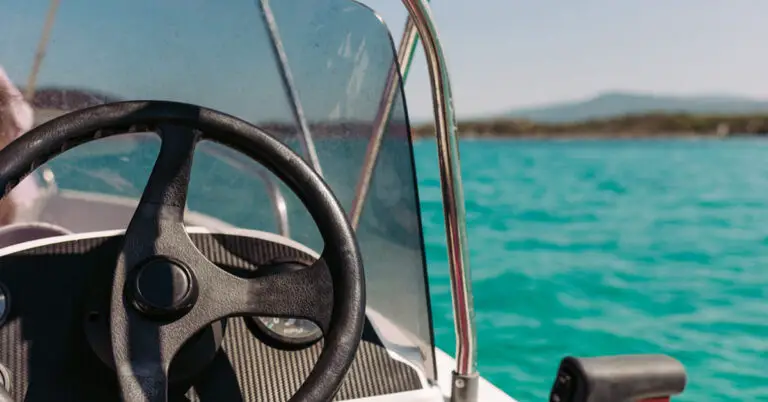
Is It Correct to Say ‘Drive a Boat’ or ‘Sail a Boat’? The Answer Depends on Your Craft
When operating a watercraft, the language used to describe the act can be a source of confusion. Some may say they “drive a boat,” while others say they “sail a boat.” The truth is the correct term to use depends on the type of vessel being operated and the method of propulsion. For larger vessels,…
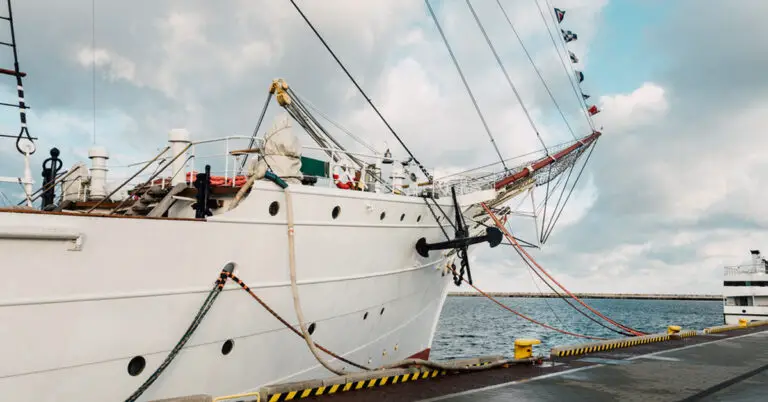
What Are the Holes on a Boat? Understanding the Different Types and Purposes
Boats have been an essential mode of transportation and a staple of human culture for centuries, with varying designs and functionalities. Throughout history, boat designs have been adapted to meet the needs of specific maritime activities, from fishing and trade to leisure and warfare. One fascinating aspect of these vessels that often captures our attention…

The Exclusive Provider of Long Barrier Float Buoys. Dismiss
- Protecting Lives and Preserving Waterways for Over 20 Years
- Login / Register
No products in the cart.

- Regulatory Buoys
- 1428 Float Collar Buoys
- Mooring Buoys
- Custom Buoys
- Marine Lights & Accessories
- Anchor Kits
- Buoy Restoration Kit
- Mooring Hardware
- Cables and Chains

- Tough Seal™
- Why Choose Us
Boating , Boating Safety , Navigation Lights
Boat navigation lights: what each color represents.
Understanding boat navigation lights is a basic safety requirement when you take to the water in your vessel. As a boat owner, it’s up to you to have the correct lights installed on your boat and have them colored and calibrated in the correct way. When all boat owners use their lights properly and understand the lights of other boats that they see, the safety of everyone on the water is protected.
White Lights
White lights give you an overview of the vessel since they are either all around, mast or stern. *All around lights. As the name implies, all around lights project a full 360º circle of light. They would be projected from the center of the boat and need to be visible for 2 miles. *Masthead lights. They shine from 112.5º on the port side of the boat through dead ahead to 112.5º on the starboard side. Therefore, the arc of illumination is 225º. Masthead lights must always be located above side lights (which are colored). For boats less than 39.4 feet, visibility range is 2 miles; for those over 39.4 feet, it is 3 miles. *Stern lights. These lights shine aft 135º (67.5º on each side). The visible range of illumination should be 2 miles.
Red/Green/Bicolor
Colored lights are always sidelights and the different color indicates the side. Red lights are located portside, and green are starboard. The lights shine from dead ahead to 112.5º aft on either side of the vessel. On some boats, sidelights can be combined into one bicolor light. For boats less than 39.4 feet, the visible range should be 1 mile; for those over 39.4 feet, it is 2 miles.
For sailboats that are less than 7 meters long, the general boat navigation lights apply. If, however, regular marine lights cannot be used or installed practically, there is another option. Your sailboat must have an electric torch or lantern that emits a highly visible white light that you can deploy in time to prevent collisions.
Powerboats need to have a masthead light forward, sidelights and a stern light. Vessels less than 12 meters in length can have an all around white light and sidelights. Powerboats on the Great Lakes may carry an all around white light instead of a second masthead light and stern light combination. Sidelights may be combined into a single bicolor light fixed at the centerline of the boat.
Boat navigation lights are required between sunset and sunrise, and at any other times of reduced visibility. These lights can indicate the size of the boat, what it’s doing, and what direction it’s going. Boat lights are an essential way for vessels to communicate with one another.
walshproducts
- All 1428 Float Collar Buoys Anchor Kits Barrier Floats Buoy Restoration Kit Marine Lights & Accessories Mooring Buoys Regulatory Buoys Search for:
- Image Column
Username or email address *
Password *
Remember me Log in
Lost your password?
Boat Navigation Light Rules
Does your boat meet the boat navigation light rules? Check in here to learn all about those green and red boat lights.
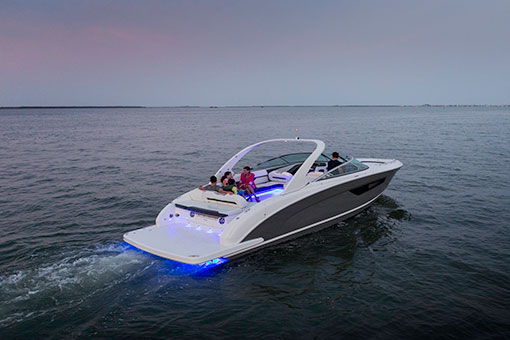
Basic boat navigation light rules are set by the U.S. Coast Guard, and may be augmented by state or local requirements as well. You can look at all of the USCG navigational rules , but we can set out the basics regarding what lights are required on a boat here:
- All boats under seven meters which cannot exceed seven knots – Sail and power boats of this size can display an all-around white light, and may display green and red side lights as well.
- Powerboats under 12 meters – Must show an all-around white light visible from 360 degrees (generally called a masthead light) and red and green side lights visible at 112.5 degrees placed above the hull and at least one meter below the masthead light. Or, they may have a masthead light visible at 225 degrees plus a stern light visible at 135 degrees. Side lights must be visible from one nautical mile, and masthead and stern lights must be visible from two nautical miles.
- Sailboats under 12 meters – Must show green and red side lights (meeting the same requirements as those found on a powerboat) and a white stern light, or, may show a tri-colored masthead light.
- Powerboats up to 20 meters – Side lights, masthead, and stern lights are all required as listed above; side and stern lights must be visible to two nautical miles and masthead lights to three nautical miles.
- Sailboats up to 20 meter – Must show side lights and a white stern light or tricolored masthead light as listed above; all must be visible to two nautical miles.
- All boats over 20 meters – Must show lights as listed above but masthead lights must be visible at five nautical miles.
- All boats at anchor – An all-around white light visible for at least two nautical miles must be displayed.
Now that you know what lights need to be on a boat in reduced visibility, it’s important to remember a few other key points that people sometimes forget.
- First off, note that if a sailboat is operating with an engine running, it’s considered a powerboat under the rules and must be lighted accordingly.
- Secondly, remember that it’s your personal responsibility to make sure these lights are operational. Just having them aboard isn’t enough so before every trip, it’s a good idea to flip the switches and verify that everything is working properly.
- Third, if your boat has docking lights leave them off while operating in open waters. Boats don’t have headlights and those with forward-facing white beams are intended to be illuminated while docking, only.
- Finally, check your state and locality rules and make sure you meet these as well, because in some areas there may be additional requirements.
Where to Put Navigation Lights on a Boat
Most of the time, deciding where to put navigation lights on a boat has already been done for you. Modern boats will leave the factory with proper lighting already installed and you won’t have to worry about it. If you have to replace any lights, the safest move is to simply mimic the original placement and type.
When it comes to small craft, however, like jon boats or dinghies , the boat may not come equipped with any lights at all. In fact, they may not have the electrical systems and switch panels necessary to run lights, should you want to add them. In this case you’ll want to get portable lights.
Portable navigation lights which are battery-powered may be attached to the boat with clamps, suction cups, or bases that fit into fishing rod holders. These work just fine, as long as you make sure the batteries are fresh and carry a spare set. To some degree, where you put them may depend on the boat itself and what mounting options are available. That said, if you use portable green and red boat lights, they should be placed facing forward at the bow of the boat as close to the centerline as possible. White all-around lights should be at or near the stern if practical, but in this case the most important thing is to make sure they’re clearly visible. A light on a short pole can easily be blocked from view by a person or obstruction, so it needs to be elevated higher than anything and anyone on the boat.
Following the boat navigation light rules and requirements isn’t just necessary under the law, it’s also an important aspect of safe boating. We all want to make sure our days — and nights — spent aboard a boat are as safe as possible, so be sure your boat’s navigation lights are up to snuff.
To make sure you’re up to date on all aspects of boating safety, be sure to check out our Boating Safety Guide .
Read Next: Boat Safety Checklist & Safety Equipment

Join Our Newsletter!
Get community news, buying bargains, and how-to guides at your fingertips.

Boat Navigation Light Rules Explained (For Beginners)
Boat navigation light rules can be a little difficult for newcomers to understand. This is probably because these light rules can change depending on a wide variety of factors.
Failing to comply with these rules can leave you open to enforcement violations as well as lawsuits.
Also, knowing these rules will help keep you and other boaters safe while out on the water, so you must learn and remember them.
Here’s everything you should know about the boat navigation light rules.
Table of Contents

Why Have Boat Navigation Light Rules At All
Boat navigation light rules help boaters communicate with each other. They also help to determine who has the right of way. This is important as it determines what actions boats will take as they pass one another.
Without these guidelines, there would be many more accidents out on the water as people wouldn’t know how to interact.
Remember, when you’re out on the open water, there aren’t any designated lanes to follow, and without rules, boaters can easily become confused about which way they should turn or whether or not they should even turn at all.
On top of this, these rules help establish methods for boaters to tell each other when they’re anchored or when they’re in distress. Use your lights correctly when you need help, and you’re much more likely to get it.
When do I Need to Follow Boat Navigation Light Rules?
Light rules apply any time between sunset and sunrise. They also apply any time visibility is low.
An example of this could be during foggy or rainy weather.
A more unusual example of this could be during a solar eclipse. Basically, if you feel that having the lights on will help others see you better, it’s a good idea to turn them on.
The Different Light Rules by Boat and Size
Different types of boats will have different light rules that they need to follow. These sets of rules are broken down based on whether the boat is a sailboat or a powered boat.
Once this is established, the rules are then broken down by size.
The different sizes to consider are boats shorter than 39.4 feet, boats sized between 39.4 and 65.6 feet, and boats greater than 65.6 feet.
If you’re wondering why the numbers are so precise, it’s because this is the conversion from meters. 39.4 feet equals 12 meters, and 65.6 feet equals 20 meters.
Generally, all boats will have a red light on their port side and a green light on their starboard side. To put it in plain English, if you’re in the driver’s seat, the red light goes on the left, and the green light goes on the right.
A white light should be at the stern of the boat. The stern is the rear of the boat.
Powered Boat Light Placement

Here are the lights you’ll need when operating a powered boat, depending on the size of the boat you’re operating.
- Boats less than 12 meters or 39.4 feet long:
You’ll need one red light and one green light at the front port and starboard sides of the boat for these boats. These lights should be positioned so that they can be seen at an angle of 112.5 degrees. The sidelights should be strong enough to be seen from a mile away.
You’ll also need to mount them towards the bow of the boat. This is otherwise known as the front of the boat.
Additionally, you’ll need one white light that can be seen from all angles. It should be strong enough to be seen from two miles away.
This light will need to be mounted at least 39 inches or 99 centimeters higher than the red and green lights.
- Boats greater than 12 meters or 39.4 feet but less than 20 meters or 65.6 feet:
With boats of this size, you’ll still need your red and green lights, but your white lights will change.
In this case, you’ll mount a red light to your port or left side and a green light to your starboard or right side. These lights will need to be seen from an angle of 112.5 degrees, and they’ll need to be seen from a distance of one mile.
The two white lights will need to be mounted at the stern and masthead of the boat. Stern lights can also be referred to as the aft light. Either way, it just means the light at the back of the boat.
This light will need to be seen from a 225-degree angle facing the rear. It needs to be strong enough to be seen from 2 miles away.
The masthead light is at the forward position of the boat. This light is mounted on the masthead, and it must cover a 135-degree angle.
The light will need to be visible from 2 miles away.
Masthead lights must be mounted at least 8 feet above the gunnel. The gunnel is the top edge of the side of the boat.
- Boats larger than 20 meters or 65.6 feet long:
To operate a non-commercial boat over 20 meters or 65.6 meters long, you’ll have to have the same lights in the same positions as the smaller boats. However, you’ll also need to add matt black inboard screens to your sidelights.
Sail Boats and Other Unpowered Boats

These boats can be broken down into two different size categories.
These two categories are under 23 feet or 7 meters and boats that are over 23 feet or 7 meters.
Unpowered boats such as sailboats, rowboats, and kayaks under 23 feet in length only need to have a white light on them. This white light can be anything from a flashlight to a lantern.
However, you can still opt to place red and green lights at their appropriate places.
Larger sailboats will need to have a 135 degree white light at the stern and 112.5 degree red and green lights at the port and starboard sides. The white light should be visible from 2 miles away, while the red and green lights should be visible from 1 mile away.
Alternatively, a tri-color light could be placed on the masthead.
This light will have all three lights built into it, and it should be visible from at least 2 miles away.
Advice For All Boats Regarding Light
Regardless of what boat size you’re on, it is a good idea to have a flashlight with you.
If your boat lights become inoperable, you’ll at least have one light that you can signal with.
Should you find yourself on the water at night in a disabled boat , your flashlight may be the only thing keeping you from being crashed into.
Light Rules For Boats at Anchor
When you’re anchored at a marina or dock, you won’t have to worry about specific boat light rules and regulations.
However, when you’re anchored out on the water, you must follow boat light rules as this will help keep other boaters from running into you.
It will also help establish that you have the right of way so you won’t have to move every time a larger boat comes your way.
Of course, having the right lights doesn’t mean you’ll be able to anchor just anywhere. You’ll still have to follow any inland rules when it comes to anchoring your boat.
When anchored, you’ll need to display an all-around white light that lets other boaters know your position. This light should be placed where other boaters can best see it. For example, a sailboat might put this light at the top of its mast. Also, another all-around white light might be placed near the deck to help identify your anchored boat to nearby boats.
Boats Under Distress
Boats under distress should display what is known as a visual distress signal so that they can get help. At night, these distress signals will come in flares, parachute flares, and lights.
You should have at least three devices on your boat to use for signaling.
This could come in a variety of forms, and you can use the same one three times. For example, your three devices could be having three signaling flares with you.
Only use these lights when you’re in danger. Failure to do so can result in heavy fines and potential imprisonment.
Determining Who Has The Right of Way
When you come across another boat, and you can only see a white light, then you’ll know that you’re either approaching an anchored vessel or a vessel that is moving in front of you. In this case, you can overtake them and go around them from either side.
If you come across a green light and a white light, then you have the right of way. In boating terms, this means that you are the stand-on vessel.
Technically speaking, the other boat should give way, and you won’t have to worry about changing your course.
However, there is always a chance that the other person will not give way for some reason, and you should be ready to move. You never know, the other boater may not see you, or they may not know the rules as they should. Remember, being right won’t mean anything if you end up dead in a boat crash.
If you come across a red and white light, you are the one that needs to give way. In this case, you’ll want to slow your boat down and pass by them, probably behind their path.
In all of these scenarios I described, you were in a powered vessel, and you were passing a powered boat or a sailboat that was driving while under power.
However, what happens when you encounter a sailboat or other unpowered vessel in a powered vessel?
In this case, you’ll see a red light, a green light, or a white light, but you won’t see all three. Regardless of what you see, you’ll want to give way. This is because these boats can’t maneuver as well as you, and they probably won’t be able to get out of your way before you come across them.
At this point, you can see why different boats need different types of lights and why it’s important to use the lights that apply to your particular craft. Use the wrong lights, and you’ll confuse the other boaters around you. This could easily lead to an accident that could have easily been avoided.
What About Boaters Who Are Color Blind?
Unfortunately, people who are color blind won’t safely operate a boat at night by themselves.
Also, they won’t be able to get a captain’s license as you need to pass a color blind test to get this license. Here’s an article we wrote about all you need to know about boat license types (with prices) .
If you’d like to do some recreational boating at night, but you can’t differentiate between the colors red and green, you might want to consider bringing a friend along.
This way, your friend can tell you what colors you’re coming up on so that you can safely navigate yourself past other boats.
4 Types of Boat Lights
- The red and green lights that go on the sides of a boat are known as sidelights.
- White lights that only face backward are known as stern lights, and white lights that face forward are known as masthead lights.
- An all-round white light is a white light that faces 360 degrees. These lights are used on smaller boats and on boats that are at anchor. They can be replaced by making use of a stern light and a masthead light.
- Another type of light is the tri-color light. A tri-color light can be used on a sailboat to portray the white, green, and red lights. Bi-color lights are also available for small powered boats and sailboats. These lights display both red and green light.
The combination of lights that are displayed will always give the boater a 360-degree field of light.
This ensures that other boaters can see them no matter where they are in relation to each other.
Safety Precautions To Be Aware Of
Even new boats can have lights that weren’t configured correctly or lights that don’t work.
It’s important that you check these lights before you head out on the water.
This is true even if you don’t intend on staying out after dark. After all, it’s always possible that you could become stranded until after dark or that it could become too foggy to operate out on the water without lights.
Other Things You Should Know About Boating At Night
Boat navigational light rules are critical for nighttime boating, but there are other things to consider as well.
One thing to consider when boating at night is the use of a lookout.
Having one of your passengers act as a lookout will make it more likely that you’ll spot problems in advance.
Remember, other boaters aren’t the only potential hazards you can run into at night. Shallow shipwrecks, low water depths, and unlit piers, docks, and jetties can also become hazards if they aren’t noticed in time for you to avoid them.
High beams should be used for docking purposes only. This is because using them while on the water can confuse other boaters.
Also, the high beams can shine into other sailor’s eyes and can give them night blindness.
Just think about it this way.
It isn’t safe to drive towards another car with your high beams on, so why would it be safe to drive towards another boat with high beams on?
Driving Speed
Nighttime boating should be done at slower speeds than day time boating. The primary reason for this is that visibility is more limited at night.
Driving slower will help to give you more time to react to boaters and other hazards.
When you first start boating, you’ll still have to take a moment to think about the lights you see. Driving at a slower speed will give you this additional time without affecting your safety.
Not All Lights On The Water Are Boats!
I’ll end this post with a funny story I once heard about a boat traveling at night. This story has changed many times over the years, but the gist of it’s still the same.
It goes like this:
A large vessel was traveling at night when they came across a white light in front of them. The ship captain immediately got on the radio and contacted the other vessel to demand that they get out of the way.
The other vessel responded by telling the captain to change his course. To this, the captain responded with, “This is the warship, the USS Enterprise, and I demand you change course, or we’ll be forced to take action!”.
To this, the other vessel responded with, “This is a lighthouse, and you are on course to become shipwrecked.”.
This isn’t a real story, and now that you know proper boat navigation light rules, it is a story that could never happen to you.
If you came across a white light and thought it was a boat, you’d assume it was unpowered or at anchor, and you’d take steps to go around it.
Click to share...
- Pontoon Boats
- Personal Watercraft
- nauticalknowhow
- Nautical Knots
- Tools and Calculators
Understanding Boat Navigation Lights
Boat navigation lights are essential when you’re out on the water. They’re essential, but it’s easy to misunderstand their uses and correct placements.
If you don’t know the correct placement for your stern lights or know what type of navigation light you need on your mast, don’t worry: we’re here to help. Below, we’ve got an overview of everything you need to know about boat navigation lights: what type of navigation lights you need, where to put them, and why you need to use them.
So without further ado, let’s learn more about boat navigation lights.
What navigation lights are required on a boat?
The U.S. Coast Guard Navigation Rules, International-Inland encompasses lighting requirements for every description of watercraft. The information provided there is intended for powerboats and sailing vessels less than 20 meters. The various options are illustrated.
The U.S. Inland Rules apply inside the demarcation lines at the entrances to inlets, bays, rivers, etc. The demarcation lines are shown on coastal charts as magenta dashed lines. Once outside of the demarcation lines, International Rules apply.
Powered Vessels
Power boats less than 20 meters shall exhibit navigation lights as shown in Figure 1. (Note: 2 masthead lights are optional for vessels under 50 meters. Vessels over 50 meters will display two masthead lights.)
Vessels of less than 12 meters in length, may show the lights in either Figure 1 or Figure 2.
Powerboats less than 7 meters whose maximum speed cannot exceed 7 knots may exhibit an all-round white light, and if practicable sidelights instead of the lights prescribed above, in international waters only.
Sailing Vessels and Vessels Under Oars
Sailing vessels less than 20 meters may exhibit the navigation lights shown in Figures 3 or 4.
Another option for sailboats is to use a single combination lamp at the top of the mast as shown in Figure 5.
Sailing vessels less than 7 meters may carry an electric torch or lit lantern showing a white light to be displayed in time to prevent collision (see Figure 6 – left picture).
If possible, the lights prescribed for sailing vessels less than 20 meters should be displayed.
Vessels under oars may display the lights prescribed for sailing vessels, but if not, must have ready at hand an electric torch or lighted lantern showing a white light to be displayed in time to prevent collision (see Figure 6 – right picture).
Small boats can benefit from using a temporary LED light with a suction cup attachment if permanent fixings aren’t possible.
Shapes and Lights
To alert other vessels of conditions that may be hazardous, there are requirements to display lights at night and shapes during the day.
Anchored Vessels
Powered vessels and sailing vessels at anchor must display anchor lights. An anchor light for a boat less than 50 meters in length is an all-around white light visible for 2 miles exhibited where it can best be seen (see Figure 7).
Vessels at anchor shall exhibit forward where best seen, a ball shape (see Figure 8).
Vessels less than 7 meters are not required to display anchor lights or day shapes unless anchored in or near a narrow channel, fairway or anchorage, or where other vessels normally navigate.
Anchor lights are not required on vessels less than 20 meters, anchored in special anchorages in inland waters designated by the Secretary of Transportation.
Sailing Vessels Under Power
Vessels under sail also being propelled by machinery, must exhibit forward where best seen, a conical shape with the apex pointing down (see Figure 9).
Vessels less than 12 meters are not required to exhibit the dayshape in inland waters.
Sailing vessels operating under machinery, or under sail and machinery are considered as powered boats and must display the lights prescribed for a power-driven vessel.
Restricted Maneuverability
The Navigation Rules require vessels restricted in their ability to maneuver to display appropriate day shapes or lights. To meet this requirement, recreational vessels engaged in diving activities may exhibit a rigid replica of the international code flag “A” not less than one meter in height or at night display the navigation lights shown in Figure 10.
This requirement does not affect the use of a red and white divers flag which may be required by state or local law to mark a diver’s location. The “A” flag is a navigation signal indicating the vessel’s restricted maneuverability and does not pertain to the diver.
Navigation lights should be checked prior to departing the dock and you should always carry spare bulbs. The USCG doesn’t care if they were working when you left, only that they are working when required.
Where do navigation lights go on a boat?
The current navigation light requirements are found in the Navigation Rules, International-Inland, and in Parts 81, 84, and 89 of Title 33, Code of Federal Regulations . They’re easy to find, but many sailors and boat manufacturers do not have a good understanding of the rules governing the proper installation of navigation lights. To help clear up any misunderstandings here’s all you need to know:
Sidelights that are installed in the contour of the bow without providing a mounting surface tooled to be parallel with the fore and aft centreline of the boat are not in compliance with the Inland or International Navigation Rules. Depending on the breadth of the boat near the bow and how far aft from the vessel’s stem the lights are mounted, this shift can be more than 20 degrees in some cases. Installing the fixtures too far aft of the vessel’s stem may result in the sidelights not being visible from a position dead ahead.
Another factor in the proper installation of sidelights is that they must maintain their required minimum intensity in a vertical sector from 5 degrees above to 5 degrees below the horizontal. They must also maintain at least 60 percent of their minimum required intensity from 7.5 degrees above to 7.5 degrees below the horizontal. Installing flush-mounted sidelights, designed to be mounted to a vertical surface in the hull contour, without providing a mounting surface tooled to be vertical, shifts the vertical coverage sector. This also results in non-compliance with the Inland or International Navigation Rules.
Additionally, most of these flush-mounted sidelights are installed below the vessel’s rub rail. International Navigation Rules require that sidelights be installed above the uppermost continuous deck. Therefore, this configuration would not be in compliance with International Navigation Rules.
When separate red and green sidelight fixtures are used, the masthead light or all-round white light, whichever configuration is installed, must be located as close as practical to the vessel’s fore and aft centerline. For vessels less than 12 meters in length, the masthead light or round lights may be displaced from the fore and aft centerline providing that the sidelights are contained within a common fixture and mounted on the vessel’s fore and aft centerline. The masthead or round lights must be installed at least one meter (3.3 ft.) above the sidelights.
Which navigation lights are you required to display when anchoring your boat for the night?
Boating at night (or in reduced visibility) can present some special challenges. Not only is your depth perception lessened, but bright lights on the shore can also cast misleading reflections on the water and if you wear glasses, or worse yet bifocals, you simply don’t see as well at night as you do during the day.
It is not only important that you be able to identify other vessels operating in your proximity, it is equally important that other vessels see you. Most recreational vessels are less than 30 feet in length and, according to the Rules of the Road, shall be equipped with navigation lights.
These lights not only have a certain arc through which they can be seen but must be seen from a minimum distance. The following lighting requirements are for recreational vessels less than 12 meters in length. (approximately 39.4′)
The arc of the lights and color allows you to determine the direction a boat is moving. How good are your boat’s lights? You should test them to check your nighttime visibility, or you might land yourself in hot water with the Coast Guard.
Whether on a trailer or at the marina, switch on your lights and see how well they can be seen. Walk away from the boat or row away, if you are at anchor or at a mooring, and see how visible the lights are as you move further away. How easy are they to see against the background of lights onshore?
Does your stern light shine dead astern over the required 135º arc or does it shine to one side or up or down? Can it be seen from the required 2 miles and why is that important? As an example, let’s say that your stern lights can only be seen for 1/2 mile. You are underway at 8 knots and a large ship is approaching at 15 knots. The ship is only 4 minutes away from a collision with you. By the time the ship “might” see you, identify the light, and decide on how to move, it is too late. A ship traveling at 15 knots may take miles to stop.
Look at the stern lights again, as you move from the stern toward the bow, does the stern light “disappear” as the sidelight “appears”? The stern light should disappear and sidelight appear at 22.5º abaft the beam. If you don’t see the green starboard sidelight or the red port side light when the stern light disappears there is a problem with the arc of one or all these lights. This means that if another boat were approaching you at the angle where no lights are seen there is an increased risk of collision.
If both the stern lights and side lights are seen brightly at the same time you still have a problem. A boat approaching won’t know whether they are overtaking or crossing and whether they should give-way or stand-on.
You should also check to make sure that your masthead light disappears at the same time each side lights disappear and they both disappear when the stern light appears.
Check your sidelights from dead ahead. You should see both red and green. However, by moving toward one side just 1-3º you should then see only one light. If you still see two lights, an approaching boat won’t be able to tell which direction you’re are going.
It is very important to be seen from a distance but also for an approaching boat to be able to determine your direction of travel.
When boating at night remember the following: “When two lights you see ahead, turn your helm and show your red”.
About Chris
Outdoors, I’m in my element, especially in the water. I know the importance of being geared up for anything. I do the deep digital dive, researching gear, boats and knowhow and love keeping my readership at the helm of their passions.
Categories : nauticalknowhow
Robert Hogward on September 12, 2021
Thanks for writing this post. I can either place them on the exterior or interior for decorations. Placing them on the exterior side is helpful when I go fishing and indulging in other night activities in the water.
Dalton Bourne on July 26, 2022
We love the lights! We put lights from Seaponer on my Jon boat right above the water line and use them for night fishing! The amount of brightness it offers is an assurance of my boat’s being seen clearly during the night. At the same time, the LED lights don’t consume too much energy, leading to a life span of up to 50,000 hours.
Leave a Reply Cancel reply
Your email address will not be published. Required fields are marked *
Save my name, email, and website in this browser for the next time I comment.
More in nauticalknowhow

How to Tie a Boat to a Dock

How to Clean a Boat Cover

Everything You Need to Know About Your Boat’s Bilge Pump

4 Ways to Tie Your Boat Shoes

The People’s Poncho Review and Ratings

Oru Lake Kayak Review

What Is A Gunwale?

131 of the Best Hawaiian Boat Names

167 Patriotic Boat Names
About boatsafe.
Established in 1998, BoatSafe is your independent guide into the world of boating, fishing, and watersports. We provide expert insights and detailed guides to help you find products tailored to your needs and budget.
Contact Boatsafe
- Address: 4021 West Walnut Street. Rogers, AR 72756
- Phone: (479)339-4795
- Email: [email protected]
Site Navigation
- How We Test
- Corrections Policy
- Privacy Policy
- Terms & Conditions
- Editorial Policy
- Affiliate Disclosure
Our Reviews

All content is © Copyright 2024. All rights reserved.
- Upcoming Course Schedule
- Testimonials
- Get a Conservation ID
Sailboat Lights
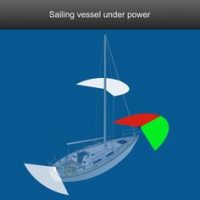
Sailboat Lights can be confusing and usually need some explanation.
Common Questions:
Is the tri-color light all I need when under power? Are the red and green lights at the top of the mast all I need? Am I supposed to turn any of these off? How then do I let others know I am under power? If you are under power, you of course need your mast head light illuminated, correct? (As seen here on the left). What if there are no pulpit or stern lights on your vessel? Shouldn’t you always use your mast lights? This is confusing!
Let’s talk it through:
Mast head lights can also be seen on power boats. Take a look at this image shown in the rules. It shows a power-driven vessel longer than 50 meters using two mast head lights.

Here is the definition of a mast head light in the rules:
A “Masthead light” means a white light placed over the fore and aft centerline of the vessel showing an unbroken light over an arc of the horizon of 225 degrees and so fixed as to show the light from right ahead to 22.5 degrees abaft the beam on either side of the vessel.
Note: It does not say the light must be at the top of the mast.
What is the tricolored light for?
Well, it is at or near the top of the mast and is for sailing vessels less than 20 meters or 65.5 feet in length. It is an optional alternative to having the lights down on the hull or pulpits. The tri-color light at the top of the mast faces a white light to the aft 135 degrees plus red from directly forward around to port 112.5 degrees and a green light directly forward and around to starboard 112.5 degrees.
This makes up 360 degrees and meets the requirement for a sailboat sailing .
So, when the sailboat turns on its engines it must also, in addition to the tri-color light at the top of the mast , display a white light 225 degrees facing forward. You can call this light whatever you’d like but it must exist. Now these particular white lights that we preferably call mast head lights , shall be visible from 6 miles. Note: It does not mean they have to be at the top of the mast. On power vessels they are typically at the top of the mast because that is what the mast is for.
Here is a sailing vessel under sail using a tricolored light. There is no forward-facing white light, like in the upper picture, so we know it is under sail.

To clarify, on a sailboat less than 50 meters in length, a white under power mast head light can be just up the mast anywhere. That is to say that it’s not part of the tri color. It is white and faces forward 225 degrees and indicates a sailboat is under power.
Where the confusion lies:
You also might be confusing the term mast head light with the two all-around red and green lights at the top of the mast. These are not mast head lights. They can be used in addition to the hull or pulpit mounted red, green, and white. A sailing vessel cannot display a top of the mast tricolored light AND the two all-around red and green at the top of the mast. Above all, the mast head is white 225 deg forward facing to be used under power only.
Pictured, the Vessel on the left is utilizing the optional two all-around red and green lights. Subsequently, this states that it is under sail or underway and not under engine power.
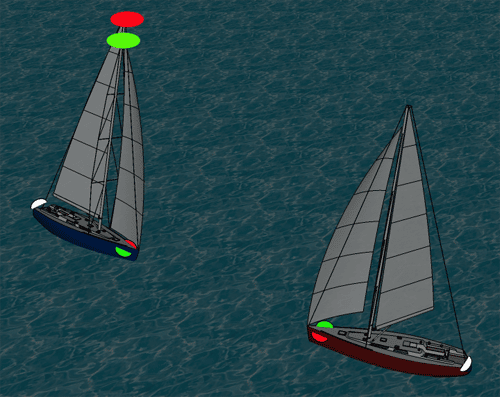
To further understand this picture, here are the rules as stated:
Rule 25 – Sailing Vessels Underway and Vessels Under Oars
(a) A sailing vessel underway shall exhibit:
(i) sidelights; (ii) a stern light
(c) A sailing vessel underway may, in addition to the lights prescribed in Rule 25(a), exhibit at or near the top of the mast, where they can best be seen, two all-round lights in a vertical line, the upper being red and the lower green, but these lights shall not be exhibited in conjunction with the combined lantern permitted by Rule 25(b).
In Conclusion:
You can further investigate using the United States Coast Guards book on Navigation Rules… NavRulesAmalgamatedwAnnexes.pdf (uscg.gov)
We are proud to discuss navigation lights in our Public Course please visit our Schedule any time. We teach all of our classes live in a virtual setting
NASBLA 2022 Accomplishments
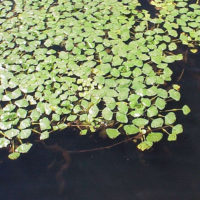
Clean Drain and Dry
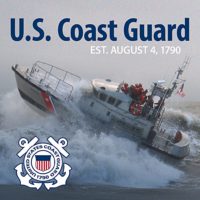
United States Coast Guard

Boating Tips for Beginners
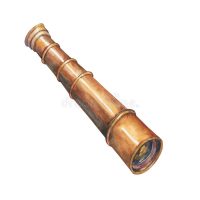
Keeping a Lookout
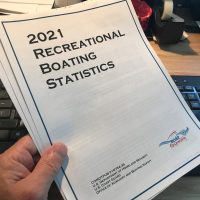
2021 Boating Accident Report Notables

Rules of the Road
Right of way rules.
Whenever you meet another boat, it’s like approaching an unmarked intersection in your car. Knowing a few, simple right of way rules will help you avoid a collision. Just as motorists must know what to do when approaching a four way stop, every crossing situation at sea is like approaching an unmarked intersection.
Because there are so many different types of boats and styles of boating, it is important to know what to expect when you come upon another vessel.
"Vessels" are anything that floats on the water that is used, or is capable of being used as a means of transportation on water. A log, a bathtub and many other things could be considered a vessel under the Navigation Rules. The Navigation Rules distinguish one vessel from another by both its design, and by its actions. This section covers maneuvering rules only.
There are other navigation rules that you are required to know. Sound Rules are covered under the Sound Signaling Equipment section. Light Rules are covered under the Navigation Light Equipment section.
The Rules of the Road are published by the U. S. Government Printing Office, and are available in any boating supply stores. Every boat owner should have a copy, but they are mandatory to be kept on vessels over 12 meters (39.4 feet) in length.
The Rules generally used in this course are Inland Rules, unless otherwise noted. There are small but important differences in the Rules depending on where you are operating your boat. It is your responsibility to know the Navigation Rules for your boating area.
- International Rules - Apply to all vessels upon the high seas and in all waters connected to them that are navigable by seagoing vessels.
- Inland Rules - Apply to all vessels upon the inland waters of the United States, and to vessels of the United States on the Canadian waters of the Great Lakes to the extent that there is no conflict with Canadian law. Certain inland waterways may have specific provisions that apply to certain vessels.
- Great Lakes - Includes the Great Lakes and their connecting and tributary waters including the Calumet River as far as the Thomas J. O'Brien Lock and Controlling Works (between mile 326 and 327), the Chicago River as far as the east side of the Ashland Avenue Bridge (between mile 321 and 322), and the Saint Lawrence River as far east as the lower exit of Saint Lambert Lock.
- Western Rivers - Includes the Mississippi River, its tributaries, South Pass, and Southwest Pass, to the navigational demarcation lines dividing the high seas from harbors, rivers, and other inland waters of the United States, and the Port Allen-Morgan City Alternate Route, and that part of the Atchafalaya River above its junction with the Port Allen-Morgan City Alternate Route including the Old River and the Red River.
Vessel Types
- Power Driven Vessel - Any vessel propelled by machinery. This includes any boat that has an engine. Sailboats are considered powerboats when they are being propelled by a motor - even if the sails are up.
- Sailing Vessel - Any vessel under sail alone. Remember, if being propelled by a motor, a sailboat is considered to be a powerboat.
- Vessels Engaged in Fishing - Means any vessel fishing with nets, lines, trawls or other fishing apparatus which restrict maneuverability, but does not include a vessel fishing with trolling lines or other fishing gear which doesn't restrict maneuverability. This means a shrimper out of Galveston is "engaged in fishing" Someone out trolling for stripers in their Grady-White is NOT considered to be engaged in fishing under the Rules.
- Seaplanes - Are any aircraft designed to operate on the water.
- Vessels Constrained by Draft - Means that a vessel can't deviate from a course/channel because they might run aground. A freighter in a narrow channel is an example of this. Note: This is for International waters only, not Inland.
- Vessels Restricted in Their Ability to Maneuver - Means a vessel that can't maneuver as required by the rules because of the size or operation of the vessel. A fishing vessel pulling in nets and a buoy tender placing a buoy are both examples of a vessel restricted in their ability to maneuver.
- Vessels not under Command - Any vessel that for some exceptional circumstance is unable to maneuver as required by the Rules, and is therefore unable to keep out of the way of another vessel. If Joe boater slips and knocks himself out, and can no longer steer--that's a vessel not under command. If the steering cable goes out, and you can't turn the boat, that's a vessel not under command. If the captain is not paying attention and hits another boat, that's negligence.
- Underway - Means that you are not anchored, moored, at the dock, or aground. If you are even drifting along, you are underway.
- Restricted Visibility - Means any condition such as fog, mist, falling snow, rain, or other similar causes that make it difficult to see other vessels. Losing your glasses is NOT restricted visibility.
Rule, Rule, Rule your Boat
It may seem as if you can do anything you want while you are on the water (You might also think that it looks as if everyone else is going crazy on the water). Boating on a crowded waterway can be scary! The good news is that there are rules to govern the action of each vessel. The bad news is that many vessel operators do not know the rules!
Not complying with the Rules - even if you don't know them, can get you in trouble on the water. Even if you think you are following the Rules, if there is something that you can do to avoid a collision - you must do it, even if you deviate from a different Navigation Rule.
It is your responsibility as the ship's captain to be aware of your surroundings at all times, and to operate your vessel in a safe manner. Caution may not be fun, but having an accident sure stinks.
The Rules state that every vessel shall use all available means appropriate to the prevailing conditions to determine if a risk of collision exists. If there is any doubt, such risk shall be deemed to exist.
Rules Explained
The Rules are designed to tell you what to do when you operate your vessel near other vessels. The purpose of the Rules of the Road is to help you avoid an accident--not to establish responsibility or liability if you get into an accident. - Remember, if you get into an accident, you can be held liable, even if you followed the Rules to the letter!
Your primary obligation is to operate in a safe manner. Under the Rules, there is no "right-of-way" like there is on a street. For most situations, Boats are called one of the following.
- Give-Way Vessel - If you are the Give-Way vessel, you must act as if the "stand-on" vessel has the right to keep going the way it is going. It is your responsibility to signal your intentions to the stand-on vessel, and it is your responsibility to maneuver your boat around the other in a safe manner. Also known as a "Burdened" vessel, as it has the burden of.
- Stand-On Vessel - If you are the Stand-On vessel, it is your responsibility to acknowledge the intended actions of the give-way vessel. You must also maintain your current course and speed until the give-way vessel passes, or you enter a dangerous situation.
Operator Responsibilities
In addition to the Rules, you have other responsibilities as the captain as well. You are responsible for the safety of everyone aboard your vessel at all times--and you have a responsibility to those with whom you are sharing the water.
- You must always operate at a safe controlled speed for the situation in which you are boating, and any legally mandated speed requirements that there may be, such as a slow/no wake zone.
- Take care to avoid careless, reckless or negligent boat operations--such as operating too closely to other vessels, boating under the influence, or operating at an unsafe speed for the given conditions.
- Steer clear of naval vessels, and other restricted facilities such as bridges, power plants and dams. New Homeland security measures require it, as does your safety! For more information, see the Homeland Security pages.
Finally, as a boater, you have a responsibility to all other boaters--and all others who enjoy the water--to be courteous and respectful of others. This means that you should always watch your boat noise (a legal requirement) avoid congested waters as much as possible, avoid disturbing wildlife and sea grasses, and look out for the safety and well being of other boaters by giving a hand to those in need.
The Pecking Order
There is a "pecking order" that can be used as a simplified memory aid to determine right of way for vessels of different types. Get very familiar with this list, as it is important to understand it thoroughly. The lower most vessel on the list is the give way vessel, and must stay out of the way of vessels that are higher on the list.
- Overtaken vessel (top priority)
- Vessels not under command
- Vessels restricted in their ability to maneuver
- Vessels constrained by draft
- Fishing vessels engaged in fishing, with gear deployed
- Sailing vessels
- Power driven vessels
Collision Avoidance
- Rules apply to vessels in all conditions of visibility. Rules are the same at night or in fog, for instance, as they are during a bright sunny day.
- Every vessel must maintain a proper look-out by sight and hearing at all times. Operator inattention and not having an adequate look out are a leading cause of accidents each year.
- Every vessel must proceed at a safe speed at all times. Several factors should be considered when determining safe speed, including but not limited to the state of visibility, traffic density, your vessel's maneuverability, with special reference to stopping distance and turning ability. At night, consider the presence of background lights such as those from shore, or from the back-scatter of your vessel's own lights. Consider also the state of wind, sea, and current, and the proximity of navigational hazards.
- The Rules specifically require that any action taken to avoid collision, if the circumstances allow, will be positive, made in ample time, and in keeping with good seamanship. Any changes in course or speed should be large enough to be readily apparent to the other vessel. This means that you should avoid last second changes in course, and you should avoid a small series of changes. Change direction early, and make a large turn.
Maneuvering
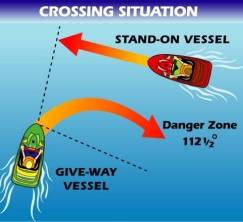
The main situations of collision risk are overtaking, meeting head-on, and crossing. When one of two vessels is to keep out of the way (give-way vessel), the other, the stand-on vessel, must maintain course and speed. The stand-on vessel must take avoiding action when it becomes apparent that the vessel required to give way is not taking appropriate action.
The Crossing Rule
Both International and Inland Rules state that when two power-driven vessels are crossing so as to involve risk of collision, the vessel which has the other on her starboard side (the give-way vessel) must keep out of the way.
As the give-way vessel it is your duty to avoid a collision. Typically, this means you must alter speed or direction to cross behind the other vessel (the stand-on vessel).
At night, if you see a red light crossing right-to-left in front of you, you need to change your course. If you see a green light crossing from left-to-right, you are the stand-on vessel, and should maintain course and speed.
The Meeting Situation
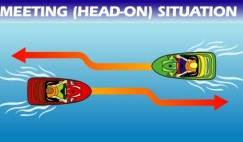
At times there may be some doubt whether the situation is a crossing or a head-on meeting. In case of doubt, you should assume that it is a meeting situation, in which neither vessel has a clear-cut "right-of-way," and each must act to avoid the other. Each vessel in a meeting situation must alter course to starboard so that each will pass on the port side of the other. At night, you will recognize a head-on meeting situation if you see both red and green side lights at the same time.
The Overtaking Situation
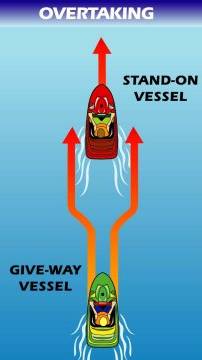
Any vessel overtaking any other vessel must keep out the way of the vessel being overtaken. The former is the give-way vessel and the latter is the stand-on vessel.
This rule applies even if the overtaking vessel is propelled by wind, oars, or rubber band paddlewheel.
A vessel is deemed to be overtaking when coming up with another vessel from a direction more than 22.5 degrees abaft (behind) her beam. This is the angle prescribed by the stern light.
At night, the overtaking vessel will see only the white stern light of the vessel being overtaken. If you see either side light, it is a crossing situation.
Operating in a Narrow Channel
First and foremost, you have to avoid larger vessels that can only travel in a channel. Even if your vessel is operating under the rules otherwise, you must give way to a boat that could potentially run aground or get into a collision if they left the channel.
Try and operate on the edge of the channel. Be extra cautious if you come to a bend in the waterway, and can't see traffic coming towards you.
You may sound a prolonged blast as a warning to traffic headed your way.
On the Great Lakes and Western River system, vessels going downstream are stand-on, vessels going up stream must give-way.
Potential Collision Situation
When the distance between two vessels decreases and the relative angle of the other vessel off the bow remains the same, then you will soon be trying to occupy the same spot in the water - a collision situation. Change course or reduce speed, even if you are the stand-on vessel.
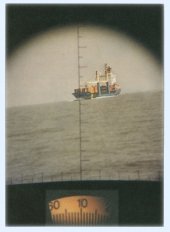
Conduct of Vessels During Periods of Restricted Visibilty
Operating a boat in areas or at times of restricted visibility requires extra concentration by the skipper and the lookout. You must operate your vessel at a speed at which you can identify and react to a situation and still have enough time to avoid a collision. This is especially important when vessels are no in sight of one another.
- Operate at a safe speed for the prevailing circumstances
- Have engines ready for immediate maneuvering - including reverse
- Don't rely on radar or other electronic imaging alone - use your buiilt in senses at all times
- Take avoiding actions early and provide ample time for the other vessels to maneuver
- Avoid sharp turns if being overtaken
- Always - you are in doubt, reduce your speed
- Every vessel shall at all times proceed at a safe speed
Other Rules
Whether under inland or international rules, power vessels must keep clear of sailing vessels in open waters. A sailboat with motor running is defined as a motor boat. The "pecking order" between sailing vessels is more complex. When two sailing are approaching one another so as to involve risk of collision, one of then shall keep out of the way of each other as follows.
- When each has the wind on a different side, the vessel which has the wind on the port side shall keep out of the way of the other.
- When both have the wind on the same side, the vessel which is to windward shall keep out of the way of the vessel which is to leeward.
- If a vessel with the wind on the port side sees a vessel to windward and cannot determine with certainty whether the other vessel has the wind on the port or the starboard side, she shall keep out of the way of the other.
- For the purposes of these rules the windward side shall be deemed to be the side opposite to that on which the mainsail is carried. On square-rigged vessels, it shall be deemed to be the side opposite to that on which the largest fore-and-aft sail is carried.
Now that you are familiar with "The Rules," go out and use them in passing, meeting, and crossing situations you find on the water. You will get many puzzled looks from inexperienced boaters with no training or testing.
Remember, if a collision does occur, your proper use of the correct signals and appropriate actions will win you points! But you know enough now to avoid a collision.
The navigation rules of the road contained in this course summarize basic navigation rules for which a boat operator is responsible. Additional and more in-depth rules apply regarding various types of waterways and operation in relation to commercial vessels and other watercraft. It is the responsibility of a boat operator to know and follow all the navigation rules.
For a complete listing of the navigation rules, refer to the document “Navigation Rules of the Road” published by the U.S. Coast Guard (COMDTINST 16672.2 Series) and available through the U.S. Government printing office or on the web here .
For state specific navigation requirements, refer to the state laws where you intend to boat.
- Entertainment
- Newsletters
Man suffers ‘significant lacerations’ after airboats crash in Broward’s Everglades area
Fire rescue flies man to memorial regional hospital.
Matthew Leach, Photojournalist
Andrea Torres , Digital Journalist
Joyce Grace Ortega, Assignment Desk Editor
BROWARD COUNTY, Fla. – Fire rescue personnel helped an injured man after two airboats collided Sunday morning in southwestern Broward County’s Everglades area.
Broward Sheriff Fire Rescue personnel responded at about 10:30 a.m., to an area west of where Krome Avenue and Okeechobee Road meet at the county line.
Recommended Videos
BSFR Battalion Chief Michael B. Kane reported personnel met the injured man at Mack’s Fish Camp where the Gladesmen Airboat Tours operate off Danell Lane.
He had “sustained significant lacerations to the side of his body,” Kane wrote in a statement.
Fire rescue used a helicopter to quickly fly him from the camp to Memorial Regional Hospital in Hollywood.
“He is currently recovering from his injuries,” Kane wrote.
The Florida Fish and Wildlife Conservation Commission was tasked with investigating the boat crash. Broward Sheriff’s Office deputies were also at the scene.
Copyright 2024 by WPLG Local10.com - All rights reserved.
About the Authors
Andrea torres.
The Emmy Award-winning journalist joined the Local 10 News team in 2013. She wrote for the Miami Herald for more than 9 years and won a Green Eyeshade Award.
RELATED STORIES
Man faces charges after airboat with 10 people flips in everglades, man bitten by crocodile in florida everglades after capsizing sailboat, falling in water, multiple people rescued after airboat flips in everglades; driver arrested.
- Election 2024
- Entertainment
- Newsletters
- Photography
- Personal Finance
- AP Investigations
- AP Buyline Personal Finance
- AP Buyline Shopping
- Press Releases
- Israel-Hamas War
- Russia-Ukraine War
- Global elections
- Asia Pacific
- Latin America
- Middle East
- Election Results
- Delegate Tracker
- AP & Elections
- Auto Racing
- 2024 Paris Olympic Games
- Movie reviews
- Book reviews
- Personal finance
- Financial Markets
- Business Highlights
- Financial wellness
- Artificial Intelligence
- Social Media
Red, yellow, green ... and white? Smarter vehicles could mean big changes for the traffic light
This undated photo provided by the University of Michigan College of Engineering shows vehicles as they drive through the Old Woodward Avenue and East Maple signalized intersection, which was retimed using the Optimized Signal as a Service (OSaaS), in Birmingham, Mich. Smarter vehicles could mean some of the most dramatic changes for the traditional traffic signal since the yellow light was added more than a century ago. (Jeremy Little/University of Michigan College of Engineering via AP)
This undated photo provided by University of Michigan College of Engineering shows Dr. Xingmin Wang, postdoctoral research fellow at the University of Michigan-Ann Arbor, showing off a visualization of connected vehicle trajectory data insights which aid in the optimization of traffic signals. Smarter vehicles could mean some of the most dramatic changes for the traditional traffic signal since the yellow light was added more than a century ago. (Jeremy Little/University of Michigan College of Engineering via AP)
This undated photo provided by the University of Michigan College of Engineering shows Jim Lollar, Mcity test facility manager, as he works inside of a traffic control cabinet at the Mcity Test Facility, identical to ones found at signalized intersections across the country. Smarter vehicles could mean some of the most dramatic changes for the traditional traffic signal since the yellow light was added more than a century ago. (Jeremy Little/University of Michigan College of Engineering via AP)
- Copy Link copied
As cars and trucks get smarter and more connected, the humble lights that have controlled the flow of traffic for more than a century could also be on the cusp of a major transformation.
Researchers are exploring ways to use features in modern cars, such as GPS, to make traffic safer and more efficient. Eventually, the upgrades could do away entirely with the red, yellow and green lights of today, ceding control to driverless cars .
Henry Liu, a civil engineering professor who is leading a study through the University of Michigan, said the rollout of a new traffic signal system could be a lot closer than people realize.
“The pace of artificial intelligence progress is very fast, and I think it’s coming,” he said.
Traffic lights haven’t changed much in the U.S. over the years. Cleveland debuted what is considered the first “municipal traffic control system” in 1914, historian Megan Kate Nelson wrote for Smithsonian Magazine . Powered by the electricity from the city’s trolley line, engineer James Hodge’s invention featured two lights: red and green, the colors long used by railroads. A police officer sitting in a booth on the sidewalk had to flip a switch to change the signal.
A few years later, Detroit police officer William Potts is credited with adding the yellow light, though as a city employee he couldn’t patent it. By 1930, Nelson wrote, all major American cities and many smaller ones had at least one electrical traffic signal .
The advent of connected and automated vehicles, though, has presented a world of new possibilities for traffic signals.
Among those reimagining traffic flows is a team at North Carolina State University led by Ali Hajbabaie, an associate engineering professor. Rather than doing away with today’s traffic signals, Hajbabaie suggests adding a fourth light, perhaps a white one, to indicate when there are enough autonomous vehicles on the road to take charge and lead the way.
“When we get to the intersection, we stop if it’s red and we go if it’s green,” said Hajbabaie, whose team used model cars small enough to hold. “But if the white light is active, you just follow the vehicle in front of you.”
Although Hajbabaie’s research refers to a “white phase” and possibly even a white light, the specific color isn’t important, he said. Current lights could even suffice, say, by modifying them to flash red and green simultaneously to signal that driverless cars are in charge. The key would be making sure that it’s universally adopted like the current signals are.
Using such an approach would be years away, as it would require 40% to 50% of vehicles on the road to be self-driving in order to work, Hajbabaie acknowledged.
Waymo spokesperson Sandy Karp pointed out that the self-driving car subsidiary of Google’s parent company launched a fully autonomous ride-sharing service in Los Angeles and Austin, Texas, even without the addition of a fourth traffic light.
“While it is good at this early stage of AV development that people are thinking creatively about how to facilitate the safe deployment of safe AVs, policymakers and infrastructure owners should be careful about jumping too soon on AV-specific investments that may turn out to be premature or even unnecessary,” Karp said in an email to The Associated Press.
University of Michigan researchers have taken a different approach. They conducted a pilot program in the Detroit suburb of Birmingham using insights from the speed and location data found in General Motors vehicles to alter the timing of that city’s traffic lights. The researchers recently landed a U.S. Department of Transportation grant under the bipartisan infrastructure law to test how to make the changes in real time.
Because the Michigan research deals with vehicles that have drivers, not fully autonomous ones, it could be much closer to wider implementation than what Hajbabaie is seeking.
Liu, who has been leading the Michigan research, said even with as little as 6% of the vehicles on Birmingham’s streets connected to the GM system, they provide enough data to adjust the timing of the traffic lights to smooth the flow.
The 34 traffic signals in Birmingham were chosen because, like more than half of the signals nationwide, they’re set to a fixed-time schedule without any cameras or sensors to monitor congestion. Liu said although there are higher-tech solutions to monitoring traffic, they require cities to make complex and expensive upgrades.
“The beauty of this is you don’t have to do anything to the infrastructure,” Liu said. “The data is not coming from the infrastructure. It’s coming from the car companies.”
Danielle Deneau, director of traffic safety at the Road Commission in Oakland County, Michigan, said the initial data in Birmingham only adjusted the timing of green lights by a few seconds, but it was still enough to reduce congestion. Even bigger changes could be in store under the new grant-funded research, which would automate the traffic lights in a yet-to-be announced location in the county.
What does heat index mean and why is it important in Florida? 11 things you should know
If you're in the sun, the heat index could be 15 degrees higher.

- The heat index measures how hot it really feels outside.
- The heat index is calculated based on air temperature and relative humidity.
The National Weather Service will issue alerts when the heat index is expected to exceed 105 degrees for at least two consecutive days.
It's hot and going to get hotter.
That's quite an understatement when it comes to Florida weather. After record-breaking heat last summer, 2024 is starting the same way.
Several cities broke records over the Memorial Day weekend , including Fort Pierce, which hit 98 degrees Monday, May 27. The temperature tied a nearly 125-year record high , which a meteorologist said the city has done only five times since record keeping starting in 1901.
And it's only May. We're coming off the hottest year on record and there's every indication 2024 will break that record , according to the Farmers' Almanac.
So as we struggle to keep cool , here's how to interpret National Weather Service forecasts, including what the heat index means and how dangerous heat can be .
What is the definition of heat index?
The heat index measures how how it really feels outside , according to the National Weather Service . It's sort of the summer equivalent of the wind chill factor our more northerly neighbors watch in the winter.
If in full sun, heat index can be even higher
Heat index values were devised for shady, light wind conditions. Exposure to full sunshine can increase heat index values by up to 15 degrees, according to the National Weather Service.
How do forecasters figure out the heat index?
The heat index is calculated based on two factors:
- Air temperature
- Relative humidity
How to calculate heat index: Use chart or online calculator
To figure out the heat index, use the chart above to find the air temperature and the relative humidity. Where the two meet would be the heat index.
For example, if the air temperature was 90 and the relative humidity was 70, the relative humidity would be 105, putting it in the dangerous zone.
Areas in red indicate extreme danger of heat-related problems.
Another way to calculate the heat index would be to use an online calculator provided by the National Weather Service.
What is an unsafe heat index? What number is dangerous?
In general, dangerous conditions would occur as soon as the heat index hits 105 degrees.
Conditions are considered extremely dangerous if the heat index is 126 degrees or higher.
Again, remember the heat index is calculated if you are in the shade. So if the heat index is 105-110 for your area and you'll be in the sun, the heat index could actually be 120 to 125 degrees.
What is the heat risk for Wednesday, May 29, in Florida?
On Wednesday, May 29, NOAA calculated most of Florida is under a moderate level of heat, which could affect people sensitive to heat.
➤ Interactive map: See the heat risk for your area today
Some portions of the state, especially on the southeast and west coasts and portions of Central Florida, were under major levels, which could affect anyone without effective cooling or adequate hydration.
The NWS heat risk is an experimental product that uses high-resolution weather, climate, and Centers for Disease Control and Prevention heat health data to identify potentially dangerous heat.
When does the National Weather Service issue heat 'alerts'?
What types of heat warnings does nws issue.
The National Weather Service issues four types of heat-related advisories:
- What you should do : If you don't take precautions immediately when conditions are extreme, you may become seriously ill or even die.
- Excessive heat watch : Heat watches are issued when conditions are favorable for an excessive heat event in the next 24 to 72 hours. A watch is used when the risk of a heat wave has increased but its occurrence and timing is still uncertain.
- What you should do: Take precautions to avoid heat illness. If you don't take precautions, you may become seriously ill or even die.
- Excessive heat outlooks : The outlooks are issued when the potential exists for an excessive heat event in the next three to seven days. An outlook provides information to those who need considerable time to prepare for the event.
Criteria in Florida for excessive heat warning, heat advisory
In Florida, the criteria is a little higher than the heat index numbers listed above for an excessive heat warning or health advisory to be issued by the National Weather Service.
- Excessive heat warning: Except for Miami-Dade County, the National Weather Services offices around the state would issue an excessive heat warning if the heat index is expected to reach 113 degrees or higher. The National Weather Service Miami said Miami/Dade County wanted a lower threshold for a warning for its population, which was set at 110 degrees.
- Heat advisory: Except for Miami-Dade County, the National Weather Services offices around the state would issue a health advisory if the heat index is expected to reach 108 to 112 degrees. The National Weather Service Miami said Miami/Dade County wanted a lower threshold for an advisory for its population, which was set at 105 degrees.
Symptoms of heat illnesses: What's the difference between heat exhaustion and heat stroke?
When your body can't cool itself, your body temperature rises. If it goes too high, it can be life-threatening.
The Centers for Disease Control and Prevention provided a list of warning signs and symptoms of heat-related illnesses and what you should do.
Heat cramps
Heat cramps may be the first sign of heat-related illness, and may lead to heat exhaustion or stroke.
- Symptoms: Painful muscle cramps and spasms usually in legs and abdomen and Heavy sweating.
- First aid: Apply firm pressure on cramping muscles or gently massage to relieve spasm. Give sips of water unless the person complains of nausea, then stop giving water.
- Seek immediate medical attention if cramps last longer than 1 hour.
Heat exhaustion
- Symptoms: Heavy sweating, Weakness or tiredness, cool, pale, clammy skin; fast, weak pulse, muscle cramps, dizziness, nausea or vomiting, headache, fainting,
- First aid: Move person to a cooler environment, preferably a well-air-conditioned room. Loosen clothing. Apply cool, wet cloths or have person sit in a cool bath. Offer sips of water. If person vomits more than once seek immediate medical attention if the person vomits, symptoms worsen or last longer than 1 hour.
Heat stroke
- Symptoms: Throbbing headache, confusion, nausea, dizziness, body temperature above 103°F, hot, red, dry or damp skin, rapid and strong pulse, fainting, loss of consciousness.
- First Aid: Call 911 or get the victim to a hospital immediately. Heat stroke is a severe medical emergency. Delay can be fatal.
- Move the victim to a cooler, preferably air-conditioned, environment. Reduce body temperature with cool cloths or bath. Use fan if heat index temperatures are below the high 90s. A fan can make you hotter at higher temperatures.
- Do not give fluids.
People at higher risk for heat-related illnesses
The CDC warned some people are at a higher risk of getting sick from the heat than others. Those include:
- People aged 65 years or older
- Infants and young children
- People with chronic medical conditions
- People without air conditioning
- Athletes or others who exercise in extreme heat
- Outdoor workers
- People who are pregnant
The Key Points at the top of this article were created with the assistance of Artificial Intelligence (AI) and reviewed by a journalist before publication. No other parts of the article were generated using AI. Learn more .
- Alaska Insight
- Watch KAKM Live
- Indie Alaska
- Ways to Watch
- There is Hope
- AK Passport
- In My Family
- KSKA Schedule
- Hometown, Alaska
- Listen to KSKA Live
- All Radio Programs
- Outdoor Explorer
- Addressing Alaskans
- State of Art
- Alaska Economic Report
- Hear me now
- Military Voices
- One Small Step
- Alaska Morning News
- Talk of Alaska
- Alaska News Nightly
- Traveling Music
- Black History in the Last Frontier
- Latest News
- Environment
- Mental Health
- Rural Health
- Alaska Legislature
- Washington, D.C.
- Public Safety
- ANCSA, 50th Anniversary
- Midnight Oil
- Daily Digest
- AKPM Community Education Engagement
- Race Matters
- Ready to Learn
- Library Explorers
- Molly of Denali
- Learning Media
- Parent Resources
- Watch PBS KIDS
- Workforce Development
- Ways to Give
- Benefits of Membership
- Together We Are Stronger
- AKPM Merchandise
- E-Newsletters
- Organization
- Public Documents
- Public Meetings
- Accessibility Commitment
- Donor Portal

Forecasters predict another sweltering summer. Are we ready?
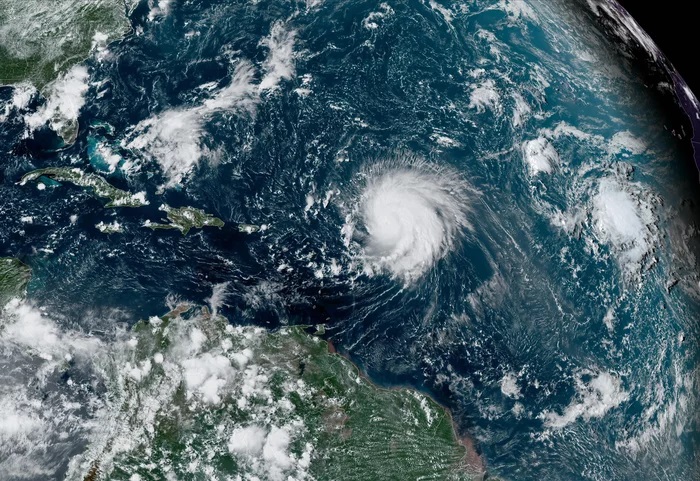
You don’t have to be a meteorologist to know that last summer was really hot. Many parts of the U.S. sweltered through blistering temperatures.
- Cities from Chicago to New York to Washington were also blanketed in smoke from Canadian wildfires, setting records for bad air quality .
- In the Florida Keys, the ocean reached hot tub temperatures .
- And perhaps nowhere had it worse than Phoenix, which hit 110 degrees on 31 consecutive days .
Cities from Chicago to New York to Washington were also blanketed in smoke from Canadian wildfires, setting records for bad air quality .
2023 was the hottest year on record for many places in the U.S., and by far the hottest year for the planet as a whole.
But we’re likely to see even hotter summers coming, with even more temperature records broken, says Karin Gleason with NOAA’s National Centers for Environmental Information.
“We are at record levels for 11 consecutive months now – so since last June through April,” she said. “And we’re still counting, of course.”
It’s already been so hot that 2024 is guaranteed to be one of the five hottest years ever recorded. As another sweltering summer approaches, the potential for climate-fueled disaster comes with it.
More frequent, stronger hurricanes
One hint that has scientists predicting we’re in for a hot summer: abnormally high ocean temperatures, especially in the Atlantic.
A hot Atlantic can also mean more hurricanes — and the forecast for the season, which starts June 1, is out. The National Hurricane Center predicts between 17 and 25 storms in the Atlantic this year. At least eight of them are expected to be full-blown hurricanes.
NOAA Administrator Rick Spinrad says this hurricane season is going to be extraordinary, adding: “The forecast is the highest NOAA has ever issued for the May outlook.”
Gavin Schmidt, a climate scientist at NASA, says human-caused climate change is the main cause for off-the-charts heat in the Atlantic.
Along with warm ocean temperatures, wind conditions have been favorable to hurricane formation: vertical winds in the Atlantic are less likely to tear apart storms as they form.
The hyperactive storm forecast spells danger for tens of millions of people living in the eastern half of the U.S.
“Remember it only takes one storm to devastate a community,” Spinrad says. “And it’s prudent to prepare now because once a storm is headed your way, it all happens so rapidly you won’t have the time to plan and prepare at that point.”
Hotter weather can mean more destructive fire seasons
Following last year’s sweltering summer, parts of the U.S. also saw a very dry winter due to the El Niño climate pattern , which can increase fear of wildfires.
That’s putting fire managers in the West on edge, because roughly a quarter of federal wildland firefighter jobs are vacant.
“I know more people that are looking for a way out than are looking for a way in,” says Lucas Mayfield, who runs the advocacy group Grassroots Wildland Firefighters.
He says, in some national forests, the job vacancy rate is far higher than 25%; and he is particularly troubled that experienced squad leaders are leaving.
The cost of living in the West is partially responsible for the labor shortage, but the demands of the job are getting more intense as climate change makes fires more dangerous.
“Those of us who are in the profession are in it for a reason,” says fire manager Grant Beebe. “But we shouldn’t expect people to sacrifice their health, their mental health, their families to do this job, right?”
President Joe Biden enacted a temporary pay bump for firefighters in 2021, and now there is pressure on Congress to pass a stalled bill that would make that bump permanent.
This episode of Consider This from NPR was produced by Connor Donevan and Tyler Bartlam. It was edited by Courtney Dorning, Rachel Waldholz and Eric Whitney. Our executive producer is Sami Yenigun.
NPR National News
Related articles more from author, downtown anchorage is getting a protected bike lane for the summer, could alaska once again be home to woolly mammoths this reporter had to find out., southcentral foundation breaks ground on new behavioral health center in anchorage.

One America News Network
Memorial day 2024: meaning & traditions.
OAN’s Cameron Walker 1:45 PM –Monday, May 27, 2024
Memorial Day is a day to pause and reflect on those who made the ultimate sacrifice for our freedom and country. One America’s Cameron Walker has more.
Share this post!
Thank you for visiting nature.com. You are using a browser version with limited support for CSS. To obtain the best experience, we recommend you use a more up to date browser (or turn off compatibility mode in Internet Explorer). In the meantime, to ensure continued support, we are displaying the site without styles and JavaScript.
- View all journals
- Explore content
- About the journal
- Publish with us
- Sign up for alerts
- NEWS EXPLAINER
- 22 May 2024
Singapore Airlines turbulence: why climate change is making flights rougher
- Carissa Wong 0
Carissa Wong is a science journalist in London.
You can also search for this author in PubMed Google Scholar
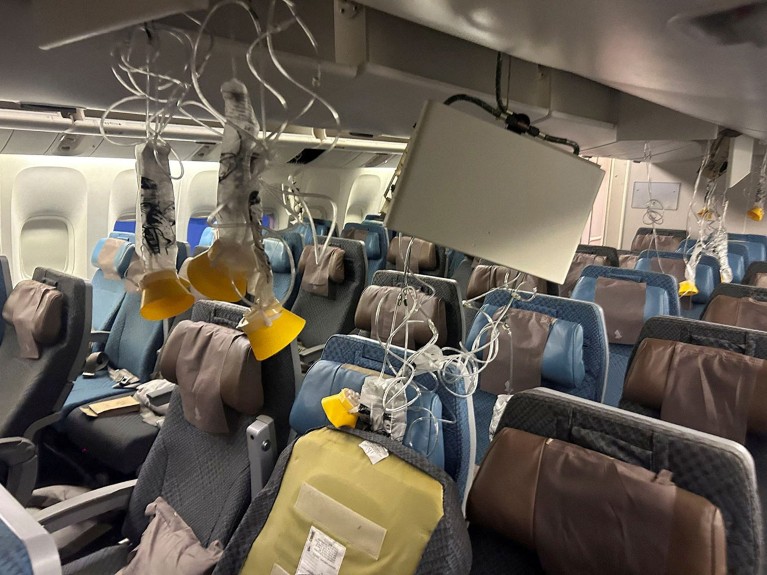
Emergency masks were deployed during the Singapore Airlines flight that experienced severe turbulence this week, killing one man. Credit: Reuters
Severe turbulence on a Singapore Airlines flight from London to Singapore has left a 73-year-old man dead and injured more than 70 people. The incident, although rare, is raising questions about what caused such a serious disruption to the flight — and whether climate change will make the strength and frequency of turbulence on planes worse.
The plane, which departed on 20 May, experienced a sudden drop of around more than 1,800 metres that launched people and objects towards the cabin roof. It is the airline’s first fatal incident in 24 years.
“Severe turbulence is the one that turns you into a projectile,” says atmospheric researcher Paul Williams at Reading University, UK. “For anyone not wearing a seatbelt it would have been a bit like being on a rollercoaster without any restraint in place — it would have been terrifying,” he says.
Nature looks at the science of air turbulence and how climate change will influence it.
What causes turbulence in aeroplanes?
Most flights experience some level of turbulence. Near the ground, strong winds around the airport can cause turbulence as planes take off or land. At higher altitudes, up- and downwards flows of air in storm clouds can cause mild to severe turbulence as planes fly through or near them. “Nobody likes flying through a storm,” says Williams.
Air flows that move upwards over mountain ranges can also create turbulence. “As the air blows over the mountain, the plane gets lifted up and can become turbulent,” says Williams. Moreover, turbulence often occurs on the edges of jet streams, which are strong air currents that circle the globe. Any turbulence that occurs outside of clouds is called “clear air” turbulence. It could take weeks to establish what kind of turbulence caused the Singapore Airlines incident, says Williams. “Provisionally, there was a storm nearby, but also the conditions were right for clear air turbulence — we need to do some more digging before we can say,” he says.

Damage in the galley of the Singapore Airlines Boeing 777 aeroplane. Credit: Reuters
Is climate change making turbulence worse and more frequent?
Climate change is making turbulence more frequent and severe, says atmospheric researcher Jung-Hoon Kim at Seoul National University.
In a study published last year 1 , Williams and his colleagues found large increases in clear-air turbulence between 1979 and 2020. Over the North Atlantic, severe clear-air turbulence — which is stronger than Earth’s gravity — became 55% more frequent. There were similar increases in turbulence all over the world, he says. The increase is almost certainly the result of climate change, which is strengthening the jet streams that cause turbulence, says Williams. “We already know it’s having an impact,” he says.
In another study 2 , Williams and his colleagues used a climate model to predict that clear-air turbulence would become more severe and frequent as the climate warms. The researchers estimated that severe turbulence would increase in frequency more than light or moderate levels of turbulence. In line with this, Kim and his colleagues found that clear-air turbulence around clouds and mountains would become more frequent with climate change, in a study published last year.
Despite the probable rise in turbulence, most flights will carry on as they do now — with light or mild turbulence, says Williams. “It is not that we’ll have to stop flying, or planes will start falling out of the sky,” says Williams. “I’m just saying that for every 10 minutes, you’ve spent in severe turbulence in the past, it could be 20 or 30 minutes in the future,” says Williams.
Can we predict and prevent bad turbulence?
Pilots use turbulence projections to plan flight paths. Researchers at weather centres can predict turbulence based on data collected from ground-based sensors and satellites and communicate predictions to pilots. On the plane, pilots use radar to identify storm clouds to avoid. This relies on radiowaves being sent out from the aircraft, which are then reflected back towards sensors that map out the surrounding area.
But radar cannot detect cloudless clear air turbulence. Another technology called LiDAR could help, says Williams. “LiDAR is similar to radar but uses a different wavelength of light,” says Williams, “Unfortunately it’s expensive, and requires a big heavy box, but it can see invisible clear air turbulence.” If the box can be miniaturised and the cost comes down, it could soon be used, he says. “I’ve seen some experimental flights, and you can indeed see clear air turbulence 20 miles, for example, ahead of the aircraft,” he says.
Until then, “I hope that everybody when they travel, please fasten your seat belts,” says Kim.
doi: https://doi.org/10.1038/d41586-024-01542-2
Prosser, M. C., Williams, P. D., Marlton, G. J. & Harrison, R. G. Geophys. Res. Lett. 50 , e2023GL103814 (2023).
Article Google Scholar
Storer, L. N., Williams, P. D. & Joshi, M. M. Geophys. Res. Lett . 44 , 9976–9984 (2017).
Download references
Reprints and permissions
- Climate sciences
- Climate change

Chance of heatwaves in India rising with climate change
News Explainer 29 MAY 24

Why snow is crucial for water supply — and what will happen when it becomes scarce
News & Views 29 MAY 24

Streamflow seasonality in a snow-dwindling world
Article 29 MAY 24

Nitrogen-hungry bacteria added to farm soil curb greenhouse-gas emissions
Postdoctoral and Visiting Scholar positions in Immunology, Stem Cells, and Cancer
Postdoctoral Research Fellow and Visiting Scholar positions in immunology, stem cells and cancer are immediately available at UConn in USA
Storrs Mansfield, Connecticut
University of Connecticut-Lai's Lab
Zhejiang Provincial Hospital of Chinese Medicine on Open Recruitment of Medical Talents and Postdocs
Director of Clinical Department, Professor, Researcher, Post-doctor
Hangzhou, Zhejiang, China
The First Affiliated Hospital of Zhejiang Chinese Medical University
Postdoc in Biomechanical Engineering (m/f/d)
The Muskuloskelettales Universitätszentrum München (MUM) on the Campus Großhadern invites applications for the department Orthopädie
Munich (Stadt), Bayern (DE)
PWG-LMU Klinikum
Assistant, Associate or Full Professor
The McLaughlin Research Institute and Touro University – Montana campus invite applications for open rank faculty positions.
McLaughlin Research Institute
Postdoctoral Associate- Neuroscience
Houston, Texas (US)
Baylor College of Medicine (BCM)
Sign up for the Nature Briefing newsletter — what matters in science, free to your inbox daily.
Quick links
- Explore articles by subject
- Guide to authors
- Editorial policies

IMAGES
VIDEO
COMMENTS
As such a power boat, and by extension all sailboats, MUST, without question show one green light on the starboard bow and one red light on the port bow and one all around white light or lights while operating in reduced visibility. These lights should shine at all 360 degrees of visibility with the bow lights shining at an angle of dead ahead ...
On any vessel, navigation lights have a specific color, (white, red, green, yellow, blue), arc of illumination, range of visibility, and location, as required by law and regulations. For the purposes of this course, we will concentrate on pleasure boats under 65 feet in length. Knowledge of navigation lights is important to a small-boat skipper ...
For most small vessels, motoring requires red and green (port and starboard) lights, and a white light visible in all directions around the boat. This is almost always a stern light and a masthead light on sailboats. Boats under sail require port and starboard lights, and a white stern light. Sailboats below sixty-five feet may show a tricolor ...
Vessel length: 12 meters to 20 meters (39.4 FT. to 65.6 FT.) Lighting requirement: A white masthead light located at the front of the boat, pointing in the direction you are traveling. This must be visible at 225 degrees and from two miles away. The masthead light must be positioned at least 8 feet above the gunnel.
The starboard side light is green. When looking at the boat's transom or stern, a white light may be visible. Keep in mind large boats and ships may use other colors, like yellow. Next time you're boating at night, say thanks to your navigation lights. They allow you to see other boaters in the dark and help prevent collisions.
Powerboat under 23 feet (7m) Powerboats under 23 feet are required to have the following navigation lights displayed: One white masthead light visible for 2 miles. One red & green sidelight visible for 1 mile. One stern light visible for 2 miles. One white, red, green, or yellow all-round light visible for 2 miles.
Stern Light: This is a white light that is visible from behind a vessel. Masthead Light: This is another white light. It is visible from the front and the sides. Any boat that has a motor is required to have a masthead light. If you have a boat that is below 39.4 feet it can be combined with the stern light.
Sternlight. means a white light placed as nearly as practicable at the stern showing an unbroken light over an arc of the horizon of 135° and so fixed as to show the light 67.5° from right aft on each side of the vessel. Towing light. means a yellow light having the same characteristics as the sternlight.
Powerboats that are less than 12m (39.4') may substitute a single all-round light for separate stern and masthead lights. Powerboats and sailboats under power that are less than 20m (65.7') can substitute a single bi-color light for sidelights. Sailboats When Under Sail. The basic rule is that sidelights and a stern light are required.
Powered boats under 39.4 feet: One all-around white light, visible from all directions (360 degrees) from two nautical miles away. This light must be attached at least 39 inches above the sidelights. One green starboard and one red port sidelight, visible across 112.5 degrees from one nautical mile away.
Stern light. A white light mounted as close to the stern as possible and shines dead ahead in an arc of 135° (67.5° to each side). The mounting height should be aligned to the height of the side lights and should never be higher. 3. Three-colour light for sailing vessels (sailing lights) On sail boats up to a length of 20 m, the side light ...
Common Navigation Lights. Navigation lights help you and other boaters determine which is the give-way vessel when encountering each other at night. These lights must be displayed from sunset to sunrise and during periods of restricted visibility, such as fog. There are four common navigation lights. Sidelights: These red and green lights are ...
Boat Navigation Light Regulations. Several rules and specifications are related to the type, size, layout, arc, and distance of visibility of boat navigation lights used by all vessel types which are collectively known as the International Regulations for Preventing Collisions at Sea or COLREGs.The navigational lights used are known as 'COLREG lights and shapes.
You'll see this light being displayed on a sailboat that's either docked or at anchor. Towing Light. The towing light is a static yellow light that sits at the same position as the sternlight and displays at an arc of 135 degrees aft the vessel. As the name suggests, this light indicates to other vessels that it's currently towing an object.
All-around white light - 360 degrees visable from two miles. Sidelights — 112.5 degrees visible from one mile. If your boat is greater than 39.4 feet but less than 65.6 feet, or 20 meters, you need the following set of navigation lights: A masthead light is a white light at the front of the boat. The masthead light needs to be visible across ...
Starboard Light: The green light is placed on the starboard side (right side when facing forward). It should be visible from a vessel approaching from the starboard side. Stern Light: The white light at the stern should be positioned to be visible from any direction behind the boat. Masthead Light: This white light is located at the top of the ...
Colored lights are always sidelights and the different color indicates the side. Red lights are located portside, and green are starboard. The lights shine from dead ahead to 112.5º aft on either side of the vessel. On some boats, sidelights can be combined into one bicolor light. For boats less than 39.4 feet, the visible range should be 1 ...
Powerboats up to 20 meters - Side lights, masthead, and stern lights are all required as listed above; side and stern lights must be visible to two nautical miles and masthead lights to three nautical miles. Sailboats up to 20 meter - Must show side lights and a white stern light or tricolored masthead light as listed above; all must be ...
Generally, all boats will have a red light on their port side and a green light on their starboard side. To put it in plain English, if you're in the driver's seat, the red light goes on the left, and the green light goes on the right. A white light should be at the stern of the boat. The stern is the rear of the boat.
Power boats less than 20 meters shall exhibit navigation lights as shown in Figure 1. (Note: 2 masthead lights are optional for vessels under 50 meters. Vessels over 50 meters will display two masthead lights.) Figure 2. Vessels of less than 12 meters in length, may show the lights in either Figure 1 or Figure 2.
Here is a sailing vessel under sail using a tricolored light. There is no forward-facing white light, like in the upper picture, so we know it is under sail. To clarify, on a sailboat less than 50 meters in length, a white under power mast head light can be just up the mast anywhere. That is to say that it's not part of the tri color.
Light Rules are covered under the Navigation Light Equipment section. The Rules of the Road are published by the U. S. Government Printing Office, and are available in any boating supply stores. Every boat owner should have a copy, but they are mandatory to be kept on vessels over 12 meters (39.4 feet) in length.
Powerboat Underway. Vessels up to 7m long with maximum speed of 7 knots must have: An all-round white light. (If possible) Separate or combined sidelights. Vessels from 7m to 12m long, or if the vessel can travel at a speed faster than 7 knots, must have: An all-round white light OR masthead light and stern light. Separate or combined side lights.
The Florida Fish and Wildlife Conservation Commission was tasked with investigating the boat crash. Broward Sheriff's Office deputies were also at the scene. Location
1 of 3 | . This undated photo provided by the University of Michigan College of Engineering shows vehicles as they drive through the Old Woodward Avenue and East Maple signalized intersection, which was retimed using the Optimized Signal as a Service (OSaaS), in Birmingham, Mich. Smarter vehicles could mean some of the most dramatic changes for the traditional traffic signal since the yellow ...
The heat index is calculated based on shade and light wind. If you're in the sun, it could be up to 15 degrees higher. With worst hurricane season forecast, insurance industry supplies some rare ...
Hotter weather can mean more destructive fire seasons Following last year's sweltering summer, parts of the U.S. also saw a very dry winter due to the El Niño climate pattern , which can ...
Stargazers are in for a treat this week: The full moon returns for its May engagement, peaking on Thursday morning. May's full moon is known as the flower moon, a reference to its appearance in ...
Memorial Day is a day to pause and reflect on those who made the ultimate sacrifice for our freedom and country. One America's Cameron Walker has more.
Warming temperatures are likely to mean that more of your plane ride will have rocky conditions, creating potentially dangerous situations.